
Magazine Winter 2023 VOLUME 86 | NO. 1
 Cow Pond on a fall evening
Photo by junior Emily Tang
Cow Pond on a fall evening
Photo by junior Emily Tang

loomischaffee.org 1

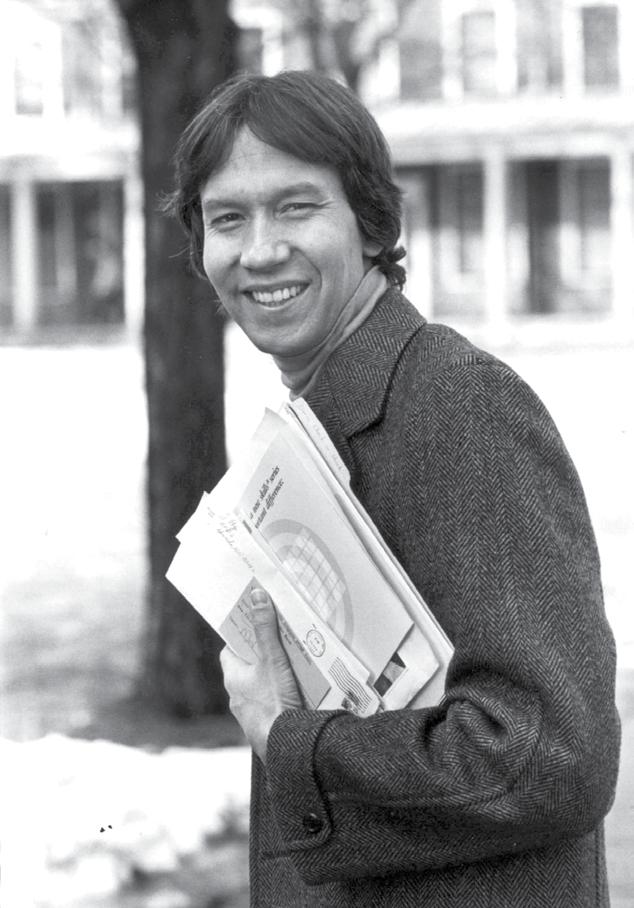

2 Loomis Chaffee Magazine Winter 2023 14
Cover: Associate Head of School for External Relations Nat Follansbee stands in front of the Loomis Homestead, one of Nat’s favorite spots on campus. Nearly 48 years after he began working as an English teacher at Loomis Chaffee, he will retire in June.
26 36
Photo by Catherine Johanna Photography.
Looking Back Across 48 Years
He taught and coached them when they were Loomis Chaffee students, and now they are his longtime colleagues. Associate Head of School for External Relations Nat Follansbee and four alumni faculty members sit down for a roundtable discussion of their history together.
More Fully Human
Teams of student and faculty researchers are working to trace and tell the life stories of 19 people who were enslaved by the Chaffee, Loomis, and Hayden families.
Faculty Desks: Mark Zunino
EDITORIAL & DESIGN TEAM
Lynn A. Petrillo ’86
Director of Strategic Communications & Marketing
Becky Purdy
Managing Editor
Kelley Albert
Senior Graphic Designer
Christine Coyle
Obituaries Editor
CONTRIBUTORS
Matt Ruffle
John Cunningham
Mary Coleman Forrester
Paige Abrams
Jeff Otterbein
Heidi E.V. McCann ’93
Lisa Salinetti Ross
Deidre Swords
PHOTOGRAPHY
Defining Studios, Loomis Chaffee Archives, John Groo, Jessica Ravenelle, Michael Howard, Makhala Huggins, John Cunningham, Mary Coleman Forrester, Google Art Project, Marley Matlack, Jeff Otterbein, Kelley Albert, Lynn Petrillo, Dan Corjulo, Stan Godlewski, Catherine Johanna Photography, Cassandra Hamer, Nicole Bushey, senior Kaylie Tan, Eric LaForest, and William M. Rittase
Visit Loomis Chaffee online at www.loomischaffee.org for the latest school news, sports scores, and galleries of recent photos. You also will find direct links to all of our social networking communities. For an online version of the magazine, go to www.loomischaffee.org/magazine.
loomischaffee.org 3
Printed at Lane Press Burlington, VT Printed on Sterling Ultra Matte Contents Winter 2023 | Volume 86 | No. 1 26 36 43 FEATURES
eclectic daily life of Mark Zunino, a visual arts teacher and artist, manifests itself in objects on and around
workspace. DEPARTMENTS 4 From the Head 5 Island News 21 Faculty & Staff News 22 Pelican Sports 44 Object Lesson 47 News from the Alumni/Development Office 52 Obituaries 64 Reflections SUBMISSIONS/STORIES & NEWS Alumni may contribute items of interest to: Loomis Chaffee Editors The Loomis Chaffee School • 4 Batchelder Rd • Windsor, CT 06095 860.687.6811 • magazine@loomis.org facebook.com/loomischaffee twitter.com/loomischaffee instagram.com/loomischaffee
The
his
Financial Literacy Preparation for Life
by Sheila Culbert
About 10 years ago, I began having conversations with John and Sally Pearse about financial literacy and our students. John graduated from Loomis and Sally from Chaffee both in 1958. They had known each other since kindergarten—theirs is one of those delightful long-term relationships! Both of their children attended Loomis Chaffee as did their three grandchildren. Over the years they have been generous donors to the school, including being the lead donors to the Pearse Hub for Innovation (PHI), the Pearse Technology Classroom, and the Pearse Mathematics Classroom. Financial literacy, however, has always been a passion project for them. They have worried that we have not been doing enough as a school to prepare our students for the real world, and, in particular, they have thought that we have not been giving students the kind of background in financial literacy that they will need.
The costs of financial illiteracy are immense. According to the Federal Reserve’s annual report on “The Economic Well-being of U.S. Households in 2021,” almost half of Americans live paycheck to paycheck and about 40 percent cannot cover a $400 emergency expense. Twenty percent of Americans had experienced an unexpected medical emergency in the previous year, with the median cost between $1,000 and $2,000. Thirty percent of all adults had some college debt, with the average graduate owing approximately $30,000, and about $4,000 in credit card debt. Finally, white families owned five to six times more in household wealth than Black families—a ratio that has changed very little over the past several decades because of intergenerational wealth.*
There is little doubt that our students would benefit from a more robust curriculum in financial literacy. What is a credit card, and
what is the difference between a credit card and a debit card? What is a credit rating, and how do I protect my rating? How do I live within my financial means? How much can I spend on Uber Eats each week? (I often hear from parents that their children are spending way too much on food deliveries!) How does financial aid work? Should I take out loans to pay for my education? How much will I have to earn annually in my future profession to handle my college debt? These are all questions that Loomis students need to start to understand now and even more so when they get to college.
While John and Sally were pushing for Loomis Chaffee to do more to educate our students about these topics, a young faculty member, Mat DeNunzio, joined the school in 2018 to teach economics and had an equal passion for teaching financial literacy. Mat started by incorporating sections on financial literacy into his economics courses, as well as bringing a series of alumni speakers in to address students. Speakers included seasoned professionals in a variety of fields as well as young alumni either in college or just starting their professional careers. Topics covered

included personal budgeting and savings practices, investing, and credit management, as well as issues related to inequality and the racial wealth gap. Because of the work of Mat and others, students now encounter financial literacy through the ninth- and 10th-grade seminar programs, in their sophomore and senior year economics courses, and through a variety of programs offered by the Norton Family Center for the Common Good, the Center for Diversity, Equity & Inclusion, and the Dean’s Office.
Mat and his colleague in economics, Liz Leyden, also started the Stock Market Game, a very popular five-week activity that takes place during the winter term. Initially, Mat limited the game to students taking economics, but for the past couple of years, it has been open to all students. In the winter of 2021, almost 350 students participated. Students receive a virtual $1 million to invest as they set up their virtual portfolio. The 2022 winner, Chase Thompson ’22, grew his initial investment of $1 million to $7.5 million.
The happy confluence of Mat’s interests with John and Sally’s persistence that we do more has resulted in a robust and expanding program. Mat departed from the school at the end of last year to attend graduate school, but we are well positioned to build on the program that he left. The Pearses have funded a chair for a director of financial literacy, and we are currently hiring for that position with the program to be embedded in the Norton Family Center for the Common Good. We look forward to being a leader in providing a much-needed and valuable education in financial literacy to all our students.
*The Federal Reserve, “The Economic WellBeing of U.S. Households in 2021,” May 2022, https://www.federalreserve.gov/publications/ files/2021-report-economic-well-being-ushouseholds-202205.pdf
4 Loomis Chaffee Magazine Winter 2023
FROM THE HEAD

ISLAND NEWS
Sheila Culbert Extends Her Tenure as Head of School
At the request of the Board of Trustees, Head of School Sheila Culbert will extend her tenure at Loomis Chaffee by one year and will retire at the end of the 2023–24 academic year, Chair of the Board Duncan A.L. MacLean ’90 announced on December 12.
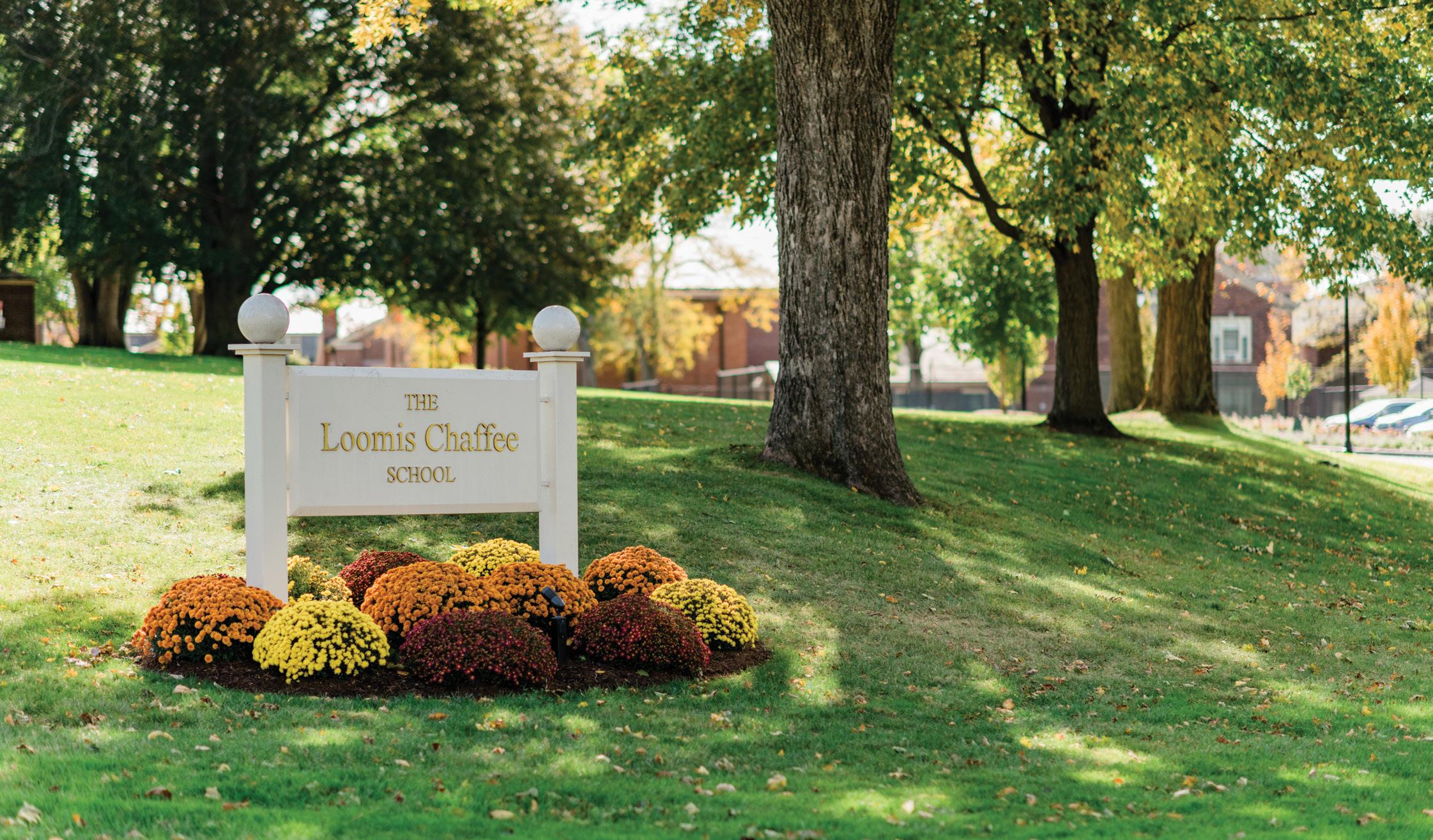
In a message to the school community, Sheila wrote that in staying one more year she hopes “to contribute to the ultimate success of Loomis Chaffee’s search for the next head of school.”
Sheila had been slated to retire at the end of June 2023. The Board’s request followed the decision by Zack Lehman, who was named Loomis Chaffee’s next head of school in August 2022 and was to assume the role in July 2023, to reconsider his appointment.
Following Mr. Lehman’s decision, the Board began a series of meetings to discuss next steps in the search for Sheila’s successor. While those conversations were expected to continue through January, by mid-December it had become clear “that the time we will need to conduct a thorough search will not enable us to name a new head of school who could assume the role by July 1, 2023, as originally planned,” Duncan shared.
“In agreeing to stay on the Island a little while longer,” continued Duncan, “Sheila has given the school the gift of the precious time we need to reopen the search to find our next head of school.”
When this magazine went to press, the Board was aiming to finalize the plan for the reopened search at the late January Board meeting, after which Duncan would
write again to the school community with details about next steps.
“The good news is Loomis Chaffee is moving forward from a position of strength, which has been exhibited by our full community in recent weeks,” said Duncan. “While we didn’t expect to find ourselves in this situation following this past year’s search, the Board knows that the school will find the right person to continue the legacy of excellence that Sheila and her predecessors have established and stewarded for more than 100 years.”
“As I look ahead to the coming 18 months,” Sheila wrote, “I am excited about the continued collaboration with faculty, staff, parents, alumni, and Trustees as together we strive to offer our students the best educational experience possible.”
6 Loomis Chaffee Magazine Winter 2023
ISLAND NEWS
Author of All-School Read Speaks about Empathy
Chinelo Okparanta, the author of this year’s all-school read, Under the Udala Trees, visited the Island in September, delivering an impassioned convocation address to students, faculty, and staff gathered in the Olcott Center.



Through stories of her own life as a young immigrant from Nigeria and her experiences as a high school student, Ms. Okparanta emphasized the power of empathy, this year’s schoolwide theme, and the importance of reflection in creating art and in fostering understanding in the world.
“Empathy is learned,” she said. “We learn empathy by learning the ways that we want to be treated and deserve to be respected and by treating others with that same respect.”
Ms. Okparanta told the audience that she learned about the power of empathy from her high school French teacher, whose compassion and understanding influenced her personally and led to Ms. Okparanta’s later decision to become a writer. “Sometimes we need someone else to show us our own value and worth,” she said. “If they are able to see themselves in us, they will also be able to help us see our own strengths.”
Connecting with other people’s experiences is essential to creating art, in Ms. Okparanta’s view. “As a writer ... I must take the time to listen to and hear and empathize with the plights of real-life individuals in order to be able to create good, moving, meaningful art,” she said. “Any form of art that strives, at its core, to encourage empathy would do well to encourage people to spend more time thinking than talking.”
“Any form of art that strives, at its core, to encourage empathy would do well to encourage people to spend more time thinking than talking.”
The author also urged the audience to think about the actions they take in their own lives. “The first step to positive change is thoughtful reflection,” she said.
After the convocation, Ms. Okparanta met with College-Level English and Creative
Writing classes and held a lunchtime discussion with other members of the community.
Ms. Okparanta is the author of two novels and a short story collection. She has won the Lambda Literary Award twice, the Jessie Remon Fauset Book Award in Fiction, the inaugural Betty Berzon Emerging Writer Award from the Publishing Triangle, and an O. Henry Prize for short fiction. She has published work in The New Yorker, Granta, Tin House, and the Kenyon Review, among other literary publications, and was named one of Granta’s six “New Voices” for 2012. Her second novel, Harry Sylvester Bird, was published last summer.
An associate professor of English and the director of the Program in Creative Writing at Swarthmore College, Ms. Okparanta is a graduate of Penn State University, Rutgers, and the Iowa Writer’s School, where she earned a master of fine arts in writing.
Ms. Okparanta’s visit to campus was part of the Hubbard Speakers Series, made possible by a gift from Robert P. Hubbard ’47.
loomischaffee.org 7
ISLAND NEWS
Right: Chinelo Okparanta addresses students, faculty, and staff in the Olcott Center.
Optimism, Hope, and Community Greet the New School Year
The relative quiet of summer gave way to friendly shouts and hugs of recognition as the Island welcomed 740 new and returning students for opening activities for the 2022–23 school year, culminating with the first day of classes and a convocation on September 1.

The activities began in late August with the arrival of preseason football players, resident assistants, and prefects and continued with other fall preseason sports training, faculty preparations, dorm move-ins, programs welcoming new students and their families, and reconnections of friends, classmates, teammates, and colleagues.
New families enjoyed a reception organized by the Loomis Chaffee Parents Association, and new students began orientation activities while their parents attended informational programs. New students and their parents met faculty advisors, and Head of School Sheila Culbert spoke with parents before families said their goodbyes. New student orientation programs continued Wednesday while returning students arrived on campus and settled in.
At the year’s opening convocation, Student Council officers, Sheila, and Associate Head of School Webb Trenchard welcomed the full student body with humor, guidance, and advice for the year ahead.
Seniors Kirsten Lees and Anthony Liu, the Student Council president and vice president, welcomed new and returning students and offered advice to their peers during their opening remarks. Describing Loomis as a place of infinite possibility, Anthony urged students to take advantage of both the educational and social opportunities that the school offers. Kirsten gave practical and aspirational advice to the assembled students, including urging them to continue to be “proactive in addressing injustices within and beyond our community.”
Sheila spoke of the optimism and hope that the beginning of a new school year brings to
“You are all now members of the Loomis Chaffee community. With that membership comes a set of obligations and responsibilities and a commitment to a set of core values: academic excellence, freedom of expression, respect for others, honesty, integrity, and the embrace of diversity in all its forms.”
— HEAD OF SCHOOL SHEILA CULBERT
a learning community. “You are all now members of the Loomis Chaffee community,” she added. “With that membership comes a set of obligations and responsibilities and a commitment to a set of core values: academic excellence, freedom of expression, respect for others, honesty, integrity, and the embrace of diversity in all its forms.”
The school’s “multi-faceted diversity” makes Loomis Chaffee a great place to live and to learn, Sheila continued. “It is the exploration of our differences that is at the core of a liberal arts education,” she said, urging students to lean into those conversations, listen respectfully to other viewpoints,
examine multiple perspectives, and try to reach consensus. “Our democracy rests on the very idea that civic-minded people can disagree with one another on fundamental issues but can come together to work out their differences in the interest of society,” she said.
Webb closed the assembly by introducing this year’s schoolwide theme of empathy, defining the term and sharing examples of empathy through the words of Emily Dickinson, the Dalai Llama, and Maya Angelou.
8 Loomis Chaffee Magazine Winter 2023
ISLAND NEWS
Above: Prefect Chelsea Ndzana-Hozo helps on move-in day in Cutler Hall.
Expert on Gerrymandering Discusses Elections
Author David Daley ’88, one of the nation’s leading experts on partisan gerrymandering, visited campus in October to discuss elections and his latest book, Unrigged: How Americans Are Battling Back to Save Democracy.
The conversation was moderated by seniors Ethan Leshem, Sam Tishler, and Ignacio Feged, members of the Shultz Fellowship, a non-partisan student group that promotes and models civil discourse on campus. Sam and Ignacio are co-presidents of the group.

During the forum, David discussed the history of gerrymandering and how it affects voting in the United States. He offered examples
of counties and states that have found ways to fight gerrymandered districts, and he answered questions from students about the direction of the U.S. political system and the future of voting in the United States.
David also talked about his time at Loomis Chaffee, sharing memories of writing for and serving as editor-in-chief of The Log, serving as a co-president of the Political Union, and writing papers for former faculty member
Jim “Grim” Wilson in his U.S. History class. After the forum, students had an opportunity to speak further with David.
The Norton Family Center for the Common Good coordinated David’s visit as part of a series of forums on government and politics leading up to the mid-term elections.
David’s visit helped students “understand the importance of the upcoming midterm elections and ask questions of a well-known political expert,” Matt Kammrath, Keller Family Director of the Norton Center, said after the forum. Matt noted that the insights from David showed the audience “how small, local elections can impact national voting trends for decades.”
David’s visit was sponsored in part by the Hazel Thrall Sullivan ’32 Lecture Fund.
Local Government Officials Participate in Forum
State Rep. Jane Garibay and Windsor Mayor Donald Trinks discussed local government and politics with about 30 students in October as part of a series of Loomis Chaffee forums leading up to the mid-term elections.
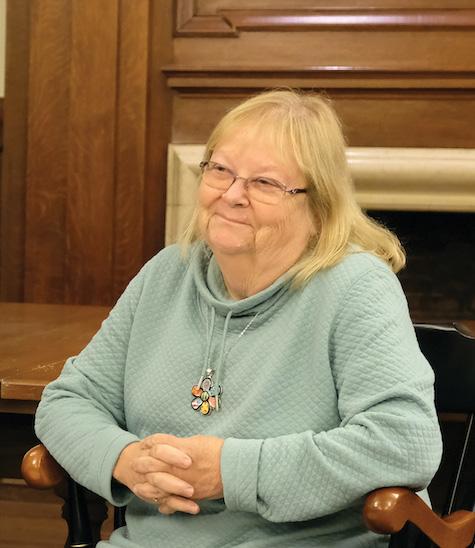
Sponsored and hosted by the Norton Family Center for the Common Good, the evening conversation touched on a range of issues, from the daily life of a local official to the challenges of building bipartisan consensus and from pedestrian safety in Windsor center to the presence of Amazon and other corporations in town.
Rep. Garibay, a Democrat whose district includes parts of Windsor and Windsor Locks, outlined some of her legislative work since she first took office in 2019. She helped to create and build support for several bills that were passed during the 2022 session by the state House of
Representatives to help the elderly, she noted. She also described funding she has worked to secure for local development.
Mayor Trinks, a Democrat who has been in office for 21 years, told students about months of negotiations with Amazon before the retail giant first located a distribution center in Windsor in 2016. The town now has two Amazon fulfillment centers, the most recent one measuring more than three million square feet, and Amazon is one of Windsor’s largest employers.

Being the town’s mayor is not all bright lights and high-stakes negotiations, he added. The job is a part-time volunteer position as the chairman of the Town Council, said Mayor Trinks, who owns Bart’s Drive-In restaurant on Palisado Avenue. “Come to Bart’s and clean the grease trap. You’ll see how glamorous a mayor’s life is,” he quipped, evoking laughter from the students.
Mayor Trinks and Rep. Garibay also answered student questions about land-use planning, development projects, the political makeup of the Town Council, and standardized testing scores of students at the town’s public schools.
loomischaffee.org 9
ISLAND NEWS
Above: Senior Shultz Fellows Sam Tishler, Ignacio Feged, and Ethan Leshem with guest speaker David Daley ’88
Above: Windsor Mayor Donald Trinks (left) and Connecticut State Rep. Jane Garibay (right)
GUEST ARTIST
Margaret Jacobs
Sculptor Margaret Jacobs worked with and among students in the Richmond Art Center as a Visiting Artist in November and exhibited her work in the Sue and Eugene Mercy Jr. Gallery.

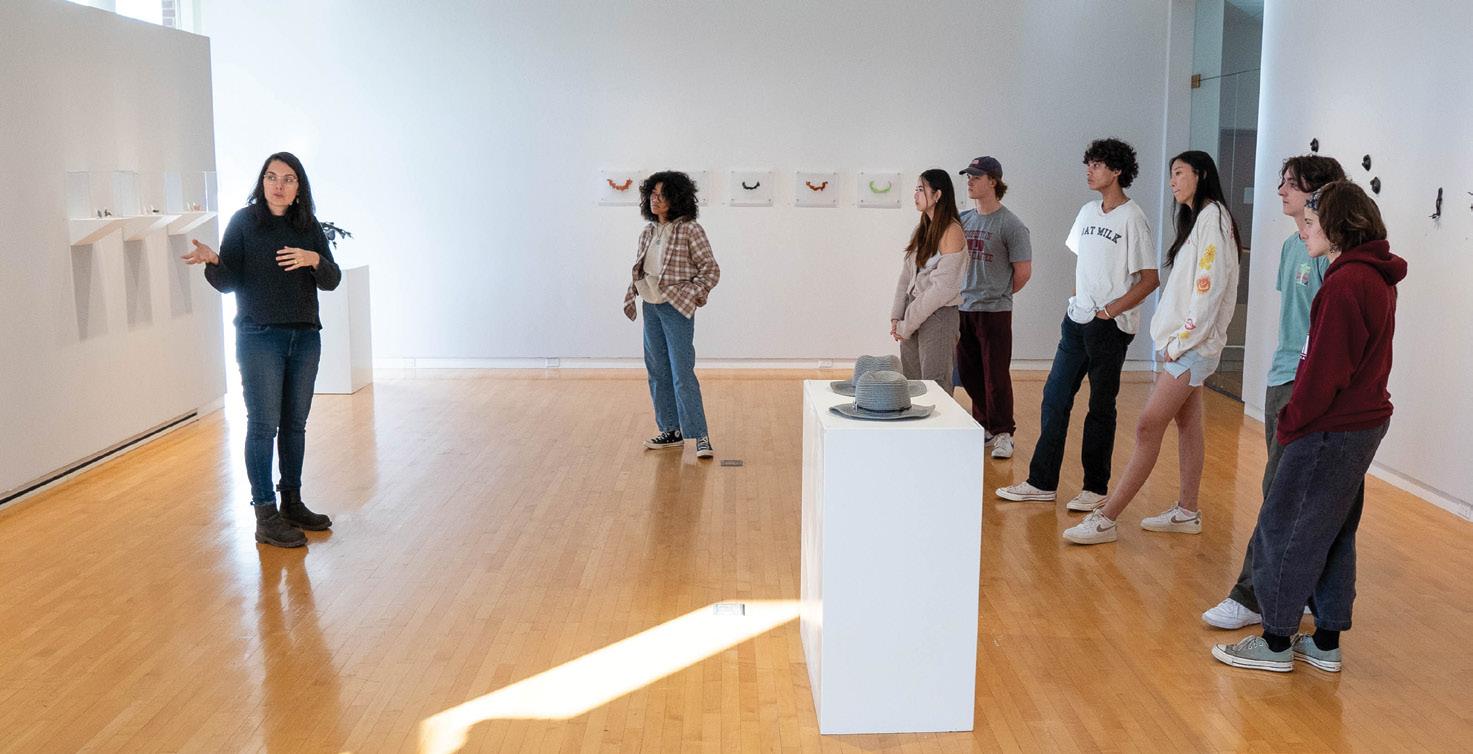
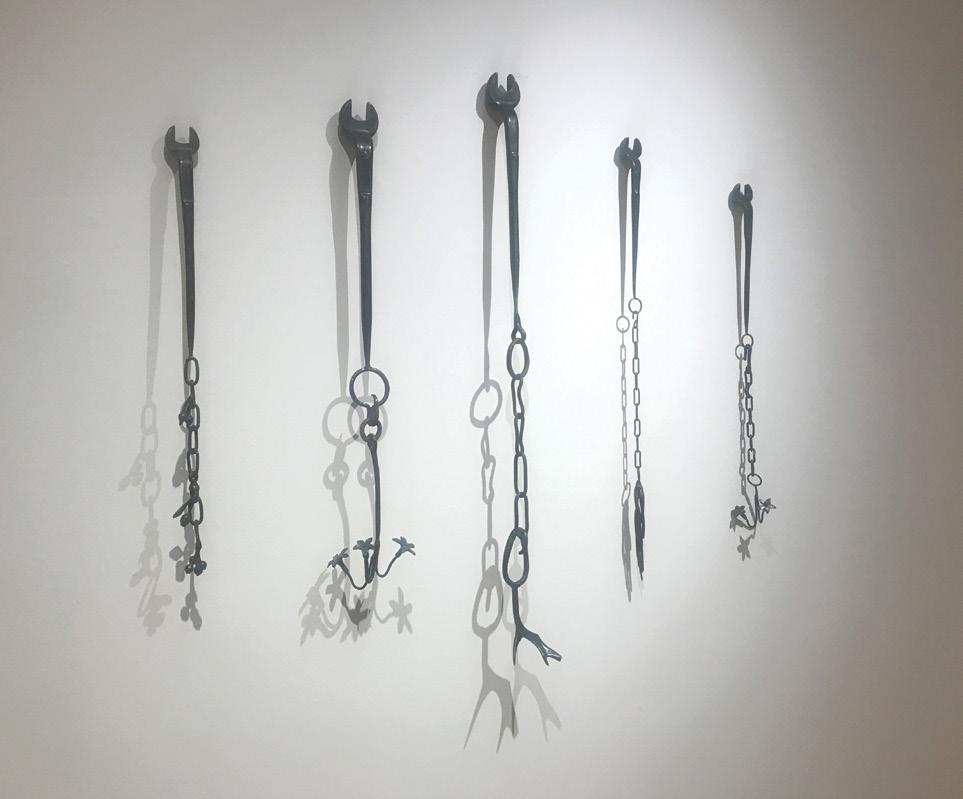

Ms. Jacobs’s exhibit, Kinship Compositions, featured steel sculptures and fine jewelry work that created visual narratives and explored the artist’s Indigenous ancestral culture as well as family and personal themes. Botanical elements and fabricated objects contributed to the layers of storytelling in each piece.
On one afternoon during her residency, Ms. Jacobs met in the gallery with students in the College-Level Art Seminar and independent study courses. After discussing and answering questions about her art, the materials she uses, her methods of creation, and the concepts behind her artwork, she led the group in a jewelry-making project in one of the studios.
Top: The artist outlines a creative exercise for students in the College-Level Art Seminar and independent studies. Middle: Ms. Jacobs, a member of the Akwasasne Mohawk tribe, describes the cultural importance of botanical forms in her sculptures. Bottom: Before the opening of Kinship Compositions in the Mercy Gallery, the artist walks through the exhibit with a group of art students and discusses her creative process.
The Adolf and Virginia Dehn Visiting Artist Program
invites artists working in a variety of styles to campus for short-term residencies, offering Loomis Chaffee students the opportunity to observe and participate in the process of an artist creating their work. In doing so, the professional artists discuss their inspirations, share techniques, and mentor students.

10 Loomis Chaffee Magazine Winter 2023 ISLAND NEWS
Above: Margaret Jacobs joins students in a jewelry-making project in the Richmond Art Center.
Maurice Moore
Maurice Moore, a visual artist, writer, and performer, spent 10 days on campus working with and alongside Loomis Chaffee students and faculty in the Richmond Art Center early in the fall term.

The artist’s residency through the Adolf and Virginia Dehn Visiting Artist Program coincided with Drawing Wit Light, an exhibition of Moore’s work, in the Sue and Eugene Mercy Jr. Gallery.
While working on campus, Moore presented an extended artist talk, where the artist spoke about their creative pursuits and answered questions from the audience of students. The presentation was jointly sponsored by the Center for Diversity, Equity & Inclusion and the Norton Family Center for the Common Good.
GUEST MUSICIANS
Moore is a doctoral performance studies candidate at the University of CaliforniaDavis, and their work has appeared in the publications Communication and Critical/ Cultural Studies, Decoded Pride, Confluence, and Mollyhouse. In addition, they have exhibited at the Centre for Recent Drawing
(C4RD) in London; Verge Center for the Arts in Sacramento, California; and the Calabar Gallery in New York City, among other venues.
Cuatro Puntos and Khaiim the RapOet
Loomis Chaffee students enjoyed a lively performance by the Cuatro Puntos Ensemble and Hartford troubadour Khaiim the RapOet (Self Suffice) during an evening of music in September in the Hubbard Performance Hall.
The ensemble and Khaiim performed a remix of music originally composed by David Macbride of Hartford. The remix was based on the piece “Coming Home: A Hartford Collage,” which was commissioned by Cuatro Puntos and originally premiered in 2018. It is described on the ensemble’s website as “a tone poem...with various sounds from around the city of Hartford.”
The Hartford-based Cuatro Puntos Ensemble includes Steve Larson on viola, Kevin Bishop on viola, Aaron Packard on violin, Annie Trépanier on violin, and Allan Ballinger on cello. The quintet collaborates with local, national, and international guest artists. Members of Cuatro Puntos also worked with Chamber Music students on campus during the day.
Khaiim the RapOet (Self Suffice) was appointed Hartford’s inaugural troubadour in October 2021 by the city of Hartford’s Cultural Commission. A graduate of Trinity College, Khaiim performs and teaches rap and poetry classes in the Hartford area.
The Guest Musicians performance was funded by the Joseph S. Stookins Lecture Fund.

loomischaffee.org 11 GUEST ARTIST ISLAND NEWS
Left: Violist Steve Larson of Cuatro Puntos leads a masterclass with Chamber Music students.
Above: Maurice Moore at the opening of the artist’s exhibit in the Mercy Gallery
Humanitarian Joins Book Chat About Her Memoir
Author Maggie Doyne joined Loomis Chaffee students for a Book Chat about her memoir, Between the Mountain and the Sky, in September.
The author participated in the discussion via Zoom from the orphanage she runs in Kopila, Nepal.

The special session with the author was part of a campus-wide Book Chat program. Over the summer, every Loomis student chose a book from a list of two dozen selections. When they returned to school in the fall, they gathered for the Book Chats, led by faculty members, with other students who had read the same book.
The Book Chat with Ms. Doyne was facilitated by librarian Kathleen Sigrist and Dean of Students Jessica Matzkin. Kathleen, who first met Ms. Doyne 10 years ago when their daughters attended school together, arranged for the author’s virtual visit.
The author answered questions about her memoir and her experience founding a nonprofit, offered advice, and spoke about her life in Nepal and the facilities and services that the BlinkNow Foundation, which she co-founded, provides to the children under the care of the orphanage.
“We set out to create a model to change this region of Nepal to make sure that children were kept safe and educated,” she said. The foundation collaborates with other nonprofits and charities to achieve its goals.
Ms. Doyne also spoke about navigating her grief after the loss of one of her adopted children in a drowning accident a few years ago. “Life is precious,” she told the gathered students. “At the end of the day, the thing that matters is loving the people in our lives.”
Ms. Doyne was named a CNN Hero of the Year in 2015 and was honored as a Forbes Top 30 under 30 Social Entrepreneur and by the Dalai Lama as an Unsung Hero of Compassion.
Teachers Collaborate
Exploring Music and Art in Nazi Germany
At lunch one day last year in the dining hall, history teacher Lauren Williams mentioned to some other faculty members that she and her students were going to look at concepts of propaganda in her Germany and the Holocaust term course.
“It just so happened that the right person was sitting there,” she recalled. That person was Netta Hadari, Loomis Chaffee’s Orchestra director. “Netta immediately jumped in and said that [this] was a particular area of interest and field of study of his. I thought: ‘He has to come to my class,’” Lauren said.
The two of them came up with a plan, and this fall Netta visited the class as the students considered propaganda surrounding Hitler’s election as chancellor in 1933.
During his visit, Netta discussed, among other things, the ways in which Hitler used more classical forms of music and art — such as the “distinctly German” orchestral pieces of Richard Wagner, “Hitler’s favorite composer” — as Nazi propaganda and how he explicitly set up the more modern forms of German expressionist art and music, which were documenting and exposing the social inequalities of the time, as “entartete” (degenerate) art, in an attempt to subjugate the societal impact of the expressionist movement. “Hitler understood the power of art,” Netta said. “Remember that he was a failed art student.”
The students viewed and compared several pieces of expressionist art to artwork from earlier periods, and they listened to a moving, atonal piece, “Madonna” by Austrian composer Arnold Schoenberg, who was Jewish and one of those deemed “entartete” by the Nazis.
Several students commented that the music was not pleasing to listen to. “I ask you to consider the difference between art and entertainment,” Netta said. “Entertainment reinforces what you know; art questions what you know. Allow your world to be shaken up by [art].”
The students gained new insights from Netta’s visit. “[I] thought his class was really interesting because we got to look at German expressionism,” reflected senior Turner Brode, “and I really enjoyed learning about the shift [from representation] into emotion expressed in art during these times.”
For Lauren, the visit also reinforced the importance of using the expertise of her colleagues to enrich her teaching and the importance of bringing in outside voices. Through a summer institute that she completed through Yale University’s Fortunoff Video Archives for Holocaust Testimonies, Lauren gained access to thousands of hours of recorded, first-hand testimonies from people who witnessed and survived the Nazi persecutions.
Lauren plans to incorporate some of the testimonies into her course. “We don’t have the same opportunities we once had to bring survivors of the Holocaust to campus given how few remain,” she said. “It’s so important for our students to hear these stories first-hand to help them understand the impact of the Holocaust.”
Above: Among the works that the students discussed was Edvard Munch’s famous “The Scream.”

12 Loomis Chaffee Magazine Winter 2023
Ariana Washington ’04 Lawyer, Video Game
Designer, and Visiting Innovator
During a two-day visit to campus in October, Visiting Innovator Ariana Washington ’04 worked with students in a variety of classes and shared the story-in-progress of her career as a lawyer and video game designer and her life since Loomis Chaffee.
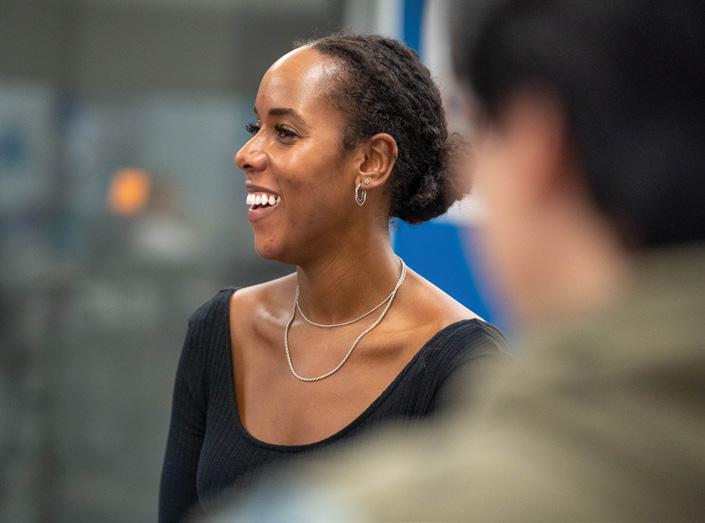
Ariana created Kyrion, an open world fantasy-adventure video game, while also working as a lawyer for Uber. Although Kyrion is not yet for sale, it has a playable demo and released its first trailer last spring as Ariana continues to advance the game’s development. She also continues to practice law, now as senior counsel at Airbnb.
While on the Island this fall, Ariana met with computer science and robotics students and worked with the Problem Solving for the Common Good class in the Pearse Hub for Innovation (PHI). She also shared meals and conversations with a variety of students and faculty, including students in the Black Alumni Mentoring program and student leaders of the multicultural group PRISM.
At an evening forum of students and faculty, she discussed her academic, personal, and
professional trajectory so far, a journey that has been fueled by both a drive to practice law and a passion for creative expression, among other influences.
After Loomis, Ariana attended Fordham University for two years then transferred to Hampton University, a historically Black
… My goals were linear, but at the same time none of my goals really represented me and who I wanted to be.” After losing her mom, she adopted a live-life-to-thefullest attitude, she said, and when she was in her third year of law school, she started screenwriting. Her love of storytelling eventually led her to create Kyrion.
Ariana encouraged students to map out a plan for their lives but to be flexible and not to be afraid to pivot. In her case, she said, practicing law doesn’t fully express her identity, but a legal career has helped her to afford to pursue video game creation simultaneously. “It’s all part of the layers of me,” she said.
college in Virginia, where she earned a bachelor’s degree in psychology and a master’s degree in education. She went on to Emory University School of Law, where she received her law degree in 2013.
Ariana’s mother had a profound influence on Ariana, and they were very close, she said. Her mother’s death while Ariana was in law school was devastating and altered Ariana’s approach to life. Until then, she said, she had “stayed on the straight and narrow.
Ariana’s visit was made possible by the Peter Hsing ’86 Fund for Innovation and Entrepreneurship. The PHI and the Center for Diversity, Equity & Inclusion helped to organize the events.
CORRECTION
In the Summer 2022 issue of Loomis Chaffee Magazine, an article titled “Outside Advantages” on page 15 misidentified an alumnus environmental writer who worked with students during Earth Week on campus last spring. He is Adam Rome ’76.
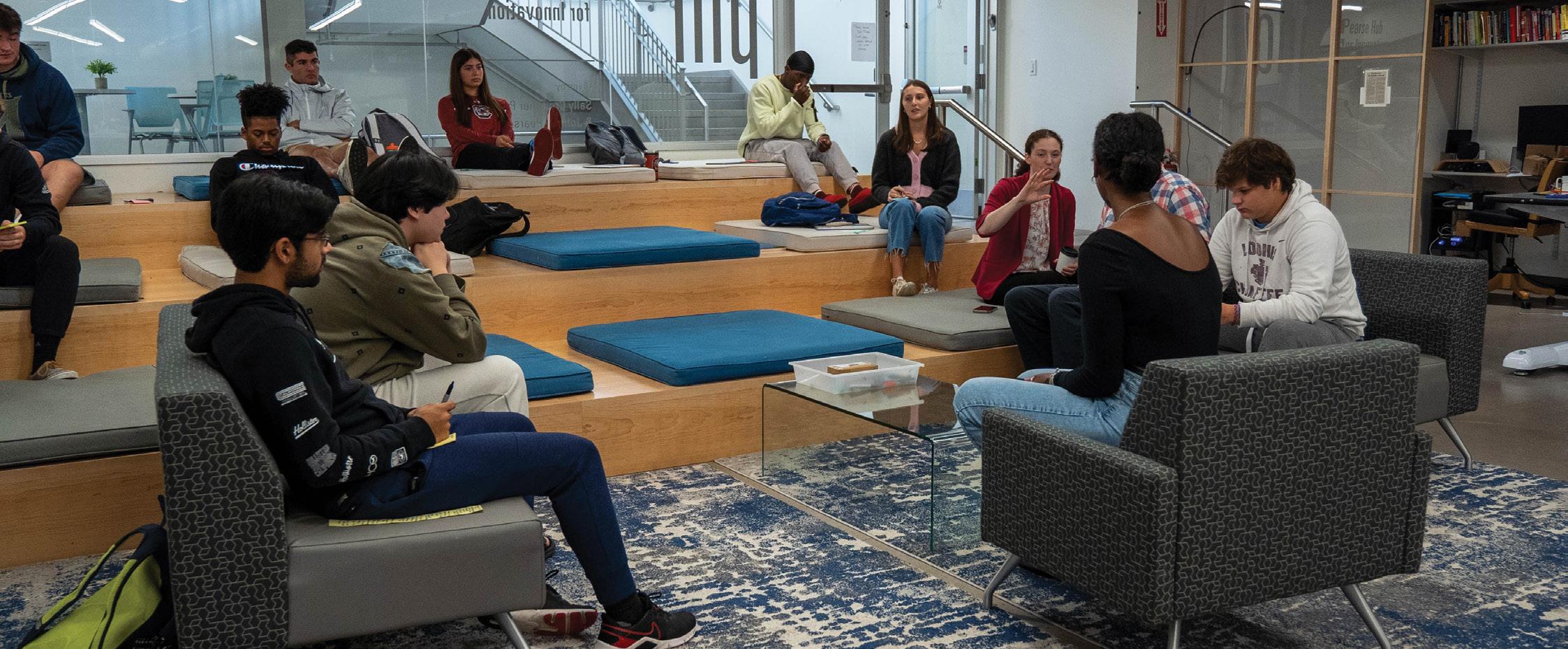
loomischaffee.org 13
ISLAND NEWS
Above: Ariana helps a class in the Pearse Hub for Innovation (PHI).
Hamlet

The play tells the story of a royal family and their courtiers caught up in a mounting tragedy of their own making.
HAMLET HAUNTS NEO STAGE
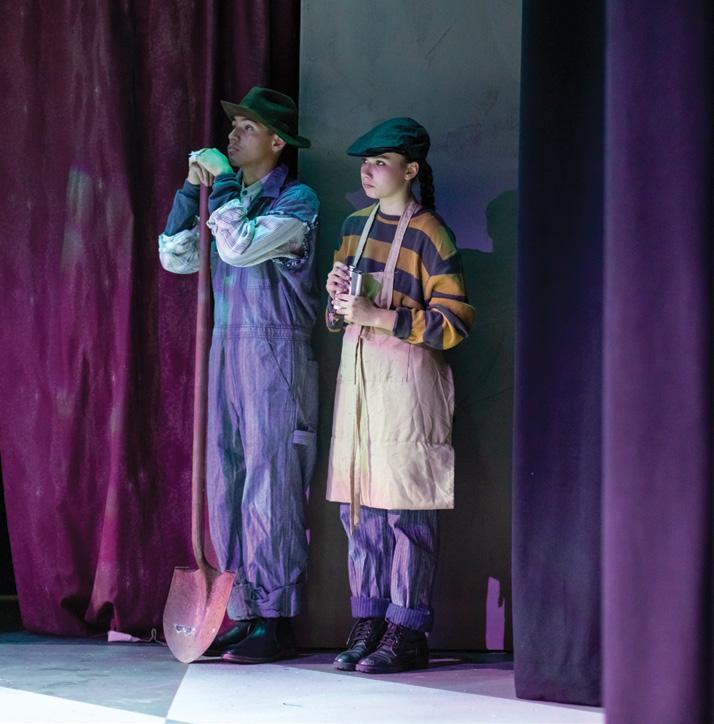

During a four-day run in early November, a Loomis Chaffee student production of the tragedy of Hamlet unfolded on the stage of the newly renovated Norris Ely Orchard Theater in front of full-house audiences. • A cast and crew of 27 students produced the show, directed by performing arts faculty member David McCamish and supported by a team of other theater professionals. • Set in the disquieting environs of a fog-shrouded castle in Denmark, the play tells the story of a royal family and their courtiers caught up in a mounting tragedy of their own making.


Opposite Page: Death scene: Hamlet (senior Jade Silverstein), Horatio (sophomore Iris Sande), and King Claudius (senior Arthur Beaugeard) Above (clockwise): Fortinbras (senior Nathan Ko) • In a performance for the royal court, Player Lucianus (senior Quinn Bernardin) talks about murdering the Player King. • Gravediggers (freshmen Evan Thomen and Sonia Barinskaya) • On their thrones, Claudius (Arthur) and Gertrude (senior Nandini Ramanathan)

loomischaffee.org 15
ISLAND NEWS
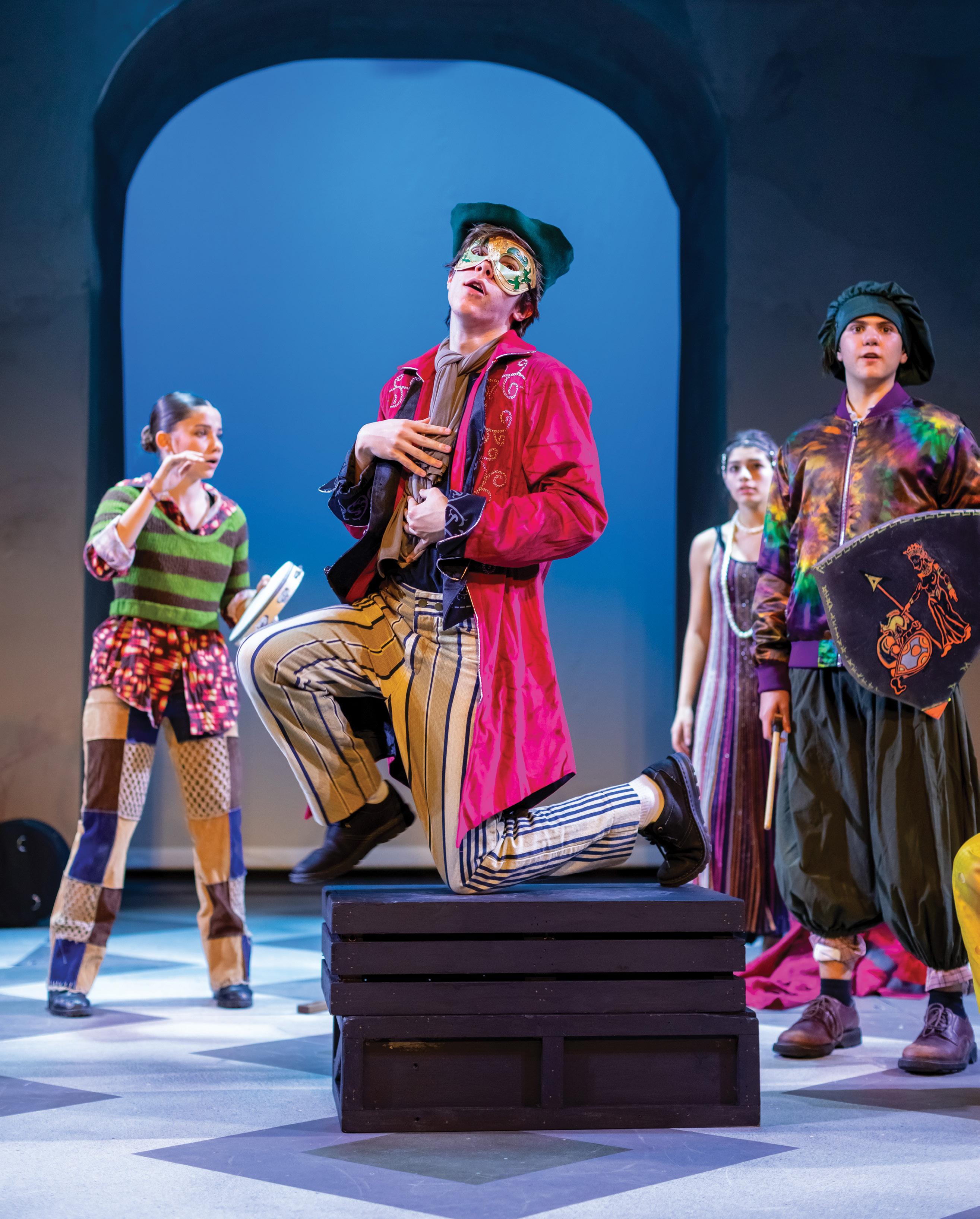
... all in the alarum and fear of death rose up, A clout upon that head, where late the diadem stood ...
The production was an adaptation of the Quarto I edition of Shakespeare’s Hamlet. The play has several variants, all credited to Shakespeare and published at different times during the early 1600s. The Quarto 1 edition is “the most radically different and concise” of the variants, David noted in the show’s playbill.

Senior Jade Silverstein played Hamlet, the charming and tormented prince who seeks revenge for his father’s murder. Senior Arthur Beaugeard portrayed Hamlet’s uncle, Claudius, the murderous usurper to the throne, and senior Nandini Ramanathan played Queen Gertrude, Hamlet’s mother and Claudius’s new wife.
Ophelia, Hamlet’s love interest who descends into madness, was portrayed hauntingly by junior Lauren Sonnenfeld, and sophomore Iris Sande played Hamlet’s devoted friend Horatio.
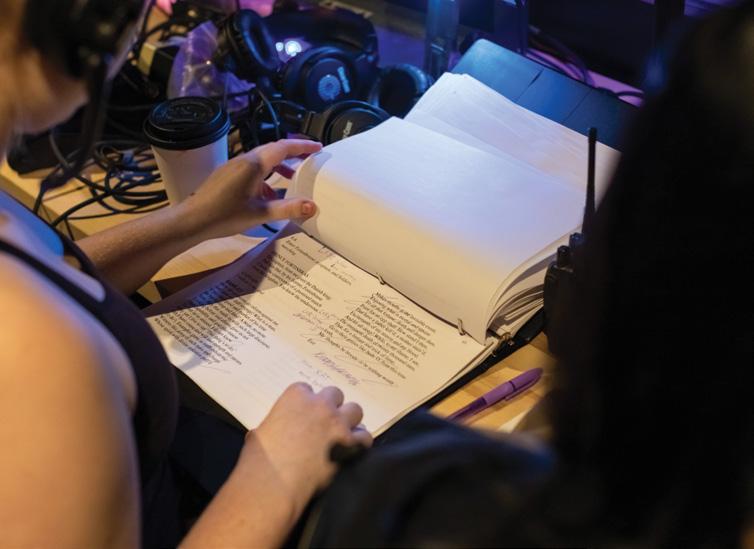

behind the scenes

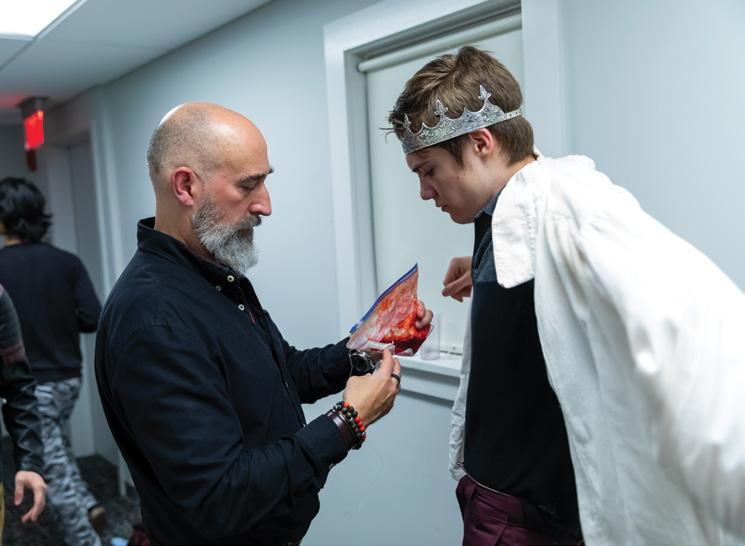 Opposite Page: The Players (freshman Sonia Barinskaya, junior Brigham Cooper, freshman Natalie Pereira, and freshman Zane Habig) perform for the court. Above (Clockwise): Director David McCamish and Arthur prepare special effects for the death scene. • Junior Cameron Rogers monitors the cues in the prompt book. • The NEO stage before the show. • In the booth, stage managers junior Sophia Li and Cameron and stage crew members sophomore Boden Bubb and junior Lily Clark run a tech rehearsal. Below: View from the booth of the curtain call during dress rehearsal
Opposite Page: The Players (freshman Sonia Barinskaya, junior Brigham Cooper, freshman Natalie Pereira, and freshman Zane Habig) perform for the court. Above (Clockwise): Director David McCamish and Arthur prepare special effects for the death scene. • Junior Cameron Rogers monitors the cues in the prompt book. • The NEO stage before the show. • In the booth, stage managers junior Sophia Li and Cameron and stage crew members sophomore Boden Bubb and junior Lily Clark run a tech rehearsal. Below: View from the booth of the curtain call during dress rehearsal
November-2022/
A gallery of photos from the production is available on SmugMug at https://loomischaffee.smugmug.com/ Events/Theater-Dance/Hamlet-
loomischaffee.org 17
(Sticky) Hands-On Learning
Amaple sugaring project that began two years ago with taps in a few trees on campus has grown into a much larger operation that this academic year includes tie-ins to academic curricula and construction of a sugar shack for boiling sap and storing equipment.
Alejandro Rincón ’21 launched the maple sugaring program when he was a senior, with funding from a Gilchrist Environmental Fellowship, which supports environmental stewardship and sustainability projects.

“That first year on campus he tapped about a dozen trees,” says Jeff Dyreson, associate director of the Alvord Center for Global & Environmental Studies. “We bought a small hobby-grade evaporator for sugaring, and he did a monthlong project outside next to our greenhouse. He produced enough to have it distributed to the Loomis community, and there was a lot of community buzz about it. A lot of his friends and others, including environmental proctors, helped.”
Environmental proctors (e-proctors) are student leaders within the Community Work Program whose focus is on campus environmental sustainability initiatives.
Alejandro graduated, but that first year was only the beginning of maple sugaring on the Island.
“Last year was year two,” Jeff says, “and the environmental proctors took it over. We doubled down and bought a larger evaporator, so now we have two. The new one is a small commercial-grade evaporator. We [increased] our taps to 20, and we couldn’t keep up with the sap production. We finished with about 10 gallons of maple syrup product.”
STUDENT ART ON DISPLAY IN THE RICHMOND ART CENTER

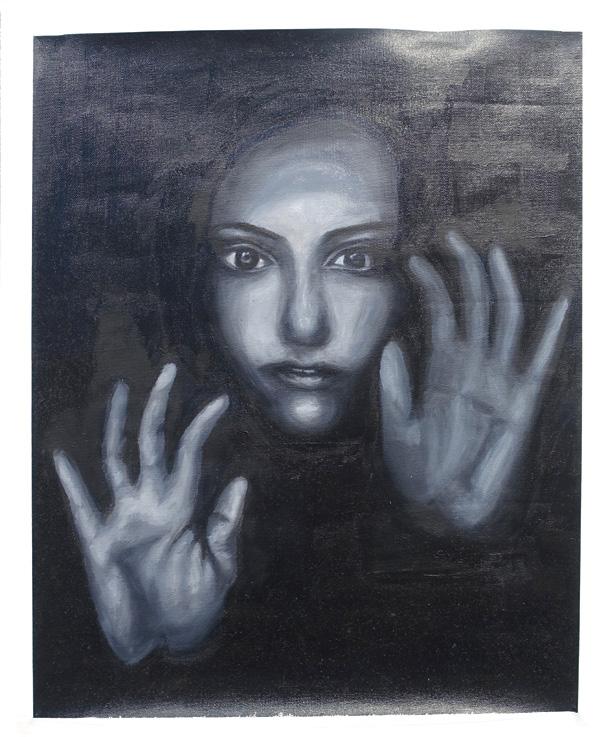
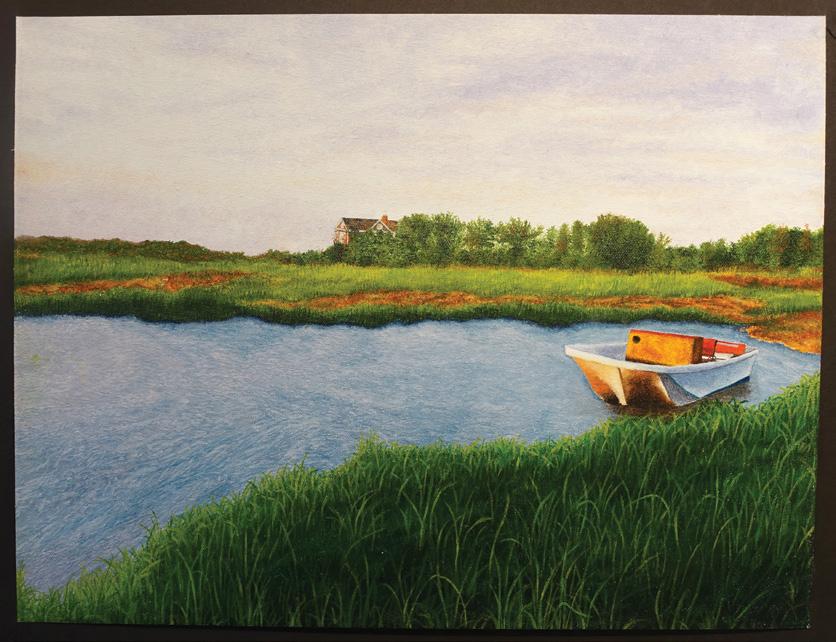

That is no small feat. It takes about 40 gallons of sap to produce one gallon of maple syrup. The maple sugar was made available to the Loomis Chaffee community, and samples were given to alumni on Reunion Weekend.
Phase Three this academic year includes the purchase of a reverse osmosis machine and more equipment and construction of the sugar shack along Faculty Row.
“I got involved through the e-proctor program,” says senior Delaney Denno. “It was fun learning from start to finish how everything worked, from drilling the holes to putting the taps in to taking them out and finishing the maple syrup.”
Senior Sandro Mocciolo says he was led to act by Alejandro.
“When I was a sophomore, I was inspired by Alejandro to take on the program when I joined the e-proctors,” Sandro says. “Last year was when I really got involved, and the program was expanded past the more small-scale project that Alejandro started.”
18 Loomis Chaffee Magazine Winter 2023
ISLAND NEWS
Sophomore Syd Robinow
Senior Susan Ran
Junior Vanessa Kim
Sophomore Eugenie Kim
— JEFF DYRESON

Andrew Hutchinson, a faculty member who works out of the Pearse Hub for Innovation, took the lead on constructing the sugar shack, a small prefab building out of Vermont, and students signed up to help.

“We have a philosophy in the Alvord Center of leveraging the campus as a working laboratory,” Jeff says. “We take ideas that perhaps come out of the classroom or
elsewhere and can be done on campus, sugaring being an example. Making it relevant to the students’ lives, seeing a final product, seeing it bottled, tasting it … it’s a valuable and transformative experience for our students. It’s almost like professionallevel work, and to give them a taste of that is unique and special. So Loomis Chaffee has done a wonderful job of not just talking the talk, but trying to walk the walk with
experiential learning, which is Sarah’s role.”
Sarah Griggs is an associate director of the Alvord Center.
“The hands-on nature of this is great, and several classes will integrate this work into their classes,” she says.
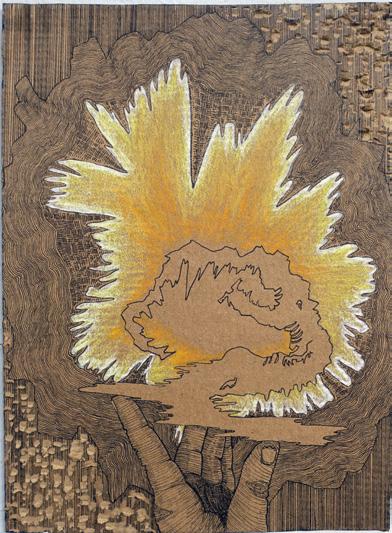

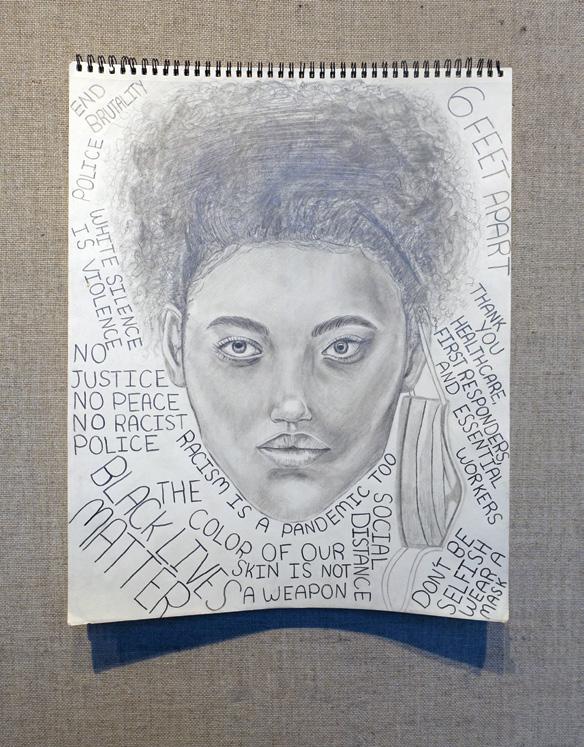
Teachers in several disciplines have contacted Sarah about incorporating the maple sugaring operation into their course work. Students also have geo-tagged trees to see how much sap each produces, and computer science students are creating programs to organize and streamline the sugaring process.
The creative juices around campus are flowing, much like the sap itself will do soon.
About 30 trees are tagged on campus and as many as 50 taps could be used this winter. Generally, trees are tapped in Connecticut in late February or early March, depending on the weather. Nights below freezing with days above freezing are required.
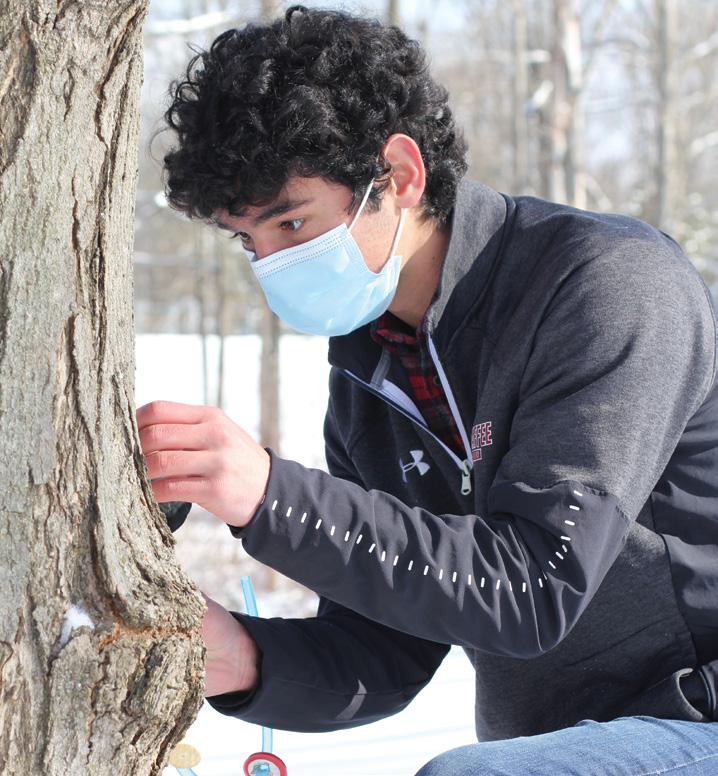
Once the sap is gathered, boils will last from about 8 a.m. to 6 p.m., typically on Wednesdays and Sundays. The days are long, but the reward is sweet.
Above left: Alejandro Rincón ’21 taps a maple tree on campus during his senior year. Above right: Senior e-proctors Sandro Macciolo and Delaney Denno stand near the sugar shack construction.
loomischaffee.org 19
“We have a philosophy in the Alvord Center of leveraging the campus as a working laboratory. We take ideas that perhaps come out of the classroom or elsewhere and can be done on campus, sugaring being an example.
Junior Mercuri Lam
Senior Sophia Prendergast
Junior Moslima H.
Senior Jill Rinaldi
Family Weekend 2022
An action-packed Family Weekend (October 21–22) included performances by the Jazz Ensemble, Company Dance, the Orchestra, and other ensembles; meet-and-greet conversations between parents and their children’s teachers; opportunities to buy books for the library; and many other events.


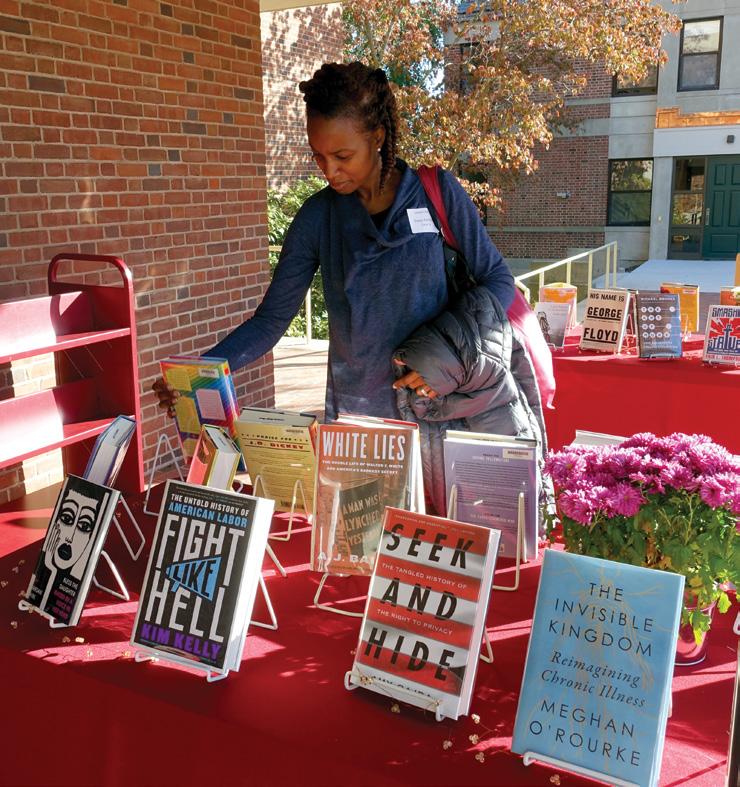

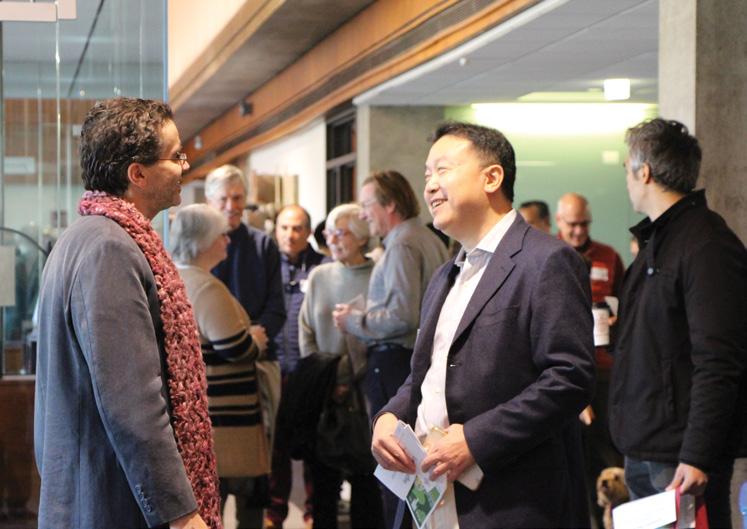

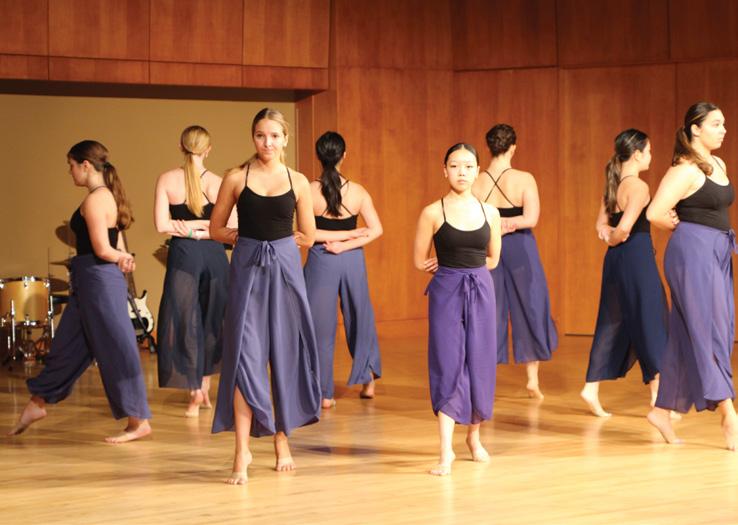


20 Loomis Chaffee Magazine Winter 2023 ISLAND NEWS
Faculty and Staff News
Two of Loomis Chaffee’s varsity coaches appeared this fall on New England podcasts covering the sports they coach. Girls varsity soccer head coach Linda Hathorn appeared on New England Soccer Journal’s podcast The Goal to discuss her team’s strong start to the season as well as her own experiences as a player and coach. Head Baseball head coach Donnie McKillop appeared on New England Baseball Journal’s podcast The Base Path to discuss his team’s recent success over the past few years, last year’s inaugural Founders League tournament and championship, and his coaching philosophy. The podcasts can be found on the two journals’ websites.
Loomis Chaffee welcomed 30 new faculty, including four alumni, to campus this fall: English teachers Joanne Dexter, Kathryn Diaz, Zachary Grobe, Sam Lagasse, and Jane Wanninger; Alex Peña Bethencourt, a teacher in the History, Philosophy & Religious Studies Department; language teachers Khang Le ’13, Maria Vazquez Sanchez, and Sandrine Sebag; mathematics teachers David Kim and K.C. Lawler; science
teachers Ihab Ismail, Justin Daniels, Grant Gritzmacher, and Scott Tumperi; social science teachers Skyler Dovi ’17 and Molly Giorgio ’06; science and social psychology teacher Tina Hamel; visual arts teacher Yoon Jee Kwak; Sarah Griggs, a science teacher and associate director of the Alvord Center for Global & Environmental Studies; Penn teaching fellows Katharine Conklin in the History, Philosophy & Religious Studies Department, Em Adrain in the Modern and Classical Languages Department, and Andrew Wood in the Social Science Department; Chris Blondin, an associate director of admission; Stuart “A.J.” Poplin ’13, an admission fellow and a teacher in the Common Good Seminar program; Scott Halpern, an associate director of athletics; Ryan Wagner, head athletic trainer; Mary Pat Gritzmacher, an associate director of college guidance; and Cedric Williams, a college guidance counselor and director of the Kravis Scholars program. Rejoining the faculty after teaching elsewhere for several years is English teacher John Morrell, who also is director of Writing Initiatives.
Director of Information Technology Dan Corjulo figures prominently in Rinker Buck’s book Life on the Mississippi: An Epic American Adventure, published in August 2022. Dan served as a crew member and reliable wisecracker on a wooden flatboat that the bestselling author, an old friend of Dan’s, built and piloted 2,000 miles down the Mississippi River a few years ago. The book chronicles the journey and has received critical acclaim. The Wall Street Journal called the book “an antidote to the cynicism of the times.”

THAT’S ABSOLUTELY BRILLIANT!
ROSES AND PROSES
Senior Sujin “Serena” Kim and junior Mercuri Lam won a competition and received funding through My People Clinical Services, a local social service organization, to create a writing workshop for young people from the Hartford area. The workshop, which Serena and Mercuri are planning for the spring, will help participants develop their prose or poetry writing as a skill but also as a means of self-expression. The idea for Roses and Proses sprung from Serena’s Norton Fellowship project last summer, during which she designed and offered a writing workshop to students near her home in South Korea.
NATIONAL COMING OUT DAY
The school celebrated National Coming Out Day this fall with a series of campus events, part of an effort to improve the sense of
belonging experienced within the Loomis Chaffee community by students who identify as LGBTQIA+. The day is celebrated annually on October 11, the anniversary of the 1987 National March on Washington for Gay and Lesbian Rights. Faculty, students, and several school departments helped to organize the events on campus.
MODEL UNITED NATIONS
Twelve members of Loomis Chaffee’s Model United Nations team attended the 24th annual University of Connecticut Model United Nations Conference in November, participating in various U.N. organs, disbursing medical aid to conflict zones, reforming penal code, untangling Cambridge Analytica, solving missile and canal crises, and more. Along the way, they developed some new solutions to pressing global issues, and five students received awards for their work:
VOCAL WINNER
Senior Amy Song was named a winner of the 2022 Kings Peak Fall Voice Competition, an international classical music competition that features artists ages 10–22.
HONORED PHOTOGRAPHER
Senior Edward DeVos was one of 60 photographers chosen to be part of ASAP!’s 12th annual Celebration of Young Photographers Event, a statewide competition that received 379 submissions from 46 schools in Connecticut. ASAP!, an arts education organization based in Washington Depot, Connecticut, exhibited the honored photographers’ work at Bryan Memorial Town Hall in Washington Depot in November.
ISLAND NEWS
juniors Luke Daugherty and Zaylie Gore, sophomores Sally Hayes and Eli Krasnoff, and freshman Aanum Khan
Above: Dan Corjulo on the Mississippi River with author Rinker Buck at the helm
PELICAN SPORTS

NEW ENGLAND CHAMPS
For the first time since 1989 and only the second time in program history, the Loomis Chaffee girls cross country team won the Division I New England prep school championship on November 12 at St. Paul’s School in New Hampshire. With gutsy racing by the whole Pelican squad and with all five scoring runners placing in the top 18, Loomis outran defending champion Exeter and 12 other schools to win the title and complete an undefeated season.

loomischaffee.org 23
VARSITY RECORDS

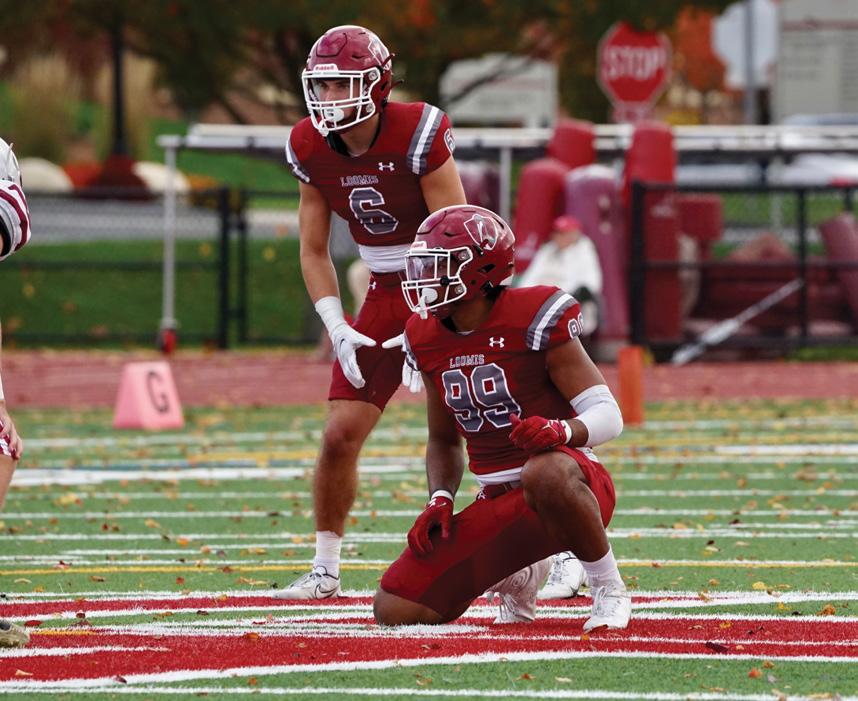
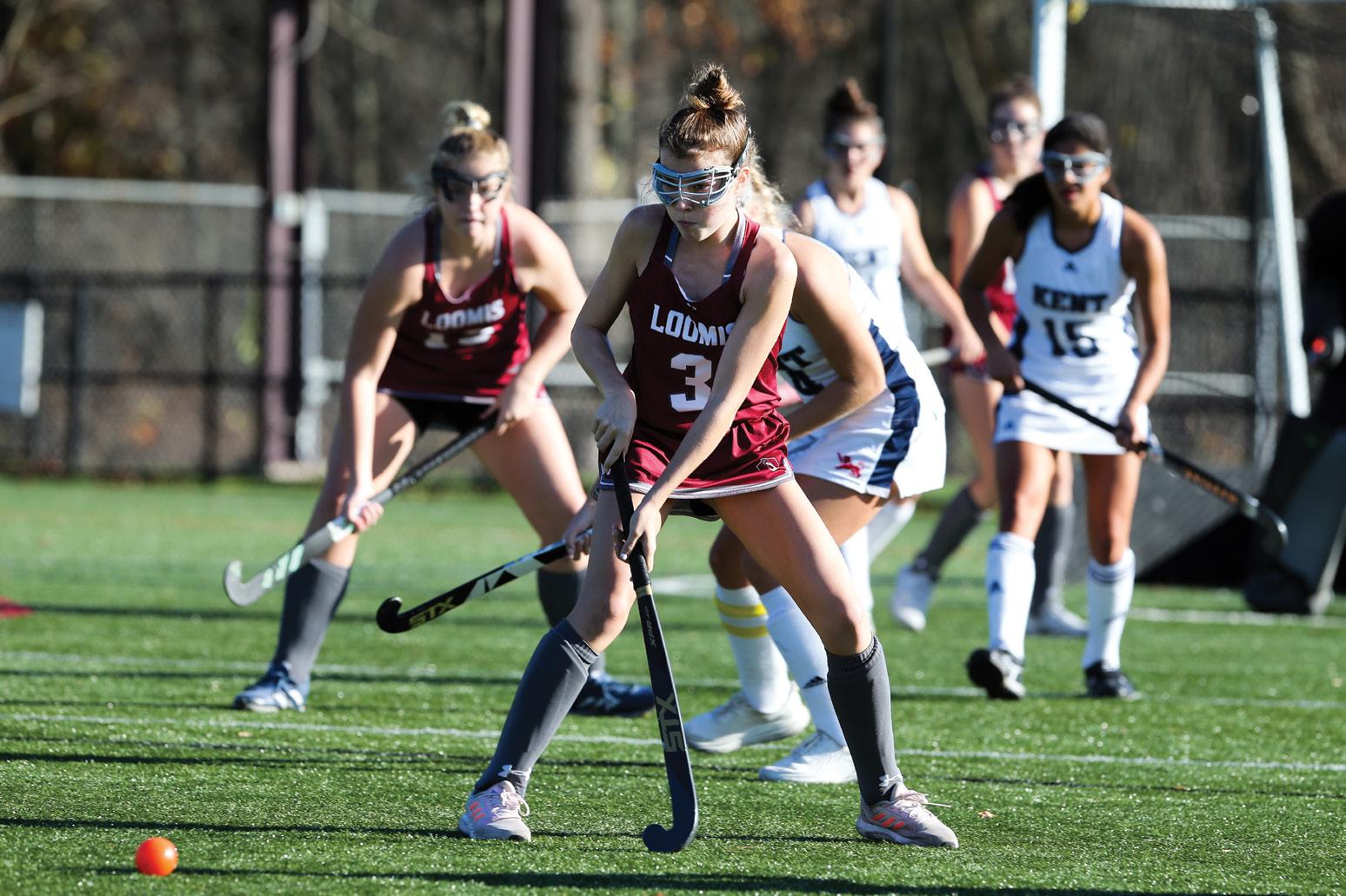
24 Loomis Chaffee Magazine Winter 2023
1 3
1: Freshmen Kathryn Smith and Annie Schwarz 2: Senior Carlo Crocetti and junior Jerod Smith 3: Senior captain Syd Hanley, sophomore Liv Westfort, senior Kaitlin Flynn, sophomore Aiste Bardauskaite, and senior captain Kori Meissner 4: Junior Lorcan Mitchell and senior captain Kieran Chandler 5: Freshmen Maleah Cogle, Frieda Bilezikian, and Sophia Hughson 6: Junior captain Kelly Stepnowski 7: Senior captain Edward DeVos 8: Start of a home cross country race, led by sophomore Erik Lamphere, senior Sam Kurian, freshman Alex Fisher, freshman Miles Gackstetter, junior Evan Gackstetter, and senior Ethan Wood
BOYS CROSS COUNTRY 6-0
Founders League Champion
New England Division I, 3rd Place
GIRLS CROSS COUNTRY 7-0
Founders League Champion New England Division I Champion
FIELD HOCKEY 10-6-2
New England Class A Quarterfinalist
FOOTBALL 7-1
Mark Conroy Bowl Champion
BOYS SOCCER 9-5-4
GIRLS SOCCER 12-2-2
New England Class A Semifinalist
VOLLEYBALL 13-3
New England Class A Finalist
2
BOYS WATER POLO 3-16





loomischaffee.org 25 5 4 7 6 8

Looking Back Across 48 Years
A Roundtable Discussion with Nat Follansbee
by Becky Purdy
In the four-plus decades since Associate Head of School for External Relations

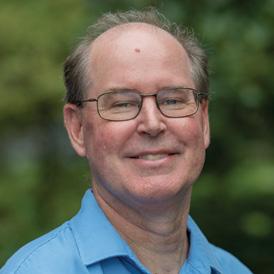

Nat Follansbee first arrived at Loomis Chaffee to teach English, coach, and live and work in the dorm, he has seen generations of students grow up, graduate, and move on to build their lives beyond the Island. Many stayed in touch with Nat — and he with them — as they studied, worked, raised families, pursued other adventures, or did all of the above. A number of Nat’s former charges even returned to work alongside him at Loomis Chaffee, their relationships evolving from student-andteacher or athlete-and-coach to colleagues and friends.
As Nat and the school look ahead to his retirement at the end of this academic year, we gathered four of his colleagues who once sat in his classroom or played on teams he coached at Loomis Chaffee.

In a roundtable discussion, Seth Beebe ’78, Scott MacClinitic ’82, Tim Struthers ’85, and Lynn Petrillo ’86 — who have worked at Loomis in various roles for a collective total of 118 years — reflected with Nat on their time together on the Island. The discussion was facilitated by Becky Purdy, managing editor of Loomis Chaffee Magazine
ROUNDTABLE PARTICIPANTS
Director of Advancement Services and Operations
Tim Struthers
Director of Development
Becky: Thanks, everybody, for coming. Let me start by having each of you say if you remember when you first met Nat and what the situation was.
Lynn: Nat was my freshman English teacher, so it had to have been the fall of 1982 in Chaffee Hall.
Scott: Likewise. It would have been my freshman year, fall of 1978, freshman English and then soccer out in the Meadows. I didn’t play for Nat until I made the JV. The first year, I was on III, but during preseason, we were all sort of together.
Nat: That was probably a mistake. You probably should have been on the JV.
Scott: I don’t know. Long drink of water, but not a lot of speed.
Seth: I met Nat in the fall of 1975. I was playing JV soccer, and he was the assistant coach. We had preseason and, like Scott said, we were all in one big group, but then we split out.
Tim: I first met Nat 40 years ago in the spring of 1982. Nat — Mr. Follansbee — was the first faculty member that I met at the school.
loomischaffee.org 27
Lynn Petrillo ’86 Director of Strategic Communications and Marketing
Scott MacClintic ’82 Director of Innovation in the Pearse Hub for Innovation (PHI)
Seth Beebe ’78
’85
Left: The Founders Hall office of Associate Head of School for External Relations Nat Follansbee is a converted classroom — familiar environs for the former English teacher. Portraits of the school’s Founders hang above the chalkboard, reminding Nat of their mission for the school and grounding his work.
I was coming up to campus for an overnight visitation hosted by Sean Mullen ’85. And we were brought over to the Follansbee apartment on Batch first to meet Nat. Then I enrolled, and as a sophomore Nat was my head JV coach for soccer.
Becky: Nat, where were you before you came to work at Loomis Chaffee?
Nat: Well, I went to Hamilton College, and then I spent a year teaching and living in Athens, Greece, which had a profound effect on me at the time and has ever since. And then I spent a year in New Hampshire doing odd jobs because I didn’t apply for jobs from Greece. And then I came here in the fall of 1975. In those days, there was no [faculty] orientation at all. No teacher had orientation. I was living on the third floor of Batch. They actually changed the books that I was going to teach over the summer, so I had to read a whole slew of new books when I first got here. It was an entirely different place [than it is now] in terms of a new teacher arriving on campus.
Becky: And how old were you?
Nat: Let’s see, 23 or 24, something like that.
Becky: You always make everybody feel comfortable, and that’s probably a trait that has always been true. But I’m wondering if the rest of you remember if that was true when he was the adult and you were the student or the athlete. Do you remember whether Nat made you feel comfortable in the classroom or on the field?
Seth: I was thinking about this. Nat, although he was very young, he had sort of a level of maturity about him that some of the other younger teachers didn’t have. And so, although he was friendly, there was also the understanding that he was a faculty member.
Top left: In the 1982–83 school year, Nat helps Thom Furtado ’86 in English class in Founders Hall. Top right: Soaked, Nat is one of several faculty volunteers for the dunk tank on Spring Day in the 1980s. Middle: Coaches Nat and Barry Moran talk to their JV boys soccer team during halftime of a game in the fall of 1982. Among the visible players are Ira Gaberman ’85 Ted Mattis ’84, and William “Flip” Wiehl ’84. Right: The 1985 varsity boys tennis team photo: Coach Nat and players Bobby Wice ’88, Steve Rush ’88, Brian Thompson ’87, Jim Polese ’85, captain Tim Struthers ’85, David Cundey ’85, Mark Rush ’86, Bob Lammey ’86, and Todd du Boef ’86.
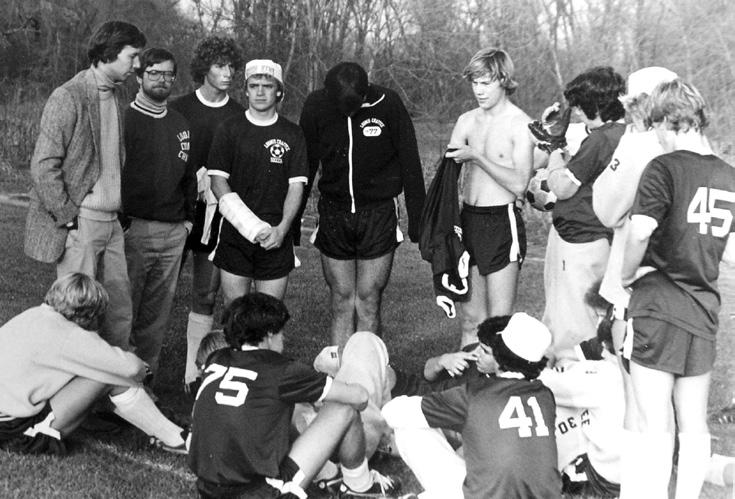
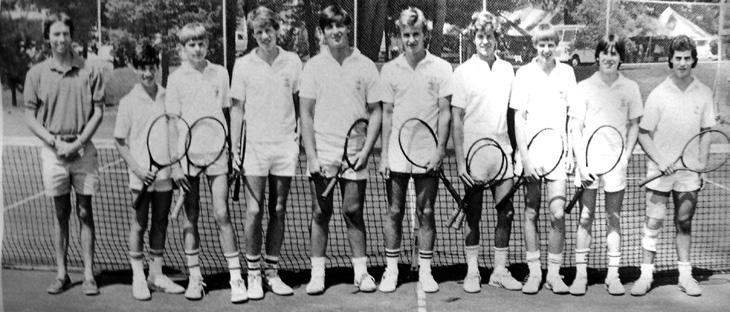

Becky: Was it hard for you to set that boundary, Nat?
Nat: No, not really. I do remember an instance when I was in the dining hall and a young lady came up to me and asked me to go to the dance with her, and I had to explain to her that I actually was a faculty member and I couldn’t go to a dance with her. So clearly some people didn’t think of me as
being old enough to be a faculty member, but that was the only time that that really ever happened.
Becky: What was it like having Nat as a teacher?
Lynn: English was not my strongest subject or my favorite subject. I was more of a history person. But I do remember feeling

28 Loomis Chaffee Magazine Winter 2023
comfortable in that classroom. I got my first C ever in that classroom with Nat, but I don’t remember it as being upsetting. I remember very clearly — and it was probably the way all the teachers were teaching freshman English — but we started by learning how to craft a sentence and then slowly built from there. I learned so much in that freshman English class, and that was great. I don’t recall ever feeling uncomfortable or somehow lesser-than because I wasn’t excelling in the

way I wanted to excel at the time. So if I was going to get a C early on, it was a good thing it was coming from that [class] because I felt like, “We’re going to start here, but we’re going to make progress.”
Nat: And what did you get in the spring? Did you get an A?
Lynn: I think I ended up with an A.
Scott: My memories are most vivid from soccer versus the classroom. I think you spend more time, to be honest, out there [at sports] and more intense raw time. Between Nat and Barry Moran, who was a coach with him, it was an ethos. I cannot think of a moment when either one of them was upset and yelled at us for something. That just wasn’t the demeanor. Everything was, “It’ll be fine.” We’d get very intense in games and wanting to win, certainly, but there was not ever this leverage of power to motivate students. That’s not how you motivate young people. Ultimately, it may work in the short run, but not in the long run. I remember vividly that it was a tone

loomischaffee.org 29
Nat teaching English in the 1980s
about practice that speaks to Nat’s personality and way of dealing with people.
Tim: I did not have Nat as an English teacher; however, he was my JV soccer coach in my sophomore year, he was my advisor in my junior year, and he was my coach for the tennis team in my senior year. I would say that my most vivid memories are probably from senior year. Nat had been tapped to become the head coach. I had been on the team for a couple seasons already, and it was great fun to have him be our coach. We had fun on the team. And one of the greatest memories is our road trips where, rather than taking a school bus or van, we would use Nat’s minivan because we were a small team, to travel to Hotchkiss or to Kent or Berkshire or wherever. It was a great, very comfortable feeling having Nat as the leader of our group.
Nat: It was important to have Tim as well because I didn’t play tennis in school. I was a lacrosse player, but there was no room for lacrosse coaches at Loomis Chaffee with Grim [James Wilson] and Bruno [Charles Vernon]. I wasn’t going to teach Tim much about tennis nor the other kids on the team, but they were very accepting of my being the

Top left: In the spring of 1985, Nat readies to load the tennis team into a van for an away match. Middle: Nat as director of development

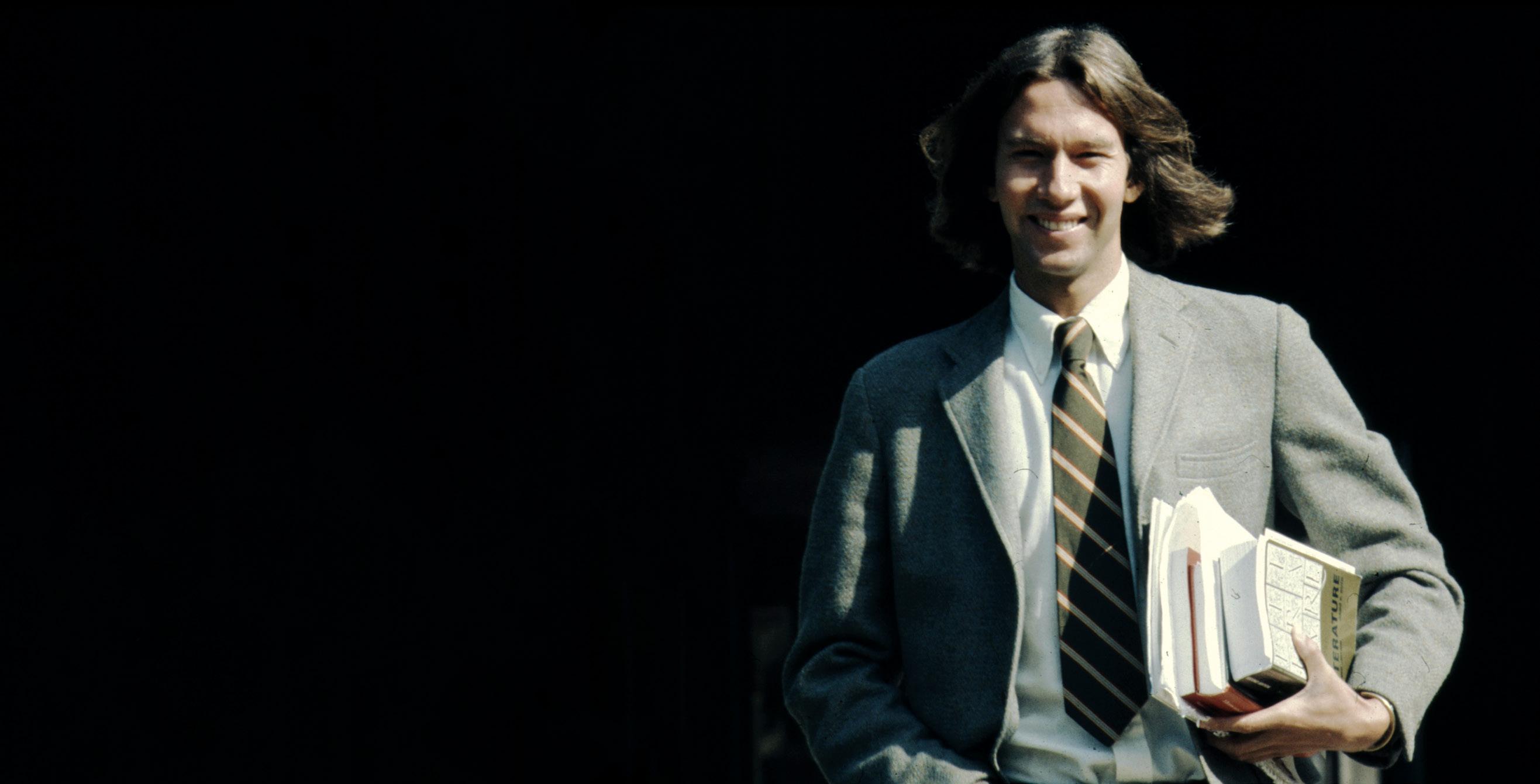
coach, and Tim was the captain and the leader of the team. He was really important to the whole success of the team, more so than I was probably.
Tim: I do remember Mr. Follansbee saying to [me], “OK, I haven’t coached varsity tennis before. Help me out here. What are some drills that you like to do? What are some things that we can be doing as a team?” It was a very good sort of give and take. It wasn’t like Nat came in and said, “This is the way it’s going to be.”
Becky: Nat, do you remember when you were first starting out, how you tried to set this atmosphere with students?
Nat: I don’t think it was intentional at all. I think it really came from my mother, who was very comfortable in her own skin, as was my dad. But I spent much more time with my mother because she was a mom, and I think she set this tone. In fact, it was a tone that makes me appreciate Loomis Chaffee for what it is. She was accepting of everybody, treated everybody with respect and with dignity and always welcomed people into our house, no matter who they were. So I think it came from that as well as having had some responsibilities. When I was in college, I was a captain of two teams and had important roles in other areas, so I was used to some leadership.
… I should say that Scott sells himself short on his soccer ability. He was perhaps the best person I’ve ever seen in anticipating what was going to happen with the play and the ball. Although he wasn’t the speediest
“I call it total school-keeping, which is when every single one of us realizes that we represent the school. Every minute. When I’m at Geissler’s, I represent the school. When I’m at a reception, I represent the school. Wherever I am. And it’s important that we always … treat people well. I think we do that pretty well.”
Nat Follansbee
person on the field, he often anticipated more easily than anyone else on the field and was where he was supposed to be long before the ball got there. And Tim was an incredible tennis player.
And Seth, I remember Seth as a skinny soccer player at the time. He was good with the ball, dribbling the ball. Did you start, Seth?
Seth: Sophomore year, that was when I was on the team with you because freshman year I had been mostly hurt. And sophomore year I also had Walter Rabetz for photography. I adored Walter Rabetz, but I did not enjoy the photography class. And every Wednesday we had photography class. I did my best to get out of going to photography class, so I missed a lot of Wednesday games. I think that influenced whether I was a starter or not. I did start, but not all the time.
Nat: So what were you doing on those Wednesdays?
Seth: I probably was, you know, home, home sick. … And eventually I dropped photography.
Nat: Lynn obviously was a really good student and improved dramatically during the course of the year. But my memories of Lynn are mostly from working with her at Loomis Chaffee, more so because I didn’t coach [her], and she wasn’t in the dormitory. One of the best things about my life at the school is working with all these people because I have such fond memories of them.
Becky: I do want to turn to that. How, if at all, did your relationship with Nat change when he was your colleague rather than someone you were hoping would put you into the game or give you not a C?
Scott: In my third year [as a faculty member], I moved over to become the dorm head of Taylor, and Nat was still resident in Taylor at the time. So he got to work for me, which was a great story when the parents were moving in [their kids], to introduce the affiliates in the dorm. I would introduce Mr. Follansbee, my former English teacher
and soccer coach, who now works for me in the dorm. It was an interesting sort of shift all of a sudden, [but also] obviously relying on his expertise, having been in the dorm and everything.
Becky: How was that turning of the tables?
Scott: There’s still a looking-up-to piece that comes out. There are certain people that just had this gravitas, for lack of a better term. And Nat was certainly one. It was great to have somebody that I looked up to working in the dorm.
that I went to, my boarding school — what is now known as the Governor’s Academy — raises a lot more money than Loomis Chaffee does with a much smaller alumni body.” That was sort of the beginning of the end. … I was picked to be on the committee to find Craig Stewart’s successor, and Bill Griffin and Russ Browning [of the consulting firm Browning Associates] were helping us with that. We went through the search, I think, twice, and both times the person who was the finalist turned us down in the end. They couldn’t find anybody. I was supposed to take a sabbatical the following year.
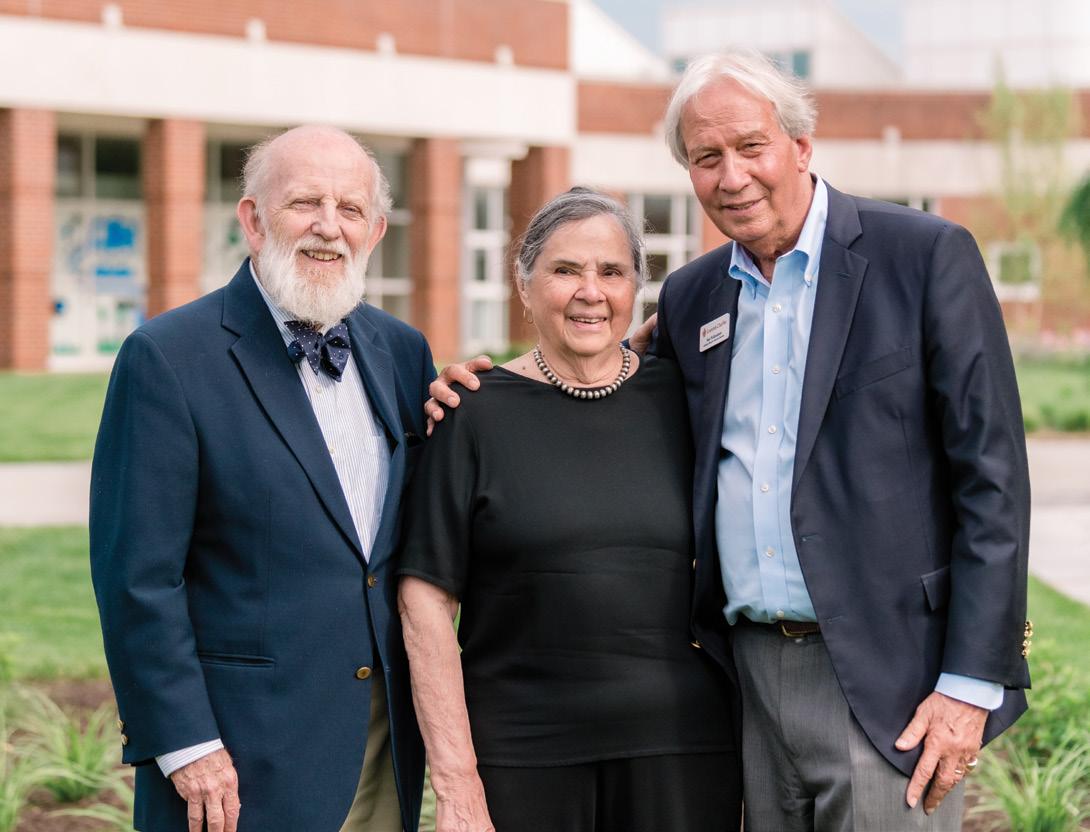
[Then-Headmaster] John Ratté called me into his office, and I thought, “John wants to talk to me about what I’m going to do on my sabbatical,” and I get in there and he says, “I want you to be the director of development. Bill Griffin and Russ Browning think you would do a good job, as does Craig Stewart.” I asked him if I could take my sabbatical and come back and [become director of development] the following year. He said no, so I agreed to do it, which actually in retrospect was probably one of the best decisions I’ve ever made, because I ended up with a wonderful mentor in John and then all of these things.
Seth: I started [working here] in the spring of 1984, but how I really encountered Nat was when he joined the Development Office in 1986. Browning Associates was our consultant, and they sort of drafted Nat because Craig Stewart, who was the person who hired me, had left. Sue Joffray was the acting director of development, but she didn’t want the job. And Nat was a real rookie at development. Sue and I were kind of trainers for Nat, which is interesting when you train your boss. But Nat changed from being both a teacher and a coach to someone that I worked with to a very close friend throughout the years, someone I can confide in and I think confides in me as well. So we have a great relationship.
Nat: Couple of stories related to all that stuff. I was a faculty rep [to the Board of Trustees]. And when I went to the board meeting, I complained about the Annual Fund to the board because I knew what an Annual Fund was and they were talking about faculty salaries. And I said, “You know, one area where we could do much better is in the Annual Fund, and that goes directly into the operating budget.” I said, “My school
I should add that it would never happen today. What happened to me in 1986 would not happen today.
Becky: Why?
Nat: Because you would not take an English teacher and make him or her the director of development. It just wouldn’t happen. They can hire people who have much more experience. … I was very lucky.
Becky: What do you think John [Ratté] saw in you? And then I want to ask if people agree with that.
Nat: I don’t know. I think it was recommendation of other people. And certainly, to me, John is one of the most warm, thoughtful, caring people I’ve ever met and continues to be that way. You know, John went to Andover — he knew my father — so there was sort of an immediate bond there, and we became very close. In fact, John is probably the second most important man in my life, with my father being the first.
loomischaffee.org 31
Above: John and Lou Ratté and Nat during the re-dedication of the Ratté Quadrangle, summer 2022
Travels with Nat
Among his many trips on behalf of the school, Nat has traveled to Asia more than 20 times since 1995 to connect with alumni, families of current students and graduates, and prospective students who live there. Tim, Sheila, and a representative of the Office of Admission often have joined him on these trips.


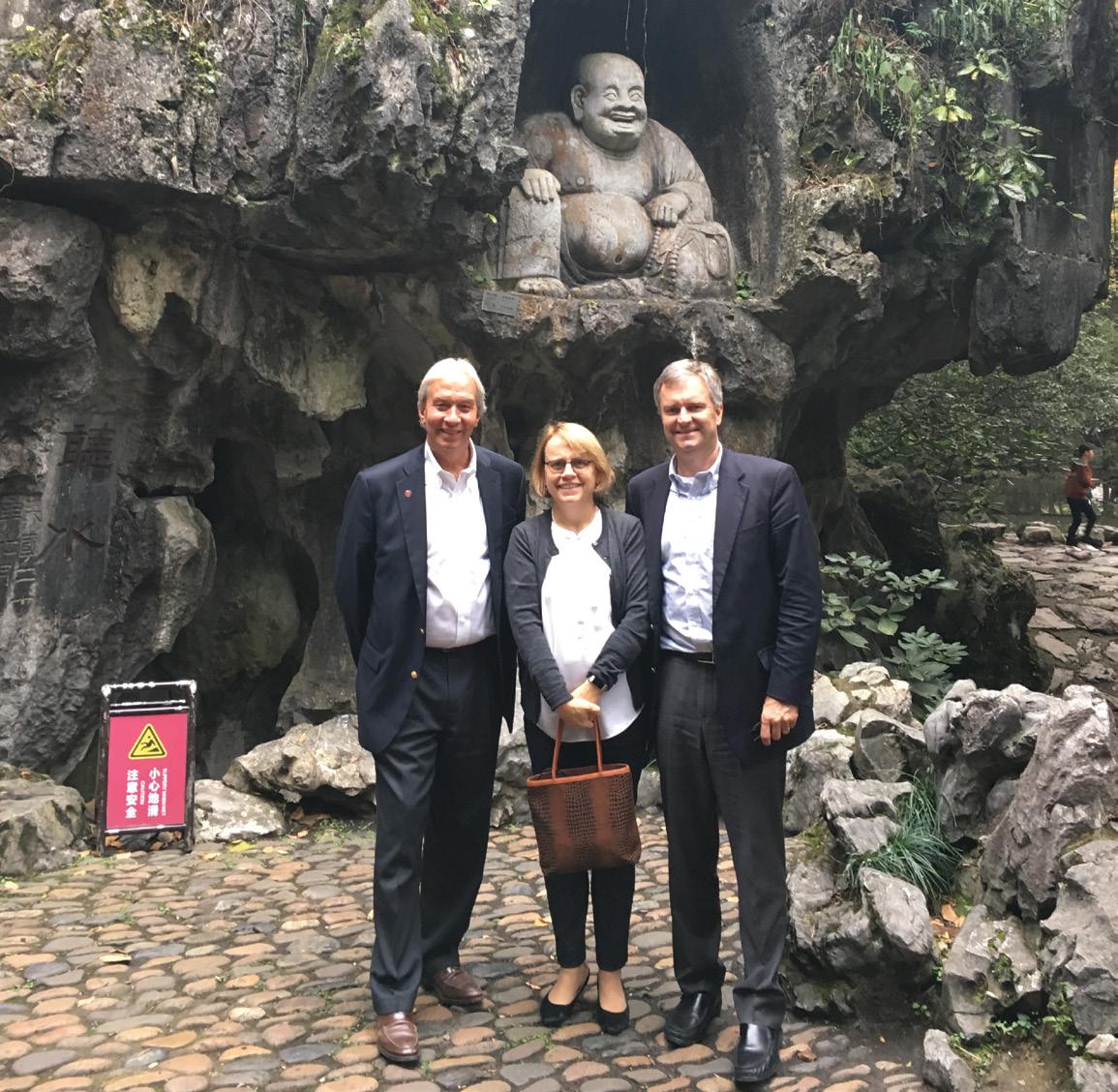
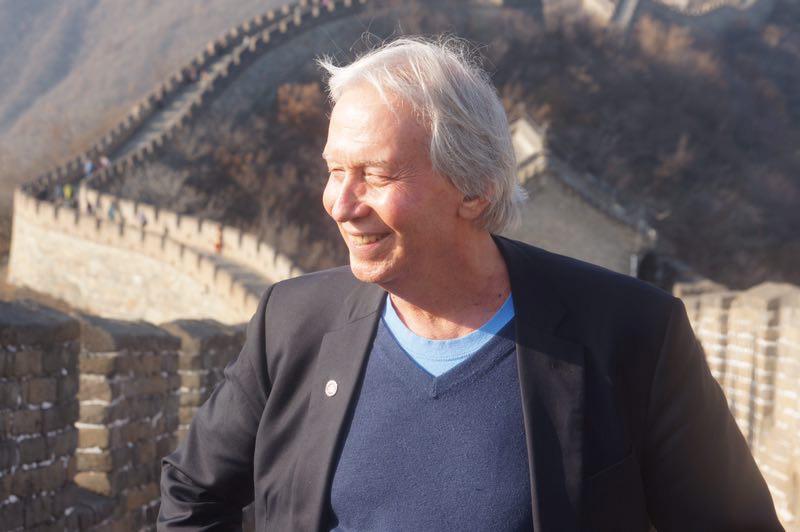
1: In Hong Kong, Head of School Sheila Culbert and Nat climb into a Tesla owned by James and Grace Wang (parents of Stanley ’18 and Marco ’20) in November 2017. 2: In Shanghai, Nat, Sheila, Zhengmei Xu (parent of Tony Shen ’20 and current freshman Gracie Shen), and Director of Development Tim Struthers ’86 stand in front of the Pearl Tower in November 2018. 3: Embarking from JFK Airport on their November 2018 trip to Asia are Nat, Sheila, Dean of Enrollment Amy Thompson, and Tim. 4: In Hangzhou, China, Nat, Sheila, and Tim stop in front of a Buddha sculpture in November 2017. 5: Nat at the Great Wall of China in November 2016 6: In Bangkok, Sheila, Nat, Amy, and Tim enjoy a dinner with alumni, including Pong Lamsam ’85 and Prapas Uahwatanasakul ’85, in November 2018. 7: In Beijing, the Loomis Chaffee visitors gather with the China National Acrobatic Troupe in 2016. 8: In Beijing’s Art District in 2017, Nat, Sheila, Didy Shi (parent of Jasper Shi ’19), and Tim admire a mural. 9: The travelers in Ho Chi Minh City, Vietman, in November 2017 10: At The Peak in Hong Kong, November 2018



32 Loomis Chaffee Magazine Winter 2023
2 4 1 5 6 3
7
Becky: What skills did you need to develop moving into that role and how did the rest of you train him up?
Seth: Well, I think probably what John saw was that Nat was an accomplished person, especially socially, which is such a huge part of development, which is why I’ve always been in the back office. Nat saw that his school, [Governor’s Academy], at that time raised more money than we did, but he probably didn’t know why. He had to learn the ins and outs of what development work was. I mean, you have an Annual Fund campaign, and there are various stages to that campaign, and you have capital fundraising going on at the same time. And how do you combine asking someone for both an Annual Fund gift and a capital gift? Just the ins and outs of the whole … industry.
Nat: Part of it was I think I understood pretty early that relationships were important to raising money, and long-term relationships were even more important, which you could have with alumni and with some parents. So that came to me pretty quickly and, correct me if I’m wrong, but I don’t think we were traveling anywhere near as much as we started to. I also learned early on that you have to go see people, you have to be in front of them and talk with them in order to create that relationship. So those were two things, but I didn’t really know much about endowment. I certainly didn’t know anything about planned giving.
Scott: An empathizer-in-chief is what it is — that’s the superpower. It’s all about relationships and people believing and feeling. It’s [about being] genuine and [having] face time. It’s a marathon, not a sprint. If people don’t think you’re genuine and sincere, I imagine it falls flat on its face. But that doesn’t happen with Nat.
Tim: Just picking up on that and the relationship-building aspect to the role, when I was right out of college working in advertising in New York City, Nat was going into New York City to meet with alumni and parents. And he called on me, and we had lunch. I don’t remember exactly the content of it, but I have to say that he was one of the two key people in my own interest in coming back to the Island to work. He helped to plant that seed. He has a way of maintaining that connection with people and that warmth. And as Scott said, this genuineness that is very important in our line of work and just generally in life.
Becky: You have a good memory, Nat. Nat: I don’t recall. [laughter]
Becky: You can remember details about people, which helps you in building relationships. Did you always have that or is that something you had to develop?
Nat: I think I’ve sort of always had it, but I certainly have sharpened it during my time in development because you do have to remember some of the stuff we [think of] as superficial or superfluous. But a lot of it isn’t. You have to remember children’s names. You have to remember what they do for a living, all that kind of stuff.
Seth: You prep.
Nat: Something that you may not all know: [Director of Prospect Management & Research] Christine Silva sits up on the third floor [of Founders Hall] and does excellent research on the people that we’re going to

see. When we’re going to see someone, we get a dossier, and we look through that, and that helps to refresh my memory. That’s really important, too. But there are times when if someone walked by, I would remember a lot of stuff about them without looking at the dossier, especially alumni.
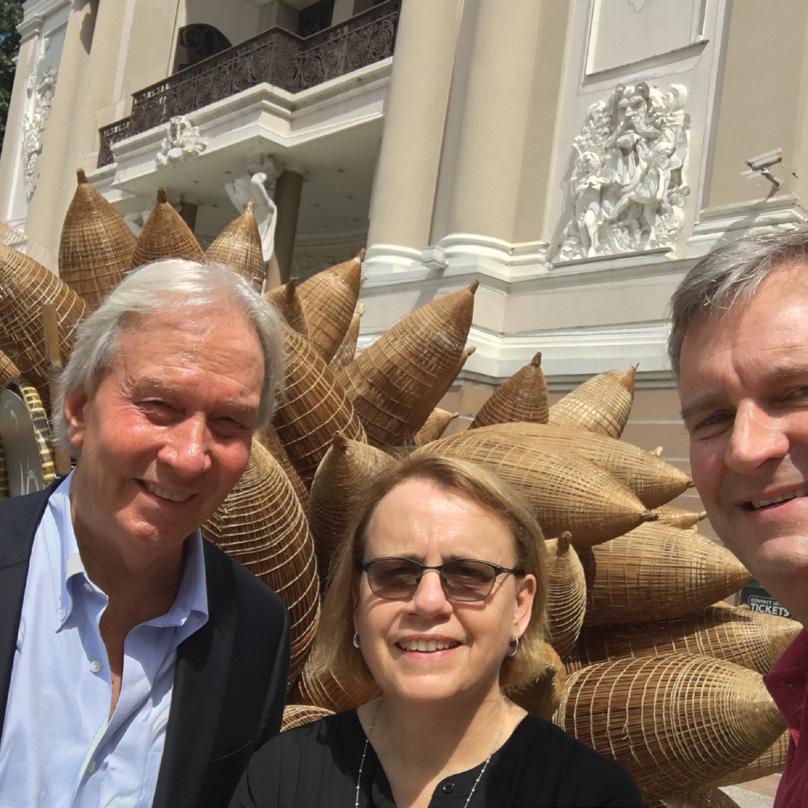

Becky: Nat, what’s the hardest part of working here?
Nat: I don’t know. I really don’t. My time here has been really special. I’m not sure that there are many individuals who’ve had this kind of career that I’ve had where — and I should add that longevity in this profession at one school is important to the fundraising a school can accomplish. But just look at these people [in the room]. These are four of the most special people that I’ve known. And they’re all kind and generous and thoughtful and good at their jobs. I think probably the most difficult time was when I was first here in 1975. In those days it was hard for me to fill a 45-minute time period because no one was telling me what to do or how to teach or anything like that. The daughter of another faculty member was in my English class, and I remember her walking with me from Chaffee back toward the Grubbs Quadrangle and saying, “Mr. Follansbee, you have to fill class every day. You have to do 45 minutes.” And so I took that to heart. There have been disappointments, certainly. And some of those disappointments have come from people not giving the kind of money to the school that they should. But that’s a little bit different than being disappointed in the person. I don’t think I’ve ever been disappointed in an alumnus or alumna or a parent who hasn’t given as much money as [we hoped].
Seth: Nat not only has the many attributes that we’ve already mentioned, but he’s also a very hard worker. And so someone who doesn’t approach that standard is a little disappointing to him. He doesn’t want to infringe on his relationship with them, so he doesn’t want to ask them to work harder, but he expects them to work harder. And I think he’s disappointed when that happens. Is that correct?
Nat: Yeah, I’m disappointed in most of the office right now. [laughter] I mean, looking at all these people, I think we all set relatively high bars for ourselves and for the people around us. And of course it would disappoint us a little bit if they don’t live up to that.
loomischaffee.org 33
9 8 10
Nat: I enjoyed being a consultant. [Nat took seven years away from Loomis Chaffee to serve as president of Browning Associates from 2003 to 2010.] But it wasn’t the same as working here, where you have a mission and you have great people. … I came back because Laura [Richards Milligan ’99], my daughter, was teaching here, and she said, “You need to come watch the girls varsity lacrosse team. We are really, really good. You need to come on a Wednesday afternoon and come watch us play.” And when you’re a consultant, you can sort of do whatever you want to do. I mean, I had to travel a lot, but you didn’t have to be in the office all the time. I came over, and the first person I ran into was [longtime faculty member] Fred Seebeck. We started to chat, and then [Head of School] Sheila [Culbert] came down with a couple of the dogs. Fred said, “You need to meet Sheila.” And so I met her, and as soon as I introduced myself, she said, “Oh, you’re Nat Follansbee.” And I said, “Yeah, I am.” And she said, “Would you come to my office and visit with me next week or the week after?” And I said, “Sure, I’ll do that.” So we met the first time and she was really interested in governance and my thoughts about governance. And maybe the third time we met over a number of weeks, I said to her, “You know, if you would like me to come back to Loomis Chaffee, I would be willing to do that.” And that was sort of the beginning. I don’t know what exactly she did with that information, except that I was here a couple of weeks later, basically.

Becky: Was that her first year?
Nat: No, it wasn’t. It was her maybe second or third year. And I’ll tell you, the beginning was a little bumpy. Sheila, as you know, has high expectations. But I’ve gotten to know her really well. She’s really a very special person in terms of her leadership. She’s really good at her job, and if you do get to know her, she is warm and very caring. I think she’s fantastic. The reason I came back was her. I said to myself, “This woman is really dynamic. She wants to accomplish some things. She’s ambitious for the school.” So it was wonderful.
Lynn: As everyone’s mentioned, [Nat is] a very strong fundraiser, and that’s where he’s excelled for the school. He’s also really great on the leadership team. We’ve gone through crises as a school and obviously COVID, the most recent prolonged crisis. He was part of a small group that I was a member of too that was meeting daily over Zoom to try and deal with the issues [related to the pandemic]. He was level-headed and calm. He was really good at hearing everyone and coming out with the thread that was running through our different thoughts and pulling things together. The school has been well-served by his perspective, his leadership style, the way he collaborates with others, the way he listens. He really listens. I’ve learned a lot from him as a professional, but I’ve enjoyed our conversations and our work together and collaboration more than anything.
Nat: Going back to my beginning as director of development, one of the things I had to get comfortable with was asking for money. Tim and I spend a lot of time with people who are very wealthy, and you have to be able to be comfortable with that. And you have to be able to say to someone, “Would you consider a gift of $15 million?” or “Would you consider a gift of $4 million?” You sort of grow into that. It’s not something that comes naturally necessarily.
Becky: Did you get better at it?
Nat: Yeah, much better at it, just more and more comfortable with it. There’s a time in there when you feel like you’re asking them to give money to you personally, but really [you’re asking on behalf of] the school. And Seth will remember this: Raising money at the school when I first started in 1986 was like pulling teeth. It was very, very difficult to raise money here. And today we get pretty substantial checks almost every day, pretty significant money almost every day, which is good.
Becky: Why do you think that is?
Nat: I think first of all, it comes from leadership of the Board of Trustees and from Sheila. It probably started with John Ratté. I think that people who went to school here feel a lot more pride in the school than they did earlier, and as a result, they tend to give money. We have thousands of people who give less than $200 to the Annual Fund, and

34 Loomis Chaffee Magazine Winter 2023
Left: At the celebration of the Our Time Is Now capital campaign in October 2018, Nat greets Trustee Marc Rubenstein ’82 and his wife, Jill Hai. Tim Helfrich ’96, a faculty member at the time, is in the foreground. Right: At a rehearsal for the 2015 Winter Chorale, for which Nat was narrator, in Hubbard Performance Hall
it makes up a good chunk of money. But the fact that they’re giving is wonderful. [It’s also because of] Tim and the whole office and the traveling that we’ve done. So it’s leadership starting at the top and working the way [to everyone], including all the teachers and the students. Students leave here feeling good about the place generally, and that’s helpful. I call it total school-keeping, which is when every single one of us realizes that we represent the school. Every minute. When I’m at Geissler’s, I represent the school. When I’m at a reception, I represent the school. Wherever I am. And it’s important that we always … treat people well. I think we do that pretty well.
Scott: In class yesterday we were talking about that very issue of when you’re walking onto a field at an opposing school or you’re in the grocery store or at CVS and you’re wearing your Loomis hat or your sweatshirt, you’re part of the story and the narrative.
Nat: Another way of looking at it from a development angle is every single individual has both capacity and inclination. Now, people’s capacity varies. Some people don’t have a lot of money, and some people have a ton of money. So you have to figure out
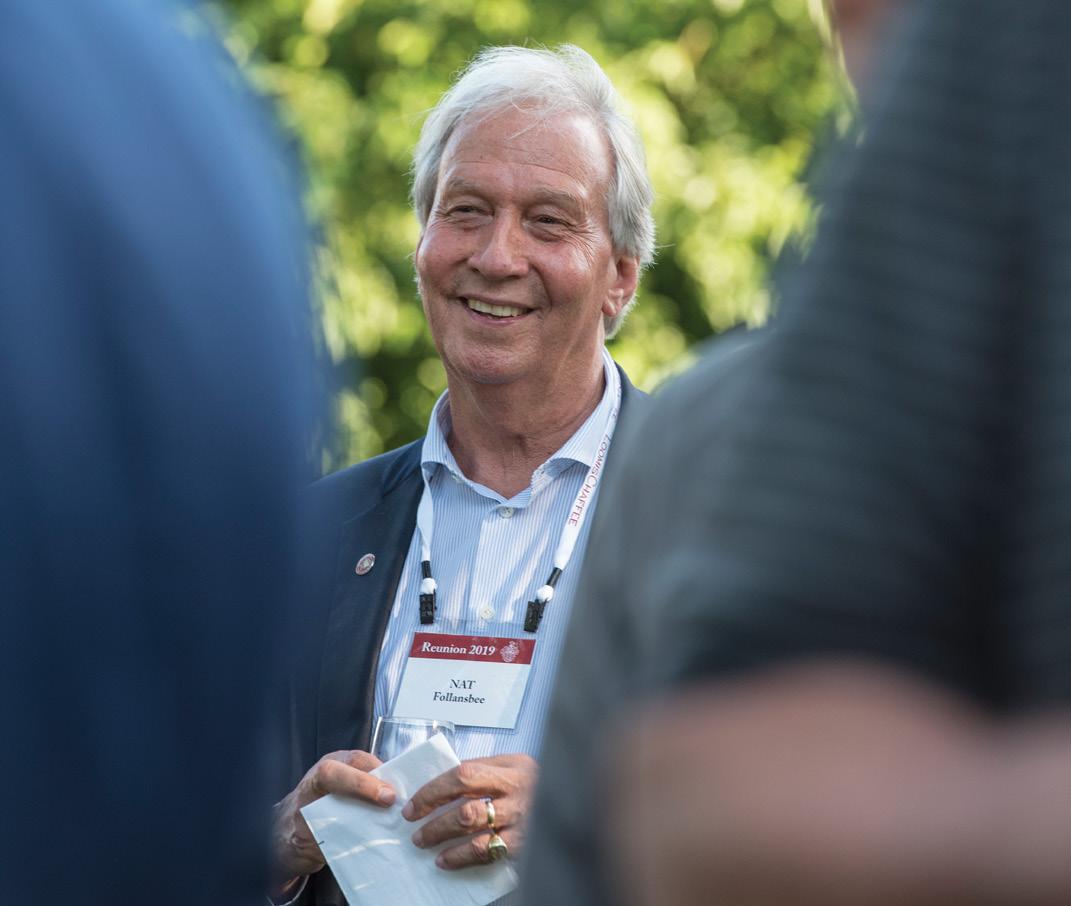
the capacity. But you can affect people’s inclination to give to the school. By all of our faculty treating people well and doing those things, you have families, parents who want to give us a significant amount of money to keep it going.
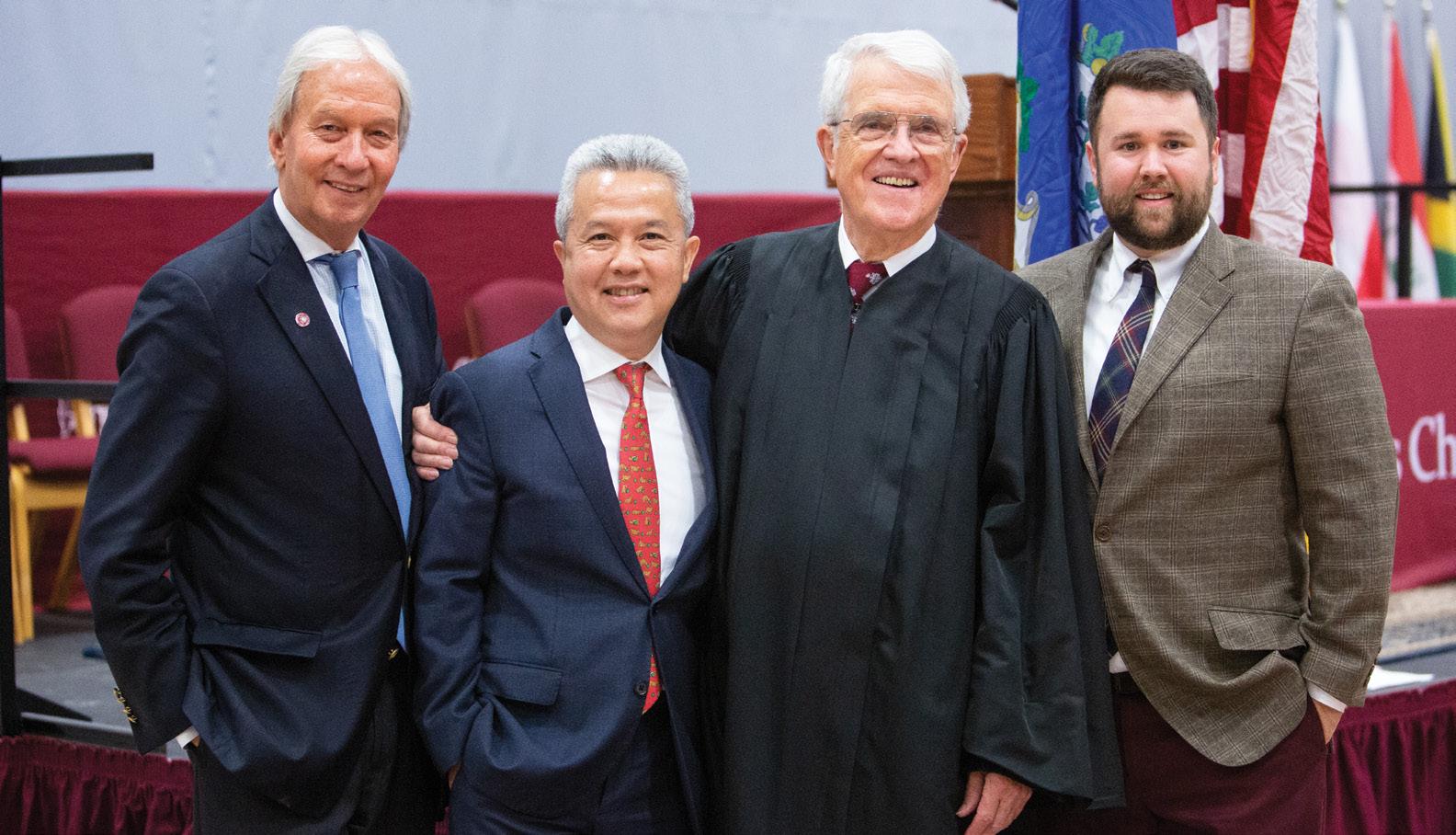
issues of the day. And she gives really good advice to Sheila in those meetings. Tim, I’ve worked with him forever. He’s very warm and friendly, and he’ll do very well after I’m gone. And Seth is Seth. He will do what he needs to do in the office, and for someone who has traveled as little as Seth has, he has incredible common sense. I’m proud of all of them. And then Scott has really done a great job first with the Kravis Center and then with the PHI much more than we ever expected it to be. [Scott was the inaugural director of the Kravis Center for Teaching in coaching before becoming director of innovation in the Pearse Hub for Innovation (PHI).] And he should take a lot of credit for that. So these are important people to our school.
Scott: We’re the harvest of your plantings.
Becky: Does anybody have questions that I haven’t asked or that you want to ask Nat?
Nat: All of you are so important to the school, and I hope you know that. I mean, that’s part of the fun for me. Lynn is incredibly important to what she does. She talks about my involvement in the HAT team [Head’s Administrative Team]. She’s much better than I am at threading things together and thinking through the important
Nat: Brilliant.
Becky: Great. Well, thank you, everyone.
Nat: Thank you. It was fun.
Above: The family at their home on Main Street in Farmington, Connecticut, a few years ago: Tim Richards ’04, Rob Follansbee, Laura Richards ’99, Sally Follansbee, Russell Follansbee, Adam Richards ’03, and Nat — and dogs Maggie, Scooch, Tinkerbell, Bunker, and Patty

loomischaffee.org 35
Left: Reunion Weekend 2019 Right: At a U.S. Naturalization Ceremony, held in the Olcott Center in October 2019, Nat stands with keynote speaker Dang Phan ’79, presiding judge the Honorable Alfred Covello ’50, and faculty member Eric LaForest, then the Keller Family Director of the Norton Family Center for the Common Good, which helped organize the ceremony.
More Fully Human

 by Mary Coleman Forrester
by Mary Coleman Forrester
... the project started from an empty page ...
In the spring of 2021, four students — juniors who were studying CollegeLevel U.S. History at the time — applied for and were chosen for spots on a team of researchers for a History, Philosophy & Religious Studies Department initiative, as yet unnamed. In keeping with the department’s commitment to having students do the work of historians — work that would include reframing and raising new questions and seeking more fair and equitable historical narratives — the project would focus on the largely untold stories of 19 people who were enslaved by the Chaffee, Loomis, and Hayden families. Slavery & Loomis Chaffee: An Ethical History Project was born.

“For me, the project started from an empty page,” says Mercy Olagunju ’22, then a rising senior, who along with the three other rising seniors — Mariapaula Gonzalez, Stacey Zhang, and Rachel Cranston — worked together remotely during the summer of
2021 alongside three faculty members: Eric LaForest, head of the History, Philosophy, & Religious Studies Department; Karen Parsons, history faculty and archivist; and Elliott Dial, history faculty, dean of students, and associate director of diversity, equity & inclusion. Unable to work together in person during that second COVID summer, they Zoomed in from wherever they were — farflung locations around the globe: Connecticut, Nigeria, Georgia, China, California, and Brooklyn, New York. And they began digging.
“Our students were excited about this, perhaps even more excited than we [the faculty involved] were. And we were pretty excited,” says Elliott.
Splitting into groups, the team started down two avenues of inquiry. One group would work to develop a contextual timeline outlining the “social, political, and economic contexts of enslavement,” according to Mercy.
loomischaffee.org 37
Left: Composite photo of an alleyway off King Street in Charleston, South Carolina, and an example of the microfiche records examined by the student and faculty researchers.
The timeline would focus on important dates and events in the United States, but especially in and around Windsor, Connecticut, and in Charleston, South Carolina. That latter city was where 14 of the 19 people currently featured in this research were enslaved in the mid-19th century by the family of H. Sydney Hayden, husband of Abigail Loomis Hayden, one of the five Founders. What little concrete information can be garnered about these people can be found in the Charleston, SC, 1850 U.S. Census, which lists six males and eight females, ranging from 1 to 80 years old.
The other five people whose lives are being studied were enslaved by the Loomis and Chaffee families in Connecticut in the 18th and early-19th centuries.
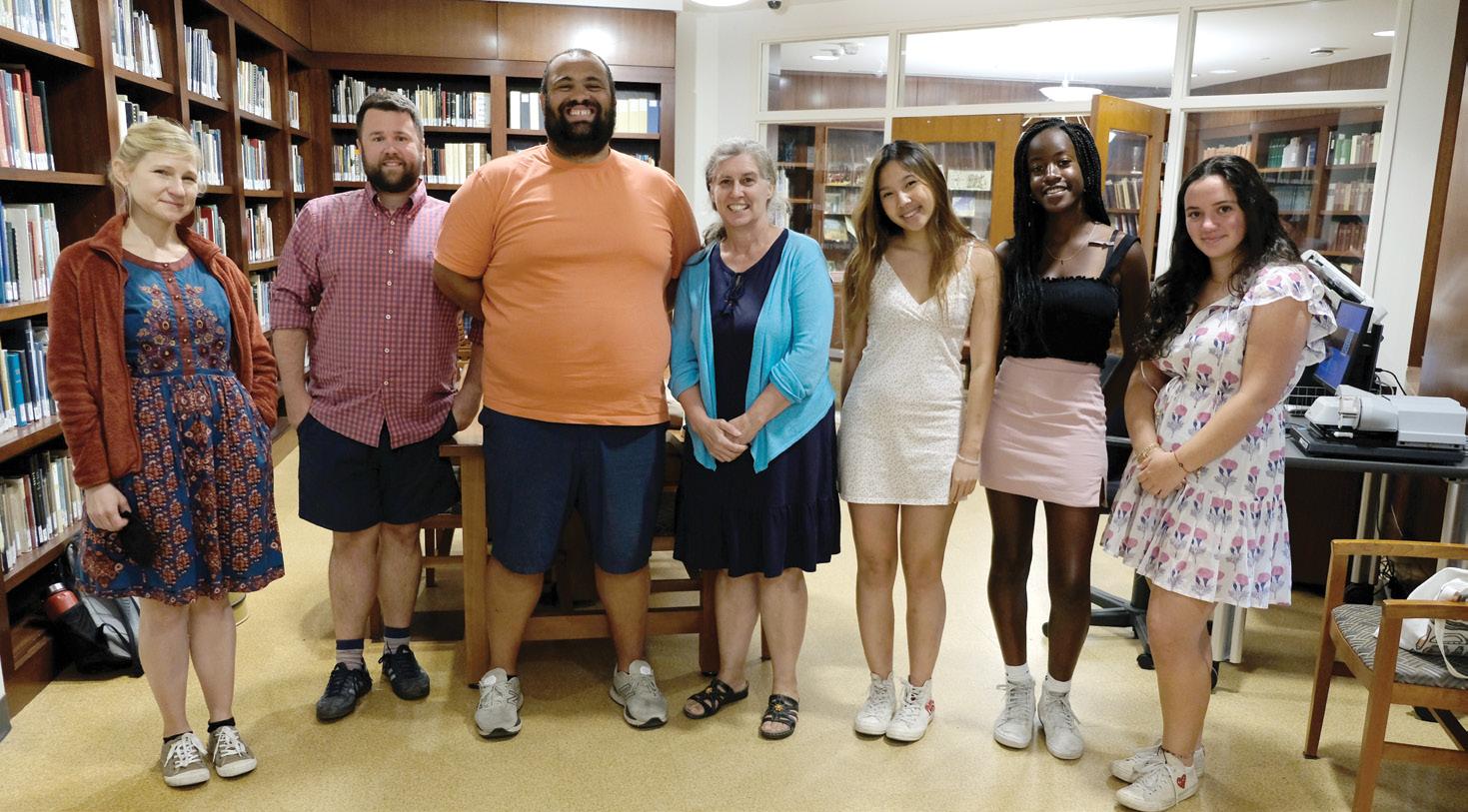
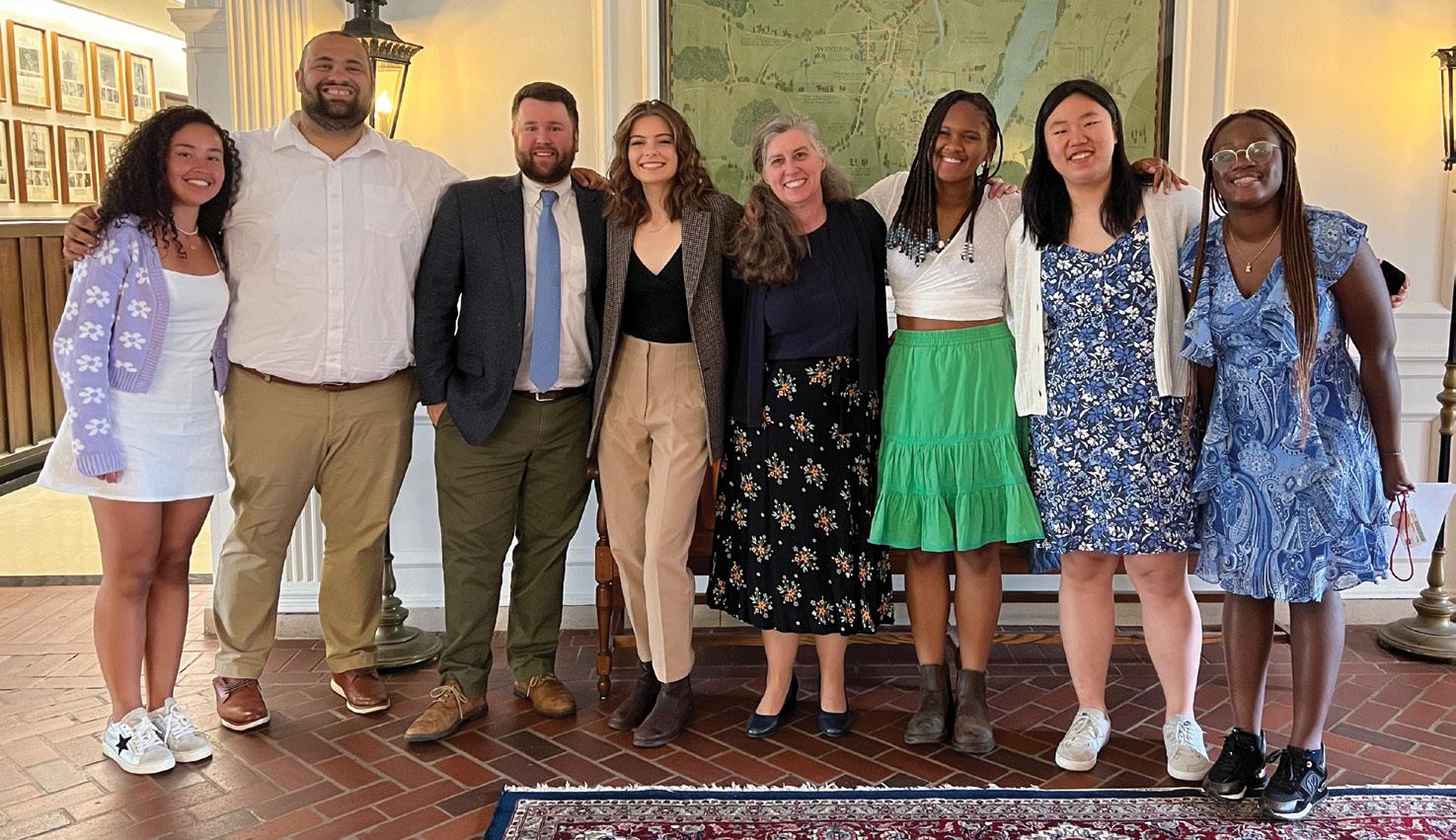
An interactive version of that timeline was originally brought to life by Lillie Szemraj ’22, who programmed it in the Python programming language. Lillie joined the project in the fall of 2021 as part of her work on an independent study project she was completing with Director of Digital & Computational Learning Kate Seyboth. Since the timeline covered a large period of time and contained a lot of information, “the goal was to develop an interface that [would] engage viewers and [allow them] to click through and filter for a specific range of dates, geographic areas, or themes,” Lillie says. The work of continuing to refine the timeline has been taken up by current seniors Ignacio Feged and Calvin Pan, who joined the project in its second year in the summer of 2022, along with five other members of their class — Savannah Mills-Hall, Chinelo Osakwe, Sal Katz, Kaylie Tan, and Riley Fried. Current juniors studying College-Level U.S. History have written brief summaries of the events on the timeline, offering even more context for users.
Concurrently with the creation of the timeline, the second group in the original team began conducting research on the enslaved people, drawing evidence from multiple sources, including census records, church records, bills of sale, newspaper advertisements, court documents, and manumission papers, which document a person’s release from slavery by their enslavers.
And, with the little information that was available, and by using the context and study of material culture from the time, they started weaving together narratives of the lives of
these enslaved people. The work is far from easy nor is it swift. It can be tedious, and the researchers have met with many dead ends. To a one, the student researchers say they were surprised by how little information there was in the historical record about the people they were studying.
“All we know about [a lot of them] is that they existed,” Calvin says. “We live in the Information Age, so it’s kind of hard to imagine that people in the past can have no historical footprint. If we hadn’t gone digging
for [information about them], there would be essentially no trace of them.”
Looking for those traces is what sent a group of three of the team’s students to Charleston, South Carolina, in the summer of 2022 to do some boots-on-the-ground research, alongside Elliott, Karen, and Eric. The group, which included Chinelo, Kaylie, and Riley, spent five days gathering background information and spending time in the archives of the South Carolina Historical Society at the College of Charleston, in the South Carolina
38 Loomis Chaffee Magazine Winter 2023
To a one, the student researchers said they were surprised by how little information there was in the historical record about the people they were studying.
Above: Mariapaula Gonzalez ’22; history teacher and Dean of Students Elliott Dial; head of the History, Philosophy & Religious Studies Department Eric LaForest; Lillie Szemraj ’22; history teacher and school archivist Karen Parsons; Rachel Cranston ’22; Stacey Zhang ’22; and Mercy Olagunju ’22 after presenting the research project-in-progress to the Board of Trustees in May 2022. Below: Mary Jo Fairchild, research services coordinator, Special Collections and Archives, College of Charleston Library; Eric; Elliott; Karen; and seniors Kaylie Tan, Chinelo Osakwe, and Riley Fried after a morning of research in the summer of 2022.
Room at the Charleston County Public Library, with church records, and in the city itself, searching. In addition to a visit to the Charleston Museum, they visited the house that Abigail and H. Sydney Hayden had rented when they lived in antebellum Charleston, and they studied compelling evidence that slave quarters stood on the property.
They found Abigail’s name in the church records, but there were many leads that turned into dead ends or wandered away from the questions the researchers hoped to answer. “It was frustrating at times,” says Chinelo. “We had to exercise patience, reminding ourselves that we were going to answer some questions with more questions.”
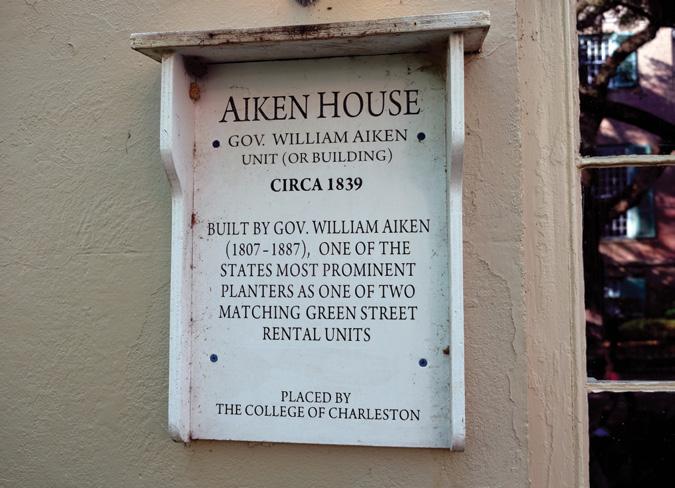
This kind of shoulder-to-shoulder work within the team and with faculty was what appealed to Savannah when she applied for the project as a junior. “The key thing that stood out for me was that students and faculty would be equals in this project,” she says. “They weren’t assigning work for us to complete. We were all approaching the subject with questions, all working together.”
As they have collaborated to tell new stories and shine new light on these enslaved people’s experiences — “which often go unheard and unrecognized,” notes Mariapaula — it has been important to the team to place their subjects at the center of their stories and to avoid re-inflicting violence and dehumanization in the re-telling of the subjects’ stories. “It’s very important to analyze each story with the same level of attention and respect that we give to (the Founders). We can’t have an accurate and informed interpretation of our history without looking at the lives of these enslaved people,” Chinelo says.
“Just calling them slaves instead of enslaved people is denying them humanity,” Calvin says. “We are trying to reverse that, making sure that they are recognized as actual human beings with their own individual stories to tell.”
“We should pause and see people in the past as more fully human,” as Eric puts it. “That’s what we mean by not perpetuating the violence of the archive.”
The intention is not to take away from the story of the Founders, according to the team, but to tell a fuller, more inclusive story.
“We have this great school, and our school’s Founders were super generous and had a vision for equitable education for everyone,” Savannah says. “But I think it’s important to complicate the narrative and talk about how the systemic racism we still see in America is rooted in enslavement and how that still plays out today in so many ways.”
Loomis Chaffee is certainly not the first institution to take a hard look at the history of slavery as it relates to the school’s own history, but Loomis is one of just two secondary schools, along with Phillips Andover Academy, that has joined the more than 90 institutions of higher learning comprising the Universities Studying Slavery
Consortium, which began at the University of Virginia.


In addition to ongoing research, next steps for the project include finding ways to share these stories — and the lessons that the team has learned — with the larger community. The team is working to create a website that will allow them to disseminate their work well beyond campus. When it launches this year, the site will share 19 biographies, which have been written by the team. Because so little documentary evidence is available, the narratives are, according to Eric, “frustratingly uneven and incomplete.” Some are fuller, including the one for Nancy Toney, about whom, relatively speaking, more is known. Nancy, who was moved to Windsor in 1785, was bequeathed in 1821 to
continues on page 42
loomischaffee.org 39
“Just calling them slaves instead of enslaved people is denying them humanity.”
— CALVIN PAN
Top: 10 Green Way in Charleston, South Carolina, a house that H. Sydney Hayden and Abby Loomis Hayden rented while living in the city before the Civil War. The house is now the office of the Honors College at the College of Charleston. Bottom Left: Another view of the house on Green Way. Outbuildings that included housing for enslaved persons were demolished for construction of the brick building on the left. Bottom Right: The sign on the front of the house. The Haydens rented the home from William Aiken Jr., a former governor of South Carolina (1844–46) and then a member of Congress (1851–57).
Clues to Personal Histories
Traces of information in census records, court documents, bills of sale, and other documents offered clues to the lives of the Black people who were enslaved the Chaffee, Loomis, and Hayden families in the 19th century. The student and faculty researchers wove narratives of the people’s lives based on these pieces of evidence and the contexts and material culture of the time.
Here is one of the biographical narratives from the project. Rachel Cranston ’22, Mariapaula Gonzalez ’22, and history teacher Karen Parsons collaborated on this account:
According to emancipation papers filed with the town of Windsor and reprinted in Jabez Haskell Hayden’s 1915 Historical Sketches, Sarah was “in her 34th year” in 1800. Enslaved before 1795 by Jonathan Butler of Hartford, Sarah probably worked alongside two other women enslaved by Butler. They are named in documents as Peggy Butler and Delira Butler. (Barbara Beeching, “African Americans and Native Americans in Hartford 1636–1800,” 1993.) Because these two women were known by the last name of their enslaver, it could be reasoned that Sarah was as well; evidence confirming this remains elusive.
TRANSCRIPTION: Windsor March 12th AD 1810.
Sold to Dr. Hezekiah Chaffee Sr. of Windsor in 1795, Sarah shared duties in this household also with two enslaved women, Betty Stevenson and Betty’s mother. (Christina Vida, “Remembering Sarah,” 2011.) Sarah had at least two children, Fanny Libbet, who was born in Hartford while Sarah was enslaved by Butler, and an infant noted but unnamed in Windsor Church records. This 4-month old child, who according to Connecticut law was designated as an enslaved person at birth, passed away a mere month before Sarah’s emancipation on September 15, 1800.
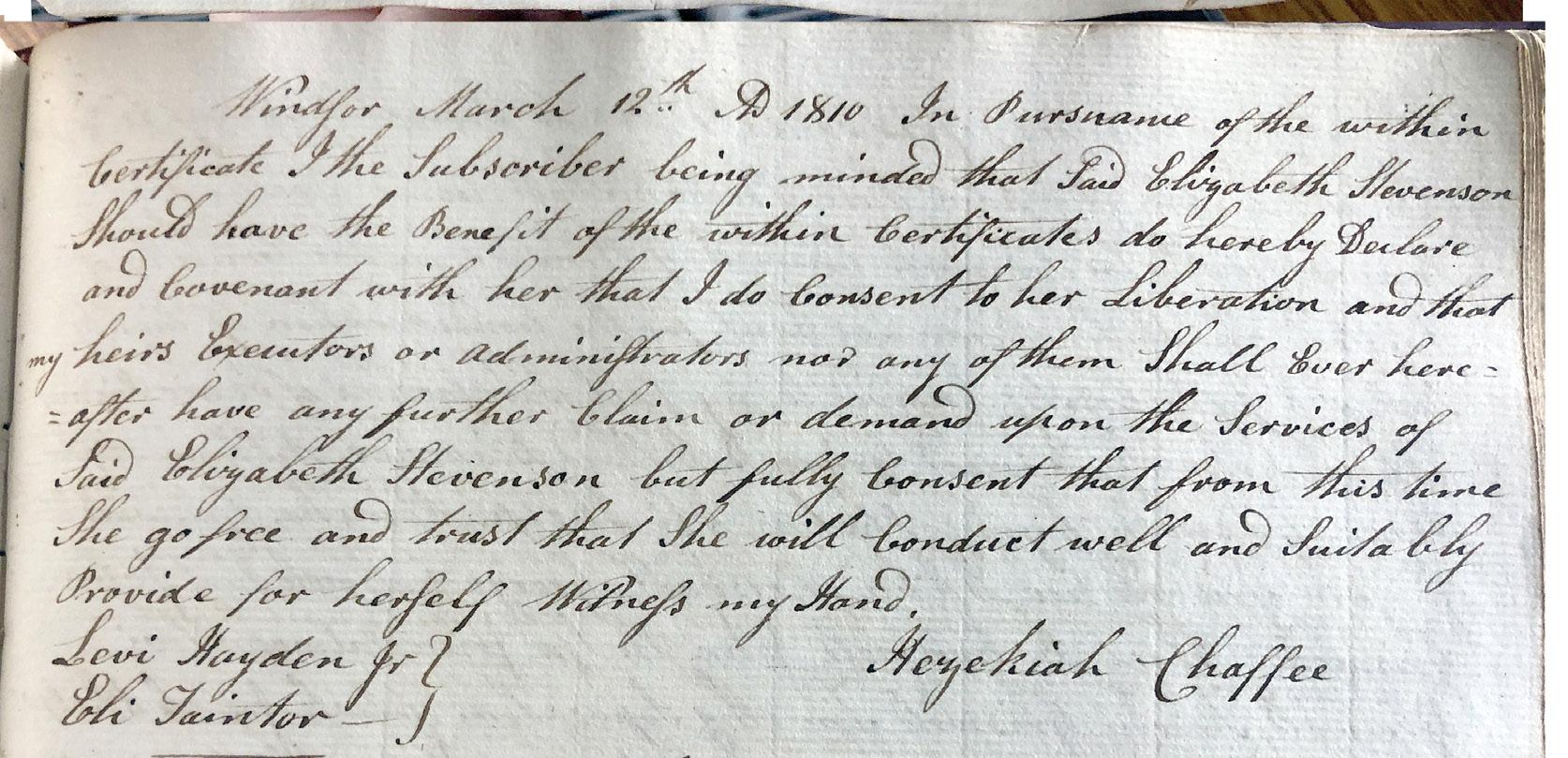
After her emancipation, Sarah’s life story is not documented in local records; however, more is known about her daughter Fanny. Fanny moved to Windsor in 1800, possibly to live closer to her newly emancipated mother. In 1817, the town of Windsor brought a suit against Hartford for the cost of
supporting Fanny Libbet and her two children; this suggests that Fanny had fallen on difficult financial circumstances. At that time, towns were required to support resident paupers, and it was not uncommon for more economically vulnerable people to move in search of work or family. In Fanny’s case, Windsor hoped to prove that Hartford was her place of “legal settlement” and therefore free itself from financial responsibility even while Fanny lived in Windsor. (David Menschel, “Abolition without Deliverance: The Law of Connecticut Slavery 1784–1848” The Yale Law Journal (Oct. 2001), pp. 183–222.)
Could Fanny’s residence in Windsor be proof of her mother’s residence as well or did Sarah embrace her newly appointed freedom by leaving Windsor, the state of Connecticut, or even the U.S.?
In pursuance of the within certificate, I the subscriber being minded that said Elizabeth Stevenson should have the benefit of the within certificates, do hereby declare and covenant with her that I do consent to her liberation and that my heirs, executors, or administrators nor any of them shall ever hereafter have any further claim or demand upon the services of said Elizabeth Stevenson, but fully consent that from this time she go free, and trust that she will conduct well and suitably provide for herself.
Witness my hand, Hezekiah Chaffee | Levi Hayden Jr | Eli Taintor
From the Windsor land records, vol. 23, pg. 347
Recorded March 12th AD 1810 • Test Elisha N. Sill, Register at the Windsor town clerk’s office
Above: Elizabeth Stevenson’s emancipation record, from land records in the Windsor town clerk’s office. (See transcription below.)
40 Loomis Chaffee Magazine Winter 2023
Below: A portrait of Nancy Toney (1774–1857), who was enslaved by the Chaffee and Loomis families for part of her life. The painting is attributed to Osbert Loomis, one of the five siblings who founded Loomis Chaffee, and dates from the period 1850–1880. Scholars note that it was rare for artists at the time to depict a Black working-class woman engaging with the viewer and thus elevating the image to a portrait of an individual rather than a household genre scene.

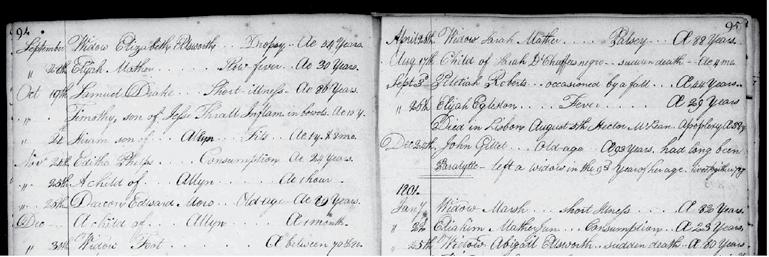
loomischaffee.org 41
Left: Death record of Sarah’s 4-month-old child, from Windsor Church records
continued from page 39
Abigail Chaffee Loomis, mother of the five Loomis Founders. While working to put Nancy “at the center of her own story,” as Karen says, the group also is working to dispel the persistent myth that she was “the last or one of the last slaves in Connecticut. Being able to see Nancy’s life outside the confines of slavery was revelatory,” Karen told the Board of Trustees when she, Eric, Elliott, and several of the students made a presentation about the project in the spring of 2022. “And it suggested that other information may have been obscured by that unquestioned narrative.”
“... the manumission process asked an enslaved person to state their desire to be unenslaved.”
 —
—
The students also composed a narrative for Betty Stevenson, born in 1791. Connecticut laws of the day determined Betty’s identity at birth as enslaved because her mother was enslaved at the time. Betty was enslaved by Dr. Hezekiah Chaffee Sr., grandfather of Abigail Chaffee Loomis. Betty’s emancipation in 1810 at age 19 is documented in the property transfer records in Windsor’s Town Hall, where they remain to this day. “A document concerning a person’s freedom is still considered chiefly a matter of property,” Eric notes. According to the biography for Betty that the team compiled, the manumission paper “also notes that Betty signified ‘her desire to be made free.’ While this may seem obvious to us, it is important evidence of the time period that the manumission process asked an enslaved person to state their desire to be unenslaved.”

The team is planning a series of discussions with groups on campus, including the student multicultural group PRISM, along with a virtual conference with other schools that are working on similar projects to share tips, tools, and best practices for doing this kind of research.
Stacey Zhang ’22 has taken what she learned through her involvement in the project with her to Amherst College, where she is a freshman and where she plans to major in history. “[It] strengthened my belief that history has a purpose in a modern sense. [It] left me unsatisfied, but in a good way. I want to learn more,” she says.
42 Loomis Chaffee Magazine Winter 2023
Eric LaForest
Top: Senior Riley Fried records her observations while investigating urban enslaved people’s dwellings at the Aiken-Rhett House in Charleston, a few blocks from the house that the Haydens rented. Aiken-Rhett House, managed by Historic Charleston, is a preserved urban townhouse complex showing enslaved people’s dwellings and work spaces much as they would have appeared in 1850. Bottom: Senior Chinelo Osakwe researches at the College of Charleston Special Collections and Archives last summer.
Visual arts teacher Mark Zunino has several workspaces in his office and the adjacent painting studio in the Richmond Art Center, and the objects on and surrounding those desks offer clues to the eclectic daily life of a teacher, artist, and creative thinker. Mark teaches painting, printmaking, and the College-Level Art Seminar at Loomis Chaffee, and he directs the school’s Adolf and Virginia Dehn Visiting Artist Program, which brings artists to campus to
Faculty Desks
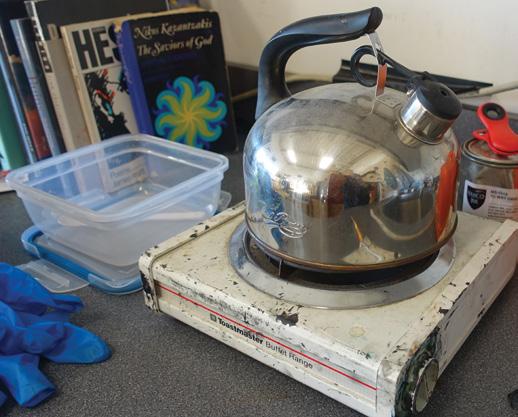
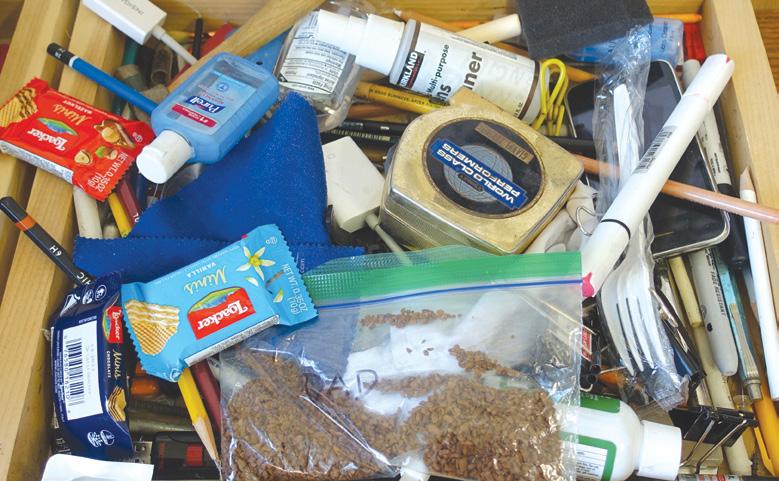
 MARK ZUNINO
MARK ZUNINO
work among the students for a week or two at a time. Mark’s relaxed, friendly personality sets a comfortable tone in the studios where he teaches and where his students drop by throughout the day to work on their paintings, prints, drawings, and other creative projects. The desk featured here is Mark’s “job desk,” where he does clerical aspects of his work. His office is also his studio, where he does his own artwork, primarily oil and watercolor paintings, drawings, and intaglio prints.

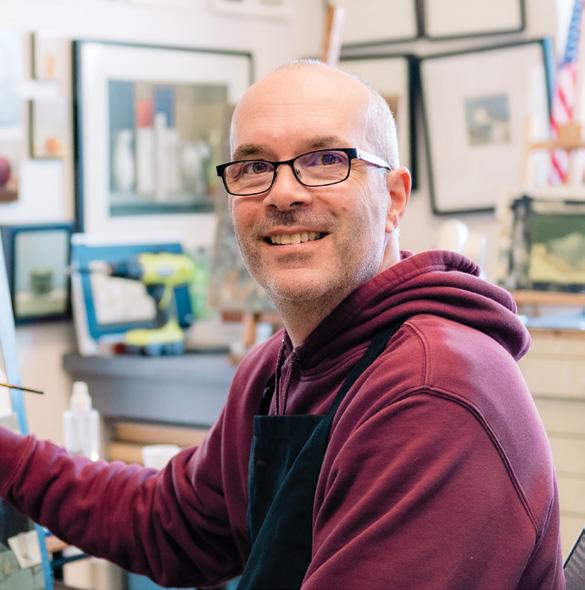

loomischaffee.org 43
A photograph of Mark and Lulu, his sweet and gentle beagle, during a fire drill last year. Sadly, Lulu passed away this fall after a long life with Mark and his family.
Picture of Mark by one of his students
Mark often relaxes between classes by playing his Fender Strat guitar.
Art on the walls around Mark’s desk is work that he has received from or traded for with students.
Mark keeps a kettle at the ready for when his advisees want hot chocolate.
A stack of art books from Mark’s collection. “I use images from those as inspiration constantly,” he says.
The tools of the trade and more

Names Stamped in Tin
It’s the name that catches your eye. Stamped across the once-gleaming tin surface, the incised “LOOMIS SCHOOL” announced to customers that cream from the school’s dairy herd had arrived. Delivered by the school’s milk truck to local creameries, faculty and nearby residences, and the Loomis and Chaffee school kitchens, this cream can and dozens like it, were essential to the school’s agricultural curriculum and farm production. This object and other surviving sources evoke Loomis’ vibrant, progressive dairy venture between 1914 and 1962. Keeping pace with the American dairy industry at that time meant striving for herd genetics that produced increasingly more butter fat in milk. The award-winning Loomis cows did just that, filling more and more metal cream cans each year through the first half century of the school’s history.
The original dairy barn, located on the site of the current Ratté Quadrangle, was designed
 By Karen Parsons, Loomis Chaffee History Teacher & School Archivist
By Karen Parsons, Loomis Chaffee History Teacher & School Archivist
in 1914 by the school’s architects, Murphy and Dana. It included many special use areas, including one for milk processing and a pouring room adjacent to the stanchions where cows were milked. The Loomis Log declared in January of 1927 that “a new and thoroughly modern milk house” had been constructed next to the barn. A gift of Gerard Swope, president of General Electric and father of David Swope ’25 and John Swope ’26, the idea originated with David, who had studied in the agriculture program and, directly after Loomis, worked in Irvine, California, as a ranch hand and later in Chicago as a shop hand in the McCormick Works of the International Harvester Company. While in Chicago, he lived at Jane Addams’s Hull House and taught manual training there.
Moving milk processing out of the barn meant more room for calves, heifers, and milking cows; space for a new classroom in
the milk house; and the most up-to-date facility for cooling, separating, pouring, and bottling milk and cream from the herd’s 50 cows. In 1927, The Hartford Courant reported these cows produced an average of 350 quarts of milk a day; the school alone used 275 quarts every day and made ice cream, butter, and other dairy products using the farm’s milk and cream. Production increased over

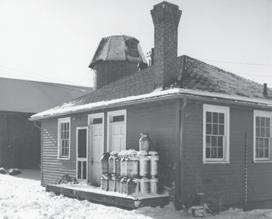
Opposite Page: Cream cans like this one preserved in the Loomis Chaffee Archives once carried fresh cream from the milk house to local creameries, residences, and the Chaffee and Loomis school kitchens. Above (Left): Agriculture teacher Joseph Goodrich, who taught at Loomis from 1915 to 1921, poses one of the school’s cows. (Middle): The milk house, pictured here in 1935, was built in 1927 and enabled the farm to use the most up-to-date methods for processing and bottling milk and cream from the herd’s cows. (Right): The milk house in winter with milk cans.
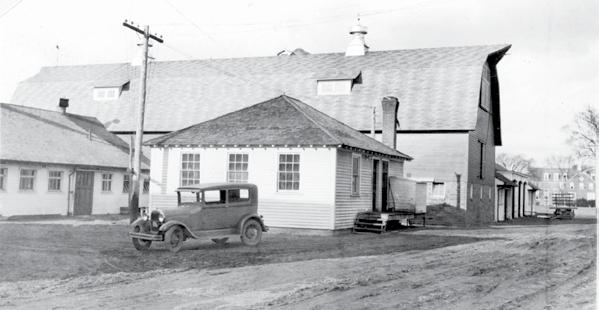
loomischaffee.org 45
OBJECT LESSON
time: In 1939, 40 milking cows produced over 600 quarts a day, and in 1951, 56 milking cows supplied 900 quarts — 1,800 pounds of milk — a day. Fourteen-year old Daleormsby Martha, perhaps the most heralded milk cow to live at Loomis, joined an elite bovine group in 1962. Honored by the HolsteinFriesian Association of America, she surpassed the lifetime production mark of 160,000 pounds of milk. Her career butterfat total to date was an impressive 5,670 pounds.
The 24 foot-by-30 foot, two-room, woodenframe milk house was a study in temperature contrasts, all for the purposes of preventing and killing bacteria in milk. Ice water tanks and a built-in refrigerator cooled raw milk brought directly from the barn. After cooling, it was put through a cream separator four times and cream skimmed off and stored in metal cans while milk was bottled for households or put into larger tin milk cans for the school’s kitchen. Both were stored in ice water or refrigerated before delivery. Washing and sterilizing bottles, cans, strainers, and other objects used in processing required intense heat. Steam pipes lining the milk house’s sterilizing room maintained a temperature of 240 degrees Fahrenheit. Around 1938, the school purchased a pasteurizer used to heat milk to kill bacteria before bottling.
Headmaster Nathaniel Batchelder shared his excitement for the new milk house in his January 28, 1927, letter to The Log. “There has been an immediate improvement in the quality of our milk. … At the same time, we have improved the milk in richness by introducing some Guernsey cows into our Holstein herd.” The herd manager had recently asked Evelyn Longman Batchelder, Mr. B’s spouse, “to name the first two Guernsey pure-bred heifers born here. Between us we hit upon the idea of taking the names of famous women sculptors,” and the two calves were named after Bessie Potter and Anna Hyatt, the only two women sculptors “besides Mrs. Batchelder who have been honored by full membership in the National Academy of Design.” Batchelder closed his letter, “We hope that the progress of art and the progress of agriculture, as represented in our dairy herd, will be equally steady and distinguished.”
Progressive ideas could be found in the agriculture curriculum, which focused on current trends in research-based food animal and vegetable production. Using this
In 1927, The Hartford Courant reported these cows produced an average of 350 quarts of milk a day; the school alone used 275 quarts every day and made ice cream, butter, and other dairy products using the farm’s milk and cream.
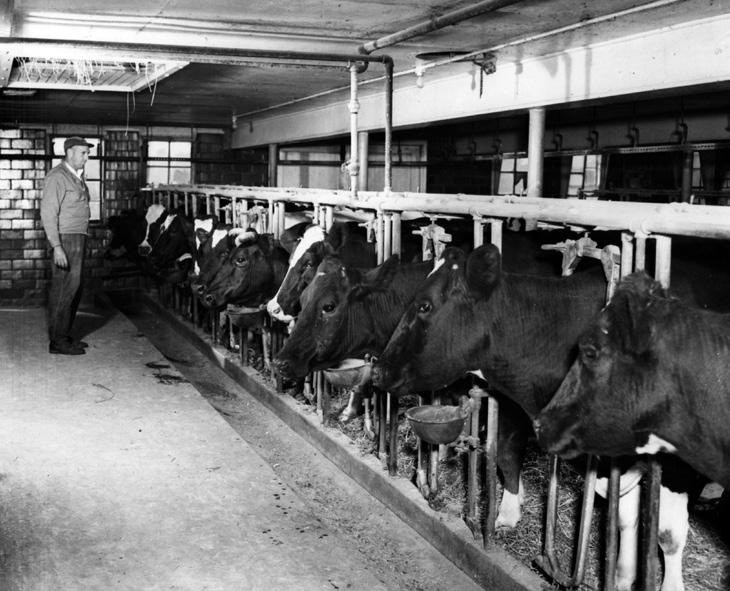
knowledge, students in the program designed their milk house classroom. The Log described this as “a testing laboratory, efficiently equipped with all the necessary apparatus for thoroughly testing milk and milk products such as a steam centrifuge, [a] moisture test for butter,” and a Babcock milk tester used to determine the fat content and quality of the milk. Every student who was enrolled in this curriculum did a major project with the dairy herd during his senior year. The formal study in agriculture was phased out in 1930. For about 15 more years, students could earn diploma credits and prepare for college study with projects undertaken on the school farm. In 1962, the full herd of 130 registered pure-bred Holsteins — the then preferred breed of dairy cow — was dispersed at auction, the farm closed, and the buildings razed.
This chapter of school history can be pieced together from the architectural plans for the original dairy barn, photographs, newspaper articles and other accounts of the farm, herd records, this cream can, a Loomis milk bottle, and even the weathervane
that perched atop the main barn; these are all preserved in the Loomis Chaffee Archives. A closer look at the cream can in the school’s collection reveals another name stamped into each of the handles: “FOLLANSBEE.” Manufactured by the Pittsburgh-based Follansbee Brothers Company in its West Virginia factories, cream cans were just one object in the company’s galvanized tin dairy wares line. Founded by William U. Follansbee and his brother Benjamin in 1894, with their two brothers joining later, the company had a long and successful family ownership until its sale in 1954. William served as president and chairman of the company’s board and is the grandfather of Nat Follansbee, associate head of school for external relations. Nat’s upcoming retirement concludes his own long and successful run of more than 40 years at Loomis Chaffee. There’s no doubt, the names Loomis and Follansbee go well together.
46 Loomis Chaffee Magazine Winter 2023
Above: Myron Hoxie, farm manager from 1934 to 1956, surveys some of the Holstein herd in the barn. (Photo by William M. Rittase)
NEWS FROM THE ALUMNI/ DEVELOPMENT OFFICE

NEWS FROM ALUMNI / DEVELOPMENT

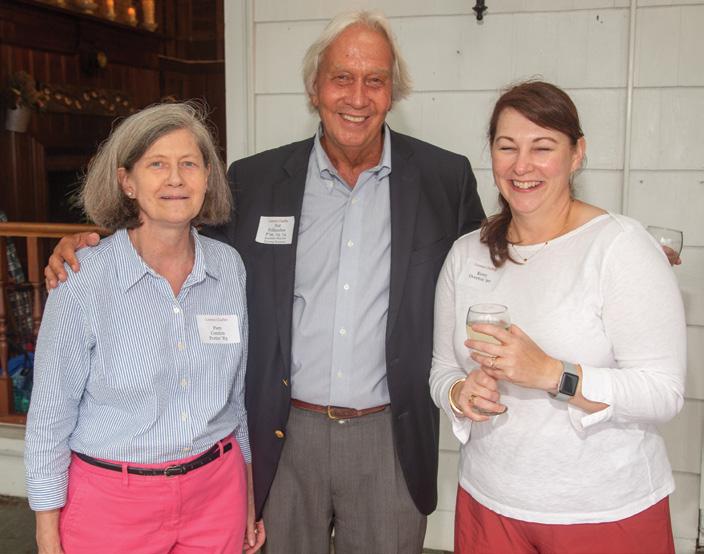
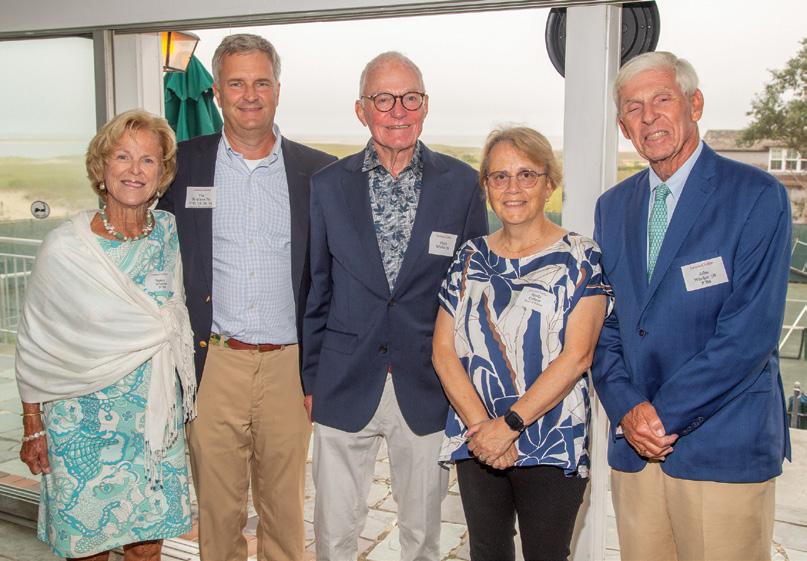
ALUMNI GATHERING
Pelicans at the Ballpark
JULY 9, 2022 • FENWAY PARK

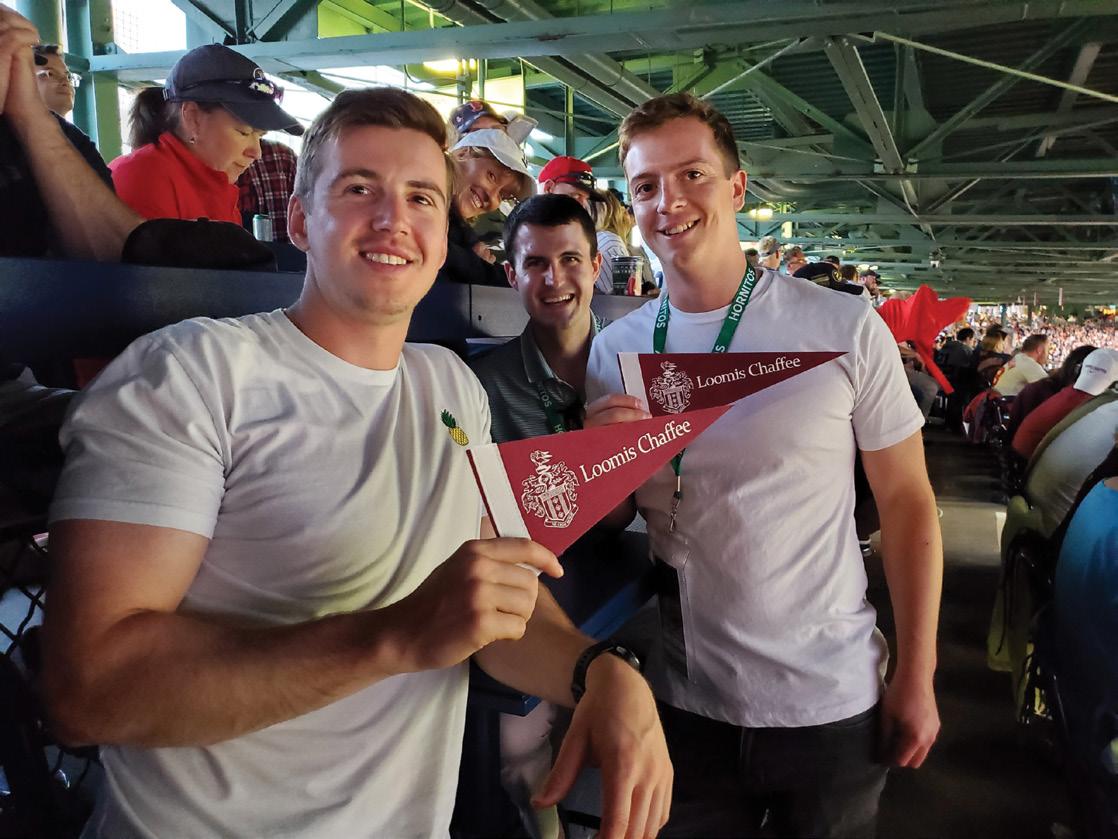
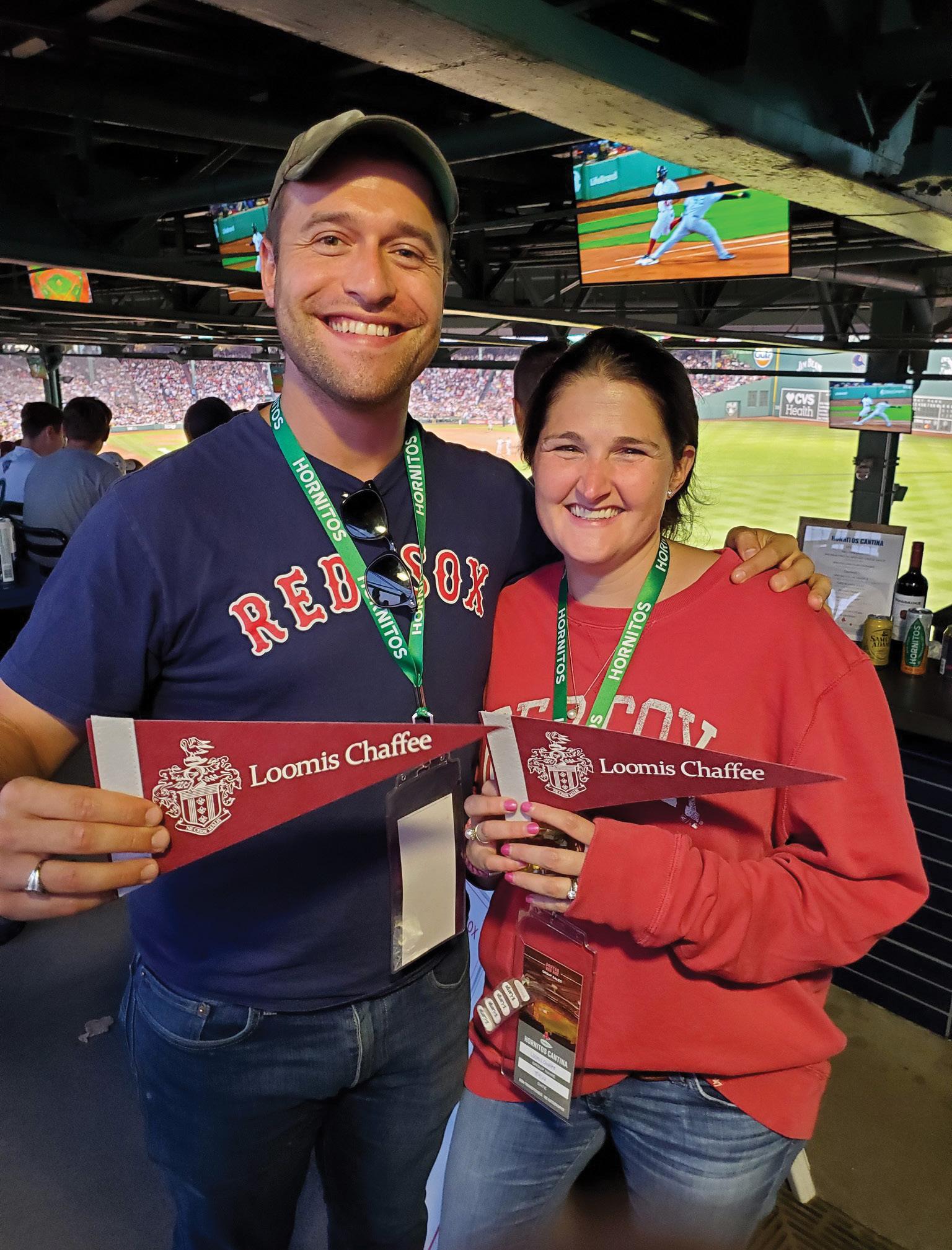
ALUMNI GATHERING
Chatham Reception
48 Loomis Chaffee Magazine Winter 2023
Left: Elliot Creem ’06 and Catherine Caldwell Velez ’03
Top Right: David Olio ’13, Jake Robbins ’10, Henry Tobin ’14 Right: Aaron Byrne ’91 and Brian Byrne ’89
AUGUST 22, 2022
CHATHAM BEACH & TENNIS CLUB
Left: Pam Condon Porter ’83, Associate Head for External Relations Nat Follansbee, and Kerry Overton ’90 Middle: Director of Development Tim Struthers ’85 and Head of School Sheila Culbert with hosts Nancy Whelan, Charles Whelan ’59, and John Whelan ’58, P ’86 Right: Sharon and Tom Shea ’69
Boston Reception
SIGMUND S. WISSNER-GROSS ’70
After graduating from Loomis in 1970, I got to know the school again decades later through the eyes of a current student whom I mentor. Through that experience, I have developed an even deeper appreciation for the wonderful education Loomis Chaffee provides.

It was serendipitous that my mentoring experience coincided with our class’s 50th Reunion. Our 50th Reunion planning was an extended effort because the pandemic postponed our event, and we finally were able to gather on the Island in June 2022. To renew excitement for the long-delayed event, a member of our class put forth a gift planning challenge last spring: He would add a significant amount to the Class of 1970 Scholarship (which our class created as a part of the reunion planning process) if five additional classmates indicated that the school was in their estate plans.
SEPTEMBER 28, 2022 • THE ’QUIN
I had been contemplating designating the school as a beneficiary of my IRA, and this class challenge opportunity seemed to be the right time to let the school know of my intentions of adding to the Class of 1970 Scholarship through a planned gift. It was easy to do; I would encourage others to explore this option. Financial aid support is critical to the school’s mission of being able to support students who need financial assistance.
For more information about planned gifts and the John Metcalf Taylor Society, please contact Associate Director of Development Heidi E.V. McCann ’93, P ’23, ’25 at 860.687.6273 or heidi_mccann@loomis.org.
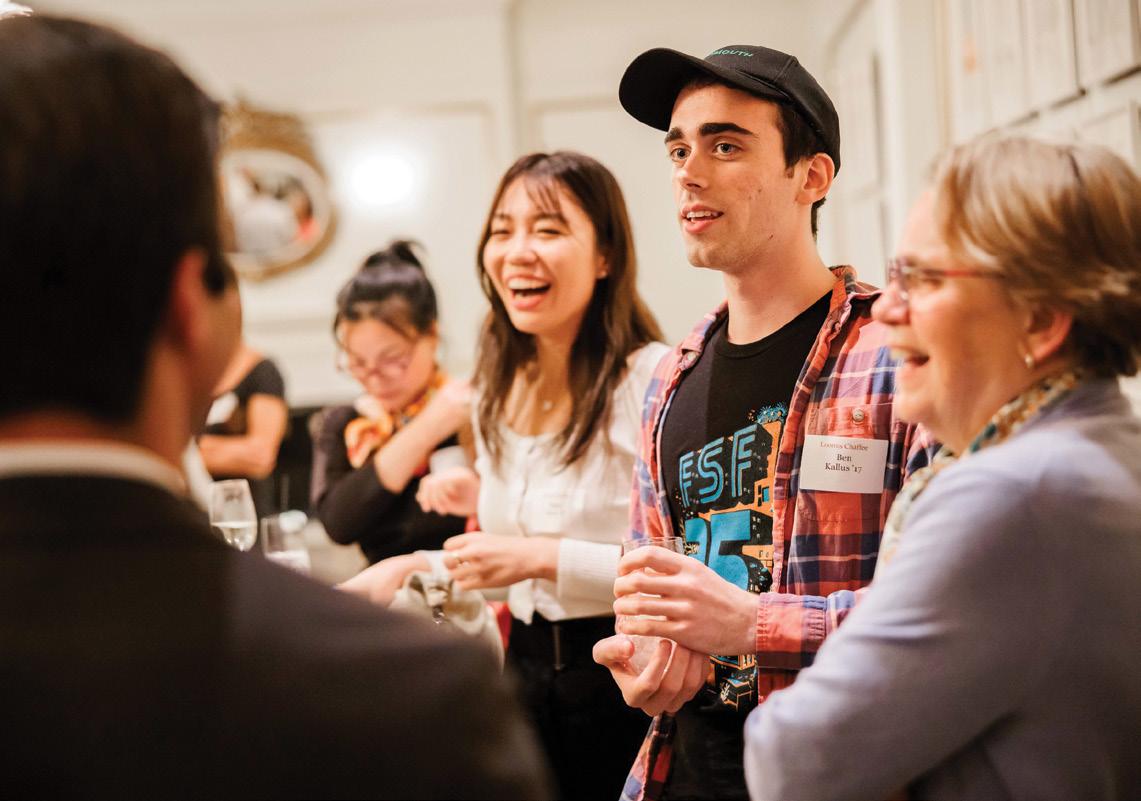
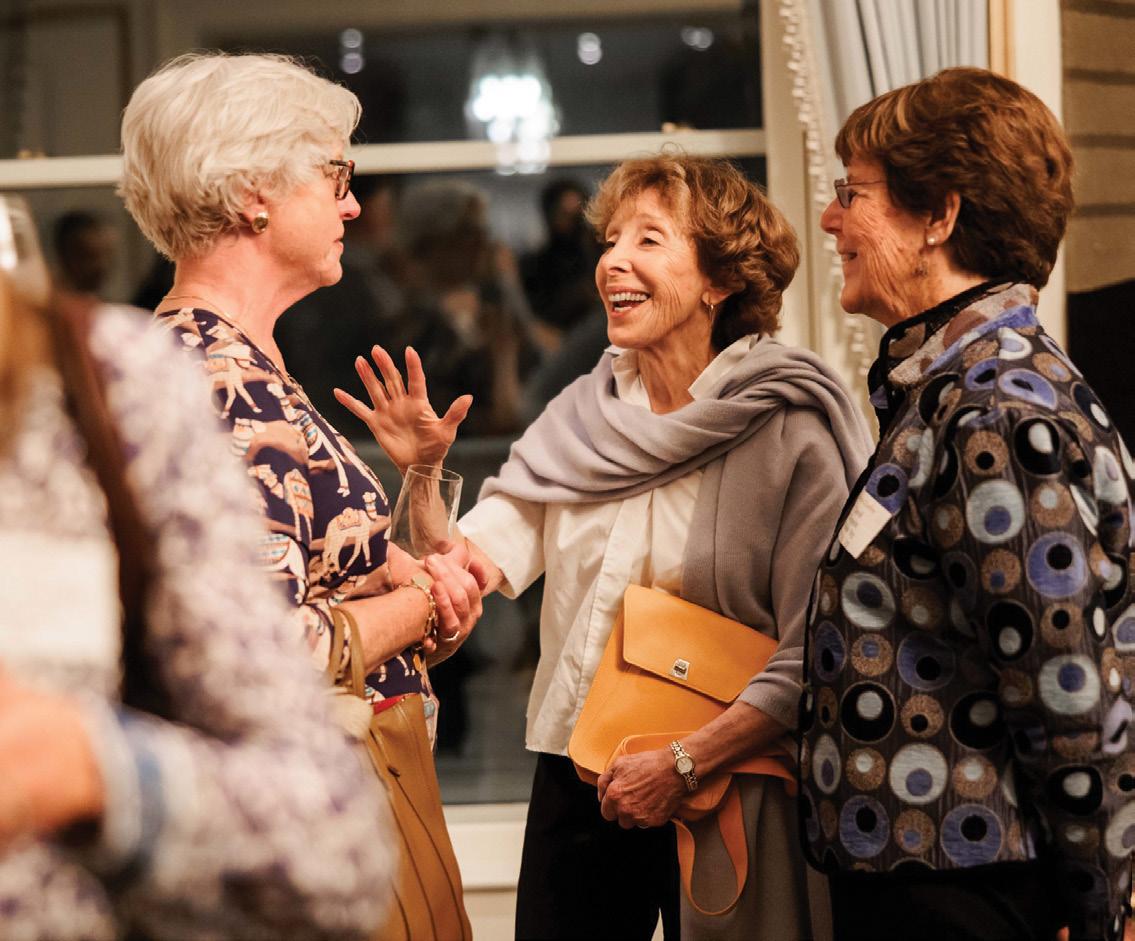
www.loomischaffee.giftplans.org

loomischaffee.org 49
Top: Susan Tracy Moore ’74, P ’01, ’04, Debbie Savitt First ’59, P ’86, GP ’19, and Carol Toppin Walsh ’63, GP ’23, ’25 Middle: Hosts Marc Rubenstein ’82 and Jill Hai Bottom: Anna Zhou ’17, Ben Kallus ’17, and Head of School Sheila Culbert
ALUMNI GATHERING
Hartford Reception

OCTOBER 26, 2022
HARTFORD GOLF CLUB
Top Left: Jones Boateng P ’24, Vincy Midodzi P ’24, Simone Moales ’21, Paul Wingle P ’22, Ileana Wingle P ’22, and Helen Wang P ’15, ’18, ’22 Top Right: Kate and Jonathan Dixon P ’89, ’92, ’95 and Betsy Mallory MacDermid ’66, P ’94, ’96 Left: Host Nancy Covello Murray ’82, P ’13, Head of School Sheila Culbert, and Associate Head for External Relations Nat Follansbee
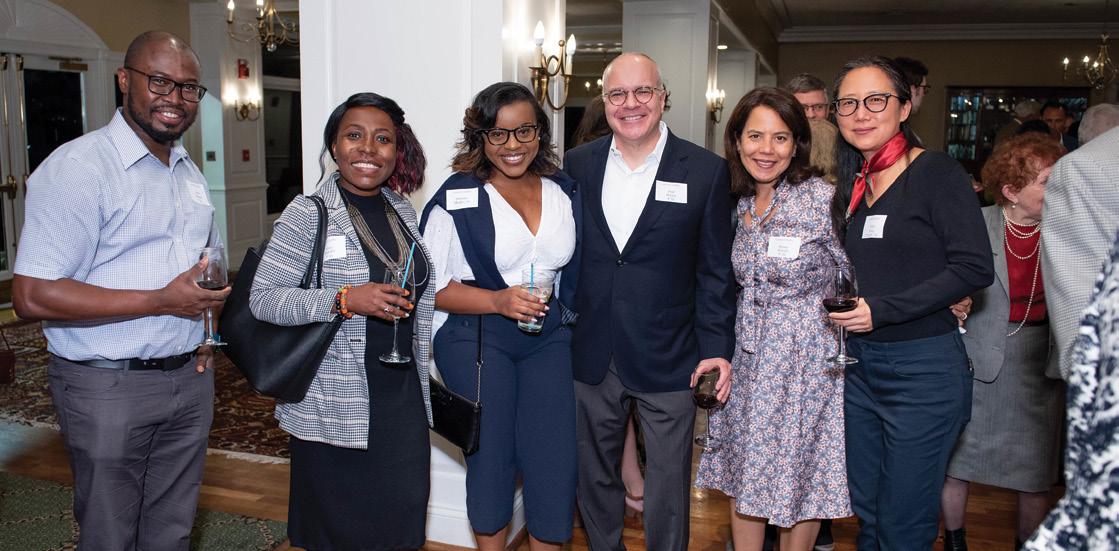
Right: Norma Antico P’97, Kevin Wilcox ’02, Kristina Peterson ’05, Kurt Malec ’00, Joey Selden ’03, and Jeff Lahrmann ’04
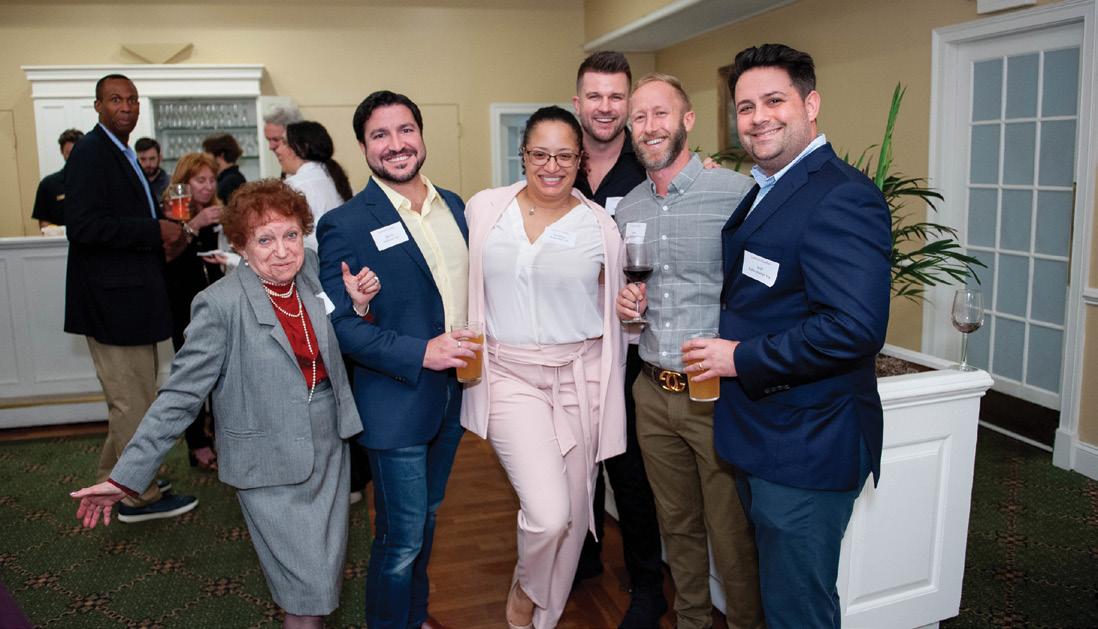
CHAFFEE BOOK CLUB
Chaffee Book Club
November 2, 2022
On Juneteenth by Annette Gordon-Reed
Discussion leader: Head of School Sheila Culbert
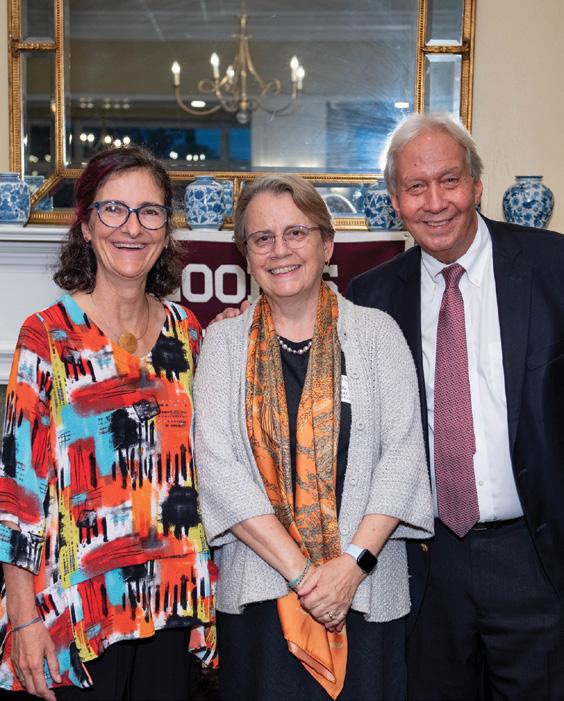
The fall gathering of the Chaffee Book Club featured one of Loomis Chaffee’s fall Book Chat selections — On Juneteenth by Pulitzer Prize-winning author Annette Gordon-Reed. Head of School Sheila Culbert hosted dinner in her home and facilitated robust discussion of the collection of personal essays of Juneteenth’s importance in American history.
Attendees: Lisa Silvestri ’71, Anne Shepard King ’68, Beverley Earle ’68, Carey Bartram Meltzer ’73, Head of School and discussion leader Sheila Culbert, Betsy Mallory MacDermid ’66 (kneeling), Kate Butterworth Valdez ’67, Anne Schneider McNulty ’72, and Jane Torrey ’67
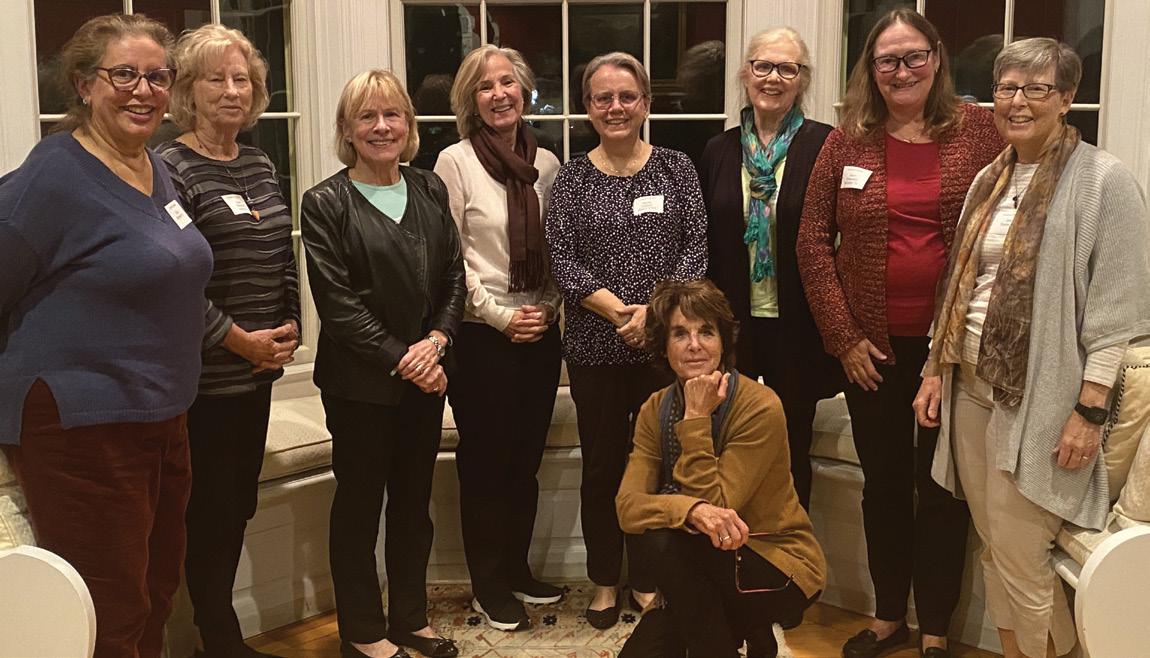
50 Loomis Chaffee Magazine Winter 2023
ALUMNI GATHERING
Submit a Class Note Send your news to us!
the Class Notes Editor at magazine@loomis.org to share news with classmates and friends. High-resolution photographs are welcome; please clearly identify all people. ALUMNI / DEVELOPMENT
Email
JOIN LC Connect
Loomis
alumni engagement platform
LC Connect is an online community and resource for alumni that makes it easier than ever for Pelicans to stay connected to each other and with the school. LC Connect is an opt-in networking platform, powered by Graduway, that enables alumni to:
• Find and re-engage with fellow alumni through the online directory and groups
• Expand professional connections through mentorship opportunities and a job board
• Stay up to date with Loomis Chaffee news and activities through an alumni events board and the school’s social media channels
• Have on-the-go access through the LC Connect mobile app
Register
LC Connect replaces Loomis Chaffee’s Evertrue app and Career Network, upgrading the alumni experience by providing several resources in one platform.
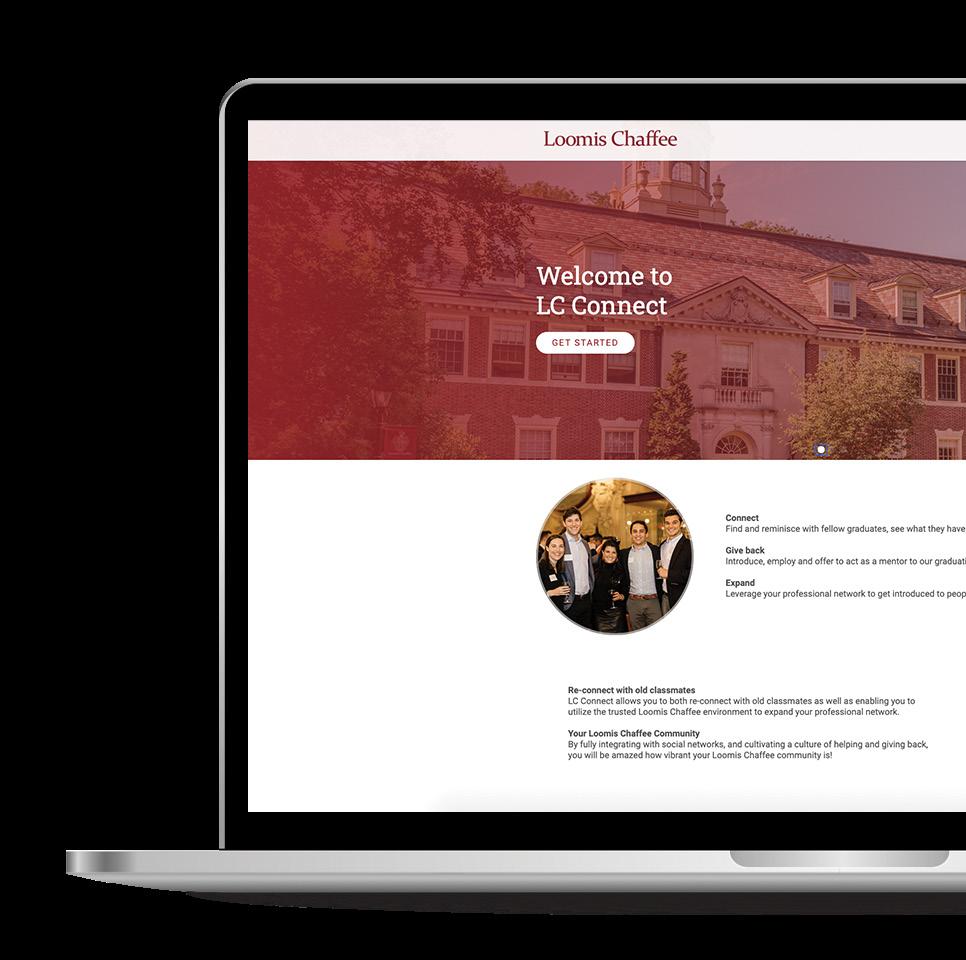
Every February members of the Loomis Chaffee community come together to make an impact on the lives of our students and faculty by participating in Philanthropy Day. Join fellow alumni, parents, and friends to make this year’s Philanthropy Day a success.

www.loomischaffee.org/
look forward to seeing you soon at one of the upcoming gatherings.
loomischaffee.org 51
ending in 3s and 8s — this is your year! Mark your calendar for Reunion Weekend and join us on the Island for the festivities. Visit www.loomischaffee.org/reunion for more information or call 860.687.6815. SAVE THE DATE | JUNE 9–11, 2023 REGISTRATION OPENS THIS SPRING!
THE DATE Philanthropy Day Challenge 2023 THURSDAY, FEBRUARY 23
with
at regional receptions across the country. Visit www.loomis.org/alumni for event
We
Classes
SAVE
Reconnect
fellow alumni
information.
at www.loomischaffeealumni.org
Chaffee’s
philanthropyday Linked In–Search for Loomis Chaffee Alumni Page Name Loomis Chaffee Alumni Tweet to and follow @LC_AlumniNet STAY IN TOUCH ALUMNI / DEVELOPMENT CONNECT WITH US ON SOCIAL MEDIA

1945
Jean Parmelee Sodaro, on June 28, 2022, in Downers Grove, Ill. A four-year student from Windsor, Conn., Jean was active in Glee Club, soccer, and school theatrical productions, and she was a typist for Chiel. According to the family obituary, Jean enjoyed a long and full life. She loved animals, travel, and archaeology and was active in politics. She served as a congressional aide for U.S. Rep. Henry J. Hyde for more than 26 years. Jean was predeceased by her former husband, Dean J. Sodaro, and her mother, Violet Wilson Parmalee ’20. She was survived by her children, Sheryl, Jonathan, Jeffrey, and Holly; her 10 grandchildren; and her seven great-grandchildren. A funeral was held on July 12, 2022, followed by internment at Queen of Heaven Cemetery in Hillside, Ill.
1946
Donald D. Borden, on October 17, 2020. A one-year student from Westport, Conn., Don was involved in the Glee Club and the Spanish Club. He participated as a cast member in a production of York Nativity Play and was a member of the soccer, hockey, and tennis teams. After graduation, Don attended the University of Connecticut before beginning his career in business. He was a well-respected business leader in Riverside, Calif., becoming the inaugural president of Luxfer USA Limited. Don was an avid golfer and, according to his friends, an “all-around great guy” who always tried to “put himself in the other person’s shoes” when analyzing any situation. Preceded in death by his wife of 57 years, Judith Day Borden, Don was survived by his sons, Bill and
OBITUARIES
Tom, and their spouses; four grandchildren, Ryan, Tyler, Brooke, and Summer; and one great-grandchild, Sophia Jo.
1947
Fletcher Van Gorder Parker, on July 19, 2022, at his home in Cromwell, Conn., with family and friends nearby. A four-year student from Hartford, Conn., Van was involved in the Work Squad, Darwin Club, Firefighting Squad, Ping Pong Club, Special Projects Group, and Ski Club. He also served on the Senior Library Committee and Senior Scholastic Committee and was a member of the soccer, riflery, tennis, and football teams. After graduation, Van attended Middlebury College and Yale Divinity School. He then began a 40-year career as a parish minister. He met his wife, Lucille, who later became a staff member at Loomis Chaffee, while serving as a pastor outside of Cincinnati, Ohio. They married in 1959 and moved to Clare, Mich., where Van continued his ministry. In 1968, Van and Lucille moved to Windsor, Conn., where he spent the next 27 years serving as the senior minister at First Church in Windsor. Retiring in 1995, Van and Lucille split their time enjoying their family and many friends in West Hartford and their home in Danville, Vt. According to the family obituary, Van was a “person of deep faith and optimism” and a “champion of the underdog.” He spent his retirement years gardening, rooting for the Red Sox, traveling, and writing poetry. Preceded in death by Lucille, Van was survived by his children, Susan G. Parker, Elizabeth Parker Murnaghan, and Douglas Parker ’82, and their spouses; and six grandchildren. A memorial service was held on September 24, 2022, at the First Church in Windsor.
1948
Joyce Green Wilson, on July 23, 2020, at her home in Salem, Ore. A four-year student from Windsor, Conn., Joyce was involved in the Library Committee, Drama Costume Committee, and Nominating Committee. She also served as the secretary of the Student Council and was a member of the soccer team. After graduation, Joyce attended Middlebury College, earning a bachelor’s degree in French. Joyce taught French and Spanish in her early career before marrying Donald P. Wilson after a summer romance while they were working on the same project in France. She had three daughters while living in California and moved to Oregon in 1971. In Oregon, Joyce became involved in the Southeast Asian refugee program at Chemeketa Community College, where she taught English as a second language and eventually became the program director. In the late 1980s, she spent four years as the director of education at a refugee processing center in the Philippines. After returning to the United States, Joyce spent her remaining career as an adult student advisor for Linfield College. She was a pioneer in her field, had a passion for helping people, and loved skiing, world travel, scuba diving, hiking, Bible study, reading, and the arts. Preceded in death by her husband, Donald, Joyce was survived by her younger sister, three daughters, grandchildren, nieces, nephews, and numerous dear friends across the globe.
William Monteith Vibert, on June 10, 2022, in Granby, Conn., four days shy of his 93rd birthday. A three-year student from Unionville, Conn., Bill was involved in the Athletic Council and served as a study hall supervisor and as vice president of the
loomischaffee.org 53
L Club. He was also a member of the Library Committee, Dining Hall Committee, Athletic Council, Nominating Committee, and Spring Dance Committee. In addition, Bill was a member of the football, basketball, and baseball teams. He received the Evelyn Longman Batchelder Prize for Sportsmanship at Commencement. Later in life, Bill contributed to the school as a member of the Common Good Society. After graduation, Bill earned his undergraduate degree in history from Trinity College in Hartford, Conn., where he played football all four years and still holds three Trinity College individual game records related to most extra points made by kicking. Bill met and married his wife of almost 71 years, Patricia Parker, on September 1, 1951. After graduation from Trinity, he and Pat drove to Long Beach, Calif., for him to complete training at the U.S. Navy’s Officer Candidate School, where he was assigned duty as the operations officer on the USS Strickland, stationed in Newport, R.I. In 1954, he joined the reserves, retiring after 20 years with the rank of lieutenant commander. After he completed his active duty, Bill attended the University of Iowa, earning a graduate degree in modern European history in 1956. He began his career teaching history at the John Burroughs School in St. Louis, Mo., eventually holding the role of department chair and coaching football and baseball. After 14 years at the school, Bill and Pat returned to Connecticut with their three children, and Bill joined the faculty of the Westledge School in West Simsbury, Conn. He continued to teach history, was director of studies, and then served as director of the school from 1972 to 1976. After 21 years of teaching, Bill enjoyed a second career in real estate, working with the Barrows Company, which merged into Merrill Lynch Realty and eventually became Prudential Connecticut Realty. He managed offices in Granby, Simsbury, and West Hartford. During his career in real estate, Bill served as the board chairman of the Greater Hartford Multiple Listing Service, president of the Greater Hartford Association of Realtors, and president of the Connecticut Association of Realtors. He was also very active in Granby, the town in which he lived for more than 52 years and where he served on the Granby Board of Education and the Granby Board of Selectmen. He also served as the president and treasurer of the Salmon Brook Historical Society for several terms and was a member for 50 years. In addition, Bill kept active
serving as a volunteer trustee on the boards of numerous local historical and community associations. He loved and was proud of his family, quietly supporting and encouraging his children, playing endless games of catch, and thrilling in their accomplishments. He was kind, thoughtful, funny, and always willing to help anyone. Preceded in death by his sister, Isabel Gilchrist Benton, and five brothers, Ruthven Monteith Vibert, Robert King Vibert Jr., Peter Loomis Vibert ’41, John Witherspoon Vibert, and Thomas Monteith Vibert, Bill was survived by his wife, Patricia; his three children, Mark, Carrie, and Todd, and their spouses; four grandchildren; one great-grandchild; numerous nieces and nephews; and many friends.
1949
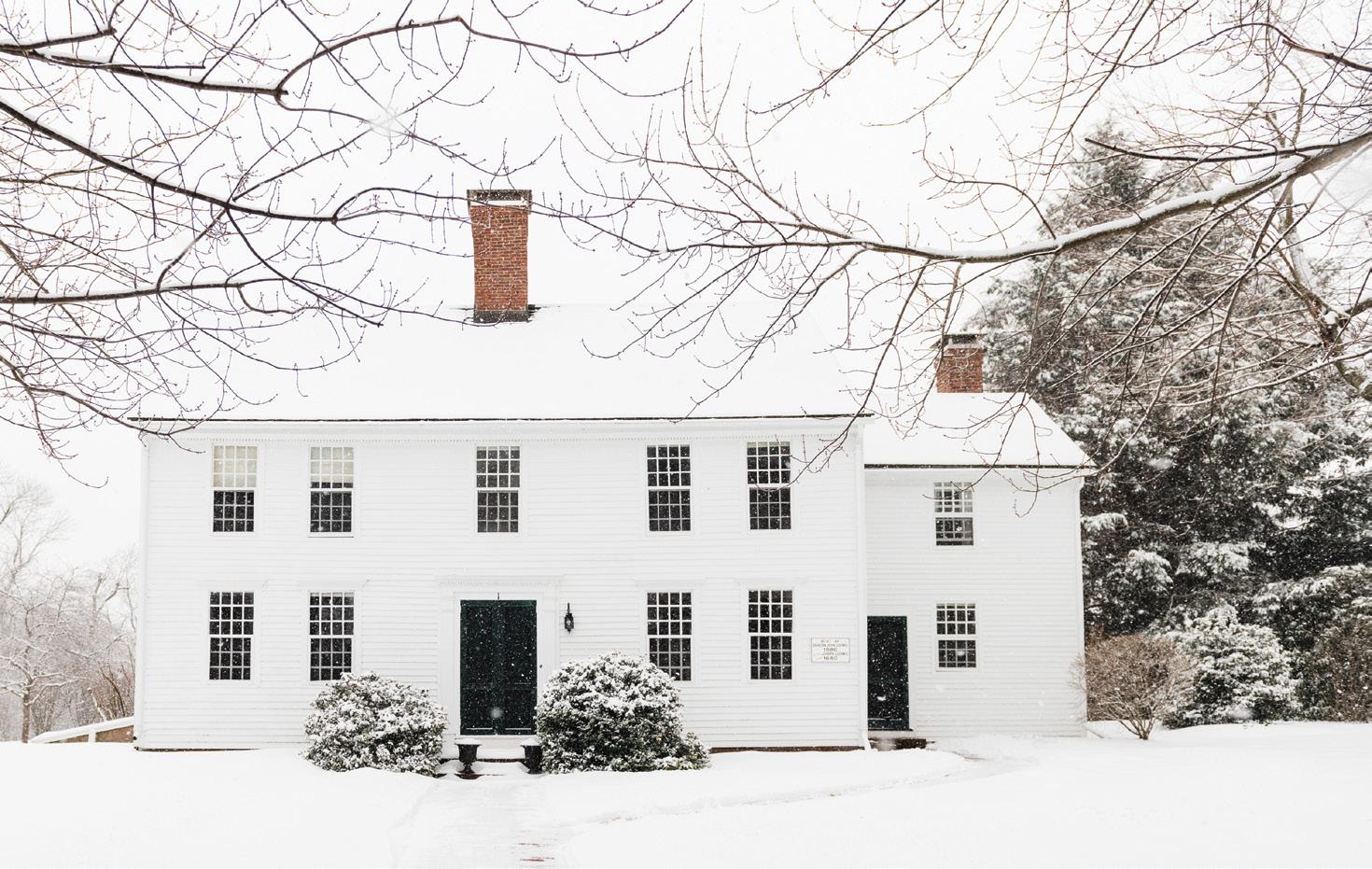
Philip Ford Parshley Jr., on July 16, 2022. A three-year student from West Hartford, Conn., Phil was involved in the Nautical Club, Bridge Club, Ski Club, and Chemistry Club. He served as executive officer of the Rifle Club, on the Business Board of Loomiscellany, as a medical aide, and as hockey manager. Phil was active in soccer, baseball, and winter track, and he was on the Honor Roll for all three years. He married Barbara “Bobbie” Vaugh Parshley ’49. Phil became a skillful and dedicated physician who worked for decades in the medical field, especially in the area of emergency medicine. He worked closely with firefighters and provided emergency care training at fire stations across the state of Oregon. He trained doctors in emergency care domestically and
abroad, including in the Dominican Republic and China. In 1973, Phil established the Oregon Burn Center with his medical colleague Fred Bieker. When he retired from practice, Phil served as director of the Oregon Medical Board for a decade, and, according to the family obituary, kept “his skills sharp by teaching his grandchildren to suture on the Thanksgiving turkey.” His favorite pastimes included sailing, skiing, puzzles, adventure travel and exploration, and spending time with family. Phil will be long remembered for his caring and gentle nature. Preceded in death by his wife, Bobbie, Phil was survived by his four children, Marianne, Jeff, Philip, and Lisa; and his five grandchildren. A memorial service was held on August 15, 2022, at St. Andrew’s Presbyterian Church in Portland, Ore.
Theodore A. Barnett, on December 3, 2020. A four-year student from West Hartford, Conn., Ted was involved in the Ping Pong Club, Special Projects Group, Sportsmen’s Club, and Union Settlement. He served on the Sophomore Reception Committee and the Senior Founders Committee and was a study hall supervisor. Ted was also a member of the football, basketball, baseball, and winter and spring track teams. After graduation, Ted attended Trinity College in Hartford, Conn., earning a bachelor’s degree in accounting. Following college, he joined the Army and was stationed at Fort Dix, N.J., during which time he married his childhood sweetheart, Carol Taylor. After his discharge, the couple moved to Wilmington, Del., where Ted took a job with the Dupont Company.
54 Loomis Chaffee Magazine Winter 2023
Ted spent the final 15 years of his career as an accountant for Delmarva Power and Light. He and Carol raised their four children in North Wilmington, Del., where they enjoyed a great life with a loving family and wonderful friends and neighbors. Carol died of lung cancer in 1989, and Ted later married Ruth M. Heisler. Ted and Ruth retired and moved to the eastern shore of Maryland, where Ted enjoyed his family, pets, boating, fishing, crabbing, manning the barbecue grill, cooking, golf, and bowling, among other interests. During his later years, Ted also enjoyed volunteering with the Presbyterian Church of the Covenant, Civil War Round Table, Cub Scouts, Boy Scouts, Explorers, Junior Achievement, and the New Castle County Planning Board. Preceded in death by his brother, Kenneth Barnett ’49, Ted was survived by his wife, Ruth; his children, Andrew Barnett, Theodore A. Barnett Jr., Julie Lamborn, and Molly Kerin, and their spouses; stepchildren Bob Heisler, Bruce Heisler, and Janet Diamond; 10 grandchildren; six step-grandchildren; six great-grandchildren; and two step greatgrandchildren.
1950
Francis Wickham Kraemer Jr., on May 20, 2022. A four-year student from Meriden, Conn., Frank was involved in the Photography Club, Nautical Club, and Foreign Policy Association. He also served as a member of the Sophomore Reception Committee, vice president of the Political Club, and a dining hall supervisor. Frank was a member of the soccer, tennis, hockey, and track teams. Later in life, Frank was a member of the John Metcalf Taylor Society. After graduation, Frank earned his undergraduate degree from Georgetown University and served in the U.S. Navy, serving as an English instructor in Washington, D.C., and at the Turkish Naval Academy. Upon his discharge, he started working in real estate on Capitol Hill and opened his own real estate brokerage, Kraemer and Company, in 1968. In 1983, he was ordained a deacon in the Archdiocese of Washington, D.C., where he served three parishes: St. Peter’s on Capitol Hill, St. Vincent de Paul, and Holy Trinity. Preceded in death by his sisters Jane Dubuc, Mary Lou Hamilton, and Catherine Kraemer and his brother, John “Jack” Kraemer ’52, Frank was survived by his sister Nancy Wertz and her husband; his three children, F. Wickham Kraemer III, Betsy Mettler, and Ned Kraemer,
and their spouses; seven grandchildren; and many nieces and nephews. A funeral service was held on June 25, 2022, at St. Peter’s Church on Capitol Hill.
Joel Howard Graham, on July 23, 2022, with his family by his side in Boothbay Harbor, Maine, after a long illness. A threeyear student from Hartford, Conn., Joel was involved in the Science Club, Fizz Club, Publications Board, Scholarship Committee, and Athletics Council. He served as chair of the Loom Board and president of the Rifle Club. Joel earned two varsity letters as a member of the riflery team and was active in soccer and track. Joel earned a bachelor’s degree from Bowdoin College, where he began his long appreciation for Maine’s natural beauty. He married Nancy J. Tierney in 1955, and the following year the couple started their family while Joel began his military career as an aviator in the U.S. Navy. He served on active duty for 27 years, including three tours in Vietnam aboard the USS Coral Sea, and achieved the rank of commander. After earning a master’s degree at American University, Joel taught marine warfare at the Naval War College in Newport, R.I. He was stationed at flight squadrons on Whidbey Island, Wash.; in Rota, Spain; in Alameda, Calif.; and finally in Lakehurst, N.J. When he stopped being a fighter pilot, Joel took up competitive road-rallying and Porsche racing and served as the president of the New England chapter of the Porsche Club of America. In retirement, Joel and Nancy purchased Salt Meadow Farm on the Damariscotta River in Maine, situated on 15 acres overlooking a salt marsh, where they enjoyed observing the waterfowl and wildflowers in peaceful tranquility. In addition to his love of nature and the outdoors, Joel was a lifelong learner who enjoyed reading a wide variety of publications, from Scientific American to the Sunday comics. He was a regular at Skidompha Public Library and, according to the family obituary, “could often be found reading on the expansive porch he had built at Salt Meadow Farm, drinking an excellent cup of strong coffee with heavy cream and far too much sugar, and snuggling with at least one standard poodle curled up next to him.” In addition to Nancy, his wife of nearly 67 years, Joel was survived by his daughters, Vanessa Benya and Jennifer Billings; his four siblings, Peter Graham, Linda Kurr, Michael Graham, and Charles Graham; and his six grandchildren. He was predeceased by
his son, Jonathan Graham ’74; and his grandson, Hunter Benya. A celebration of Joel’s life was planned on October 1, 2022, in Suffield, Conn.
1952
Anne Elizabeth Handy Church, on October 8, 2022. A four-year student from Windsor, Conn., Anne was involved in the Glee Club and the Chiel business staff, was president of the Student Council, and was active in field hockey. Anne earned a nursing degree at Simmons College in 1956 and worked as a nurse for many years. In 1988, Anne earned a second degree in interior design from Virginia Commonwealth University, after which she enjoyed a second successful career designing cutting-edge building and office design that promoted accessibility and well-being for working people. Anne married Henry Clay Church IV in 1953, and after living in six states in 15 years, she and Henry and their four children settled in Richmond, Va., where they remained for 33 years. While in Richmond, Anne enjoyed many different activities, including tennis, gardening, and being a member of numerous clubs and associations. Anne and Henry retired in 1996 to the family’s home in South Dennis, Mass., on Cape Cod, a place that was special to Anne and the family. She remained active while in retirement as a member of the Old South Dennis Village Association, the DennisYarmouth Women’s Club, the Village Garden Club, and Saint David’s Episcopal Church. She also served as board president of the South Dennis Library. Preceded in death by Henry, her husband of 53 years, and her brother, Frank “Skipper” Handy ’46, “Nana,” as she was known to her family, was survived by her four children, Henry Clay Church, William Handy Church, David Church, and Tracy Church, and their spouses; her 10 grandchildren; and her great-grandson. She was also survived by her nephew, Ted Handy ’73. A private memorial service on Cape Cod was planned for a later date.
Deborah Hitchcock Jessup, on April 26, 2022. A four-year student from Windsor, Conn., Debbie was involved in the Glee Club and numerous school plays. She served as the secretary of the French Club, an Athletic Association representative, and a member of the Chiel reportorial staff. Debbie was also a member of the tennis team. After graduation, she attended Swarthmore College,
loomischaffee.org 55
graduating with a bachelor’s degree in English. She held various jobs during her lifetime, including social worker, teacher, published author, and editor for environmental policies in Washington, D.C. Debbie enjoyed her retirement with friends and loved traveling to visit her children and grandchildren. She was also an avid reader and loved reading stories to her great-grandchildren. Debbie was survived by her children, Margaret McCaffrey, Jennifer Miller, Keith Jessup, Phillip Jessup, and Jonathan Jessup, and their spouses; eight grandchildren; five greatgrandchildren; and other relatives and friends. Memorial services were held at her home on April 30, 2022.
Carter Guy Mosher, on August 23, 2021. A four-year student from Springfield, Mass., Carter was involved in the Chess Club, Political Club, Foreign Policy Association, Ethics Planning Committee, Scholarship Committee, and Stagehands Union, and he was assistant editor of The Loom. He served as chairman of the Chapel Committee and secretarytreasurer of Le Cercle Français, and he was cast in a theater production of Madwoman of Chaillot. Carter was active in soccer, tennis, and basketball. He was recognized for his academic excellence with a First Scholar Prize as a junior and the Barss Prize at Commencement. He earned a bachelor’s degree at Yale University and a medical degree at Boston University School of Medicine. His postgraduate training in medicine and neurology took place at Bellevue Hospital, New York City; and University Hospitals, Cleveland. A notable case during Carter’s residency involved the removal and examination of the brain of Bobo, a West African gorilla who died of a stroke in the Cleveland Zoo. During the Vietnam War, Carter served as the neurologist at the U.S. Naval Hospital at Camp Pendleton, Calif., where he was responsible for the care of the 50,000 Marines on base and retired and dependent persons in the area. There, he met his wife, Shirley, who was a Navy nurse. After their military service, the couple moved to Tucson, Ariz., where their two children were born, and Carter held a teaching position at the University of Arizona College of Medicine. He greatly enjoyed spending time with his wife, children, and his beloved pet dogs. In 1973, the family moved to Sacramento, Calif., where Carter became chief of neurology with the Kaiser Permanente Medical Group. He took pride in the strong neurology program he established there and
his corps of superbly competent neurological colleagues. After leaving Kaiser in 1999, Carter worked for another decade at the VA Medical Center neurology clinic at Mather Air Force Base. This job brought him into contact with newly-minted neurology residents rotating through from University of California, Davis — a teaching experience he thoroughly enjoyed. In retirement, Carter pursued a variety of interests, including playing the piano, composing hymns and Irish songs, playing tennis with friends at Arden Hills Country Club, couples bridge, book club, tending to his herb garden, traveling with Road Scholar and other tour groups, and church and family activities. According to the family obituary, Carter liked to say, “I was born under the shadow of the Charter Oak tree, a true Connecticut Yankee, with a silver spoon in my mouth made by Paul Revere, and I have had the best life of anyone I know.” He was survived by Shirley, his wife of more than 50 years; his son, Richard Carter Mosher, and daughter, Julie Marie Colvin, and their spouses; his four grandchildren; and many friends.
1953
Richard H. Goldman, on September 28, 2021, in Yardley, Pa. A four-year student from West Hartford, Conn., Richard was involved in the Glee Club, Political Club, Chess Club, and Barbell Club, and he served as president of the Stamp Club and as business manager of Loomiscellany. He was active in football, baseball, soccer, wrestling, and tennis. Richard was a member of the Cum Laude Society and earned an award from The Mathematical Association of America. Richard earned a bachelor’s degree at Harvard University and a medical degree at Tufts Medical School before serving as a captain in the U.S. Army Medical Corps in Vietnam. When he returned to the United States, Richard continued his medical career at Mount Sinai Hospital in New York before settling in the Bucks County, Pa./Trenton, N.J., area to practice radiation oncology at St. Francis Hospital and Capital Health Regional Medical Center and in private practice. Richard remained in contact with Loomis Chaffee as a Reunion fundraising volunteer. Richard was preceded in death by his wife, Doris Brodeur Goldman. He was survived by his son, Jeffrey Goldman, and his wife, Annie Goldbaum; and his two grandchildren. A funeral was held at Washington Crossing National Cemetery on October 7, 2021.
1955
Lee Hayes Ellison, in September 2022 after complications due to Parkinson’s Disease. A three-year student from West Hartford, Conn., Lee was involved in the Ski Club, Spanish Club, Nautical Club, Sailing Club, Photography Club, and Stagehands Union, and he was cast in a production of Androcles and the Lion. He was active in soccer, hockey, track, wrestling, tennis, and cross country, and he served as a medical aide. Lee earned a bachelor’s degree from William and Mary College and a medical degree at Boston University School of Medicine. His surgical training took place in Boston and Hartford, and at the University of Michigan in Ann Arbor. Lee’s academic excellence earned him many prestigious awards as a student, a medical resident, and a clinical professor at the University of Connecticut and Hartford Hospital. His innovative contributions in the areas of pediatric cardiac research and surgery and children’s healthcare have been documented and recognized worldwide in numerous publications and professional journals. He served as a physician in the Peace Corps, where he established Malawi’s first country-wide baby clinic project. Lee was chief of pediatric, cardiothoracic, and vascular surgery at Hartford Hospital and Connecticut Children’s Medical Center, and he was the first to complete several complex and life-saving pediatric surgeries and medical techniques. In Paris, he shared his knowledge with doctors at Hospital Marie Lannelongue. A man of many talents, Lee was an avid skier and sailor, completing the Newport to Bermuda Race twice and the Marion to Bermuda race three times. He was also an accomplished stone sculptor and artist. Lee was an elected member of the Lyme Art Association, and his work is part of several collections throughout the area, including an 800-pound granite sea lion exhibited at Mystic Seaport. According to the family obituary, he “approached life with positive energy, enthusiasm, and a genuine love of humankind.” Lee was survived by his wife, Marybeth: his four children, Lars, Kristin, Alexander, and Lara; his two grandchildren; and his large and loving extended family. A memorial service was held on September 4, 2022, at the Wooster Memorial Chapel at Fountain Hill Cemetery in Deep River, Conn. Interment followed in the River Rest natural burial section of the cemetery.
56 Loomis Chaffee Magazine Winter 2023
Frank Wells Langbehn, on January 30, 2022, at St. John’s Hospital in Springfield, Ill. A four-year student from Wethersfield, Conn., Frank was involved in the Freshmaniacs, Student Endowment Fund, Sports Committee, Dining Hall Committee, French Club, and Debating Club. He served as the senior editor on the Handbook Committee and was a Log typist. In addition, he was a member of the football, track, soccer, basketball, and baseball teams. Later in life, he served as a Reunion fundraising volunteer. Frank attended Dartmouth College then began his insurance career with Aetna in Hartford, Conn., and was soon transferred to St. Louis, Mo., where he lived with his wife, Suzanne Chance, and sons Jeffery Wells and Jonathan Chace Langbehn. In 1968, the family moved to Springfield, Ill., where his daughter, Amy Elizabeth, was born. He continued to work with Aetna, then Langbehn and Stutches, before concluding his career with Casper Barthof and Associates. According to the family obituary, Frank was a “man of faith, friendship, and family who strongly believed in being present for all those he loved.” He loved golf, reading, writing, dancing, music, and photography and was a member of the American Red Cross, Illini Country Club, Panther Creek Country Club, and American Business Club. He was also a member of the Alano Club for 47 years. Preceded in death by
his brother, Charles David Langbehn ’57, and three sons, Eric Dibble, Jeffrey Wells, and Jonathan Chace Langbehn, Frank was survived by his daughter, Amy; daughter-inlaw Marilynne Cunningham and her spouse; five grandchildren; and four great-grandchildren. A memorial service was held at the Westminster Presbyterian Church with a Celebration of Life afterward at the Springfield Elks Club on February 26, 2022, in Springfield, Ill.
1956

Judith Lowe Plourde, on October 14, 2022, after a diagnosis of lung cancer. A four-year student from Wethersfield, Conn., Judy was involved in the Glee Club and Athletic Council and was active in basketball. She earned a bachelor’s degree from Skidmore College. She and her first husband, Peter Duncan, had three daughters. In her second marriage, Judy built her life with Paul Plourde, her “other half for 43 years,” according to the family obituary. Judy and Paul worked, played, and raised their family of seven children together. Judy was “the glue” that brought people together in the workplace or at social gatherings. She worked in the family business, Lowe Manufacturing, and spent time with friends and family at her
lakeside places in Coventry, Conn.; Becket, Mass.; and Spofford, N.H., where she enjoyed sunset boat rides and playing in the snow. Preceded in death by her brother, Peter Lowe, Judy was survived by her husband, Paul Plourde; her three daughters, Pamela Duncan, Jennifer Duncan, and Susanna Duncan ’82; her four step-sons, Jason Plourde, Jeffrey Plourde, John Plourde, and Paul Plourde Jr., and their spouses; her brother, Charles Lowe ’51; her sister, Susan Lowe Redfield; her 14 grandchildren; and her three greatgrandchildren. A memorial service was held on October 21, 2022, at the First Church of Christ in Wethersfield.
George Thomas Smith, on August 2, 2022, peacefully at home in South Egremont, Mass. A four-year student from Winsted, Conn., George served as president of the Sailing Club and Student Endowment Fund and was involved in the Book Exchange, Student Council, and Dance Committee. He was active in track, wrestling, football, and basketball, and he was cast in a production of The Skin of Our Teeth. In 1960, George earned a bachelor’s degree in economics from the University of Pennsylvania’s Wharton School of Business. George’s professional career began at Anaconda American Brass in Waterbury, Conn. He eventually moved to South Egremont when his bookkeeping and accounting systems sales territory spread to Berkshire County. George enjoyed skiing at Catamount Ski Area, where he was a member of the ski patrol. He became connected to the local community through skiing and socializing at Suiss Hutte, where he met his future wife, Jane Cannon. They were married in 1968, and the couple raised their family of three children in South Egremont. George taught his children to ski and hunt and encouraged them in their academic endeavors and athletic pursuits. In 1973, George established the Smith, Watson & Company accounting practice with his business partner, John Watson, and their reputation for integrity allowed them to grow the business from a four-person office to the successful business it remains today. Committed to his local community, George recognized the need for local emergency medical services after an auto accident in 1967. Along with a team of like-minded community members, George helped form the Southern Berkshire Volunteer Ambulance Squad, and he subsequently became involved with other organizations committed to providing community health and medical services. He served as president of Fairview
loomischaffee.org 57
Hospital, where he led its building, expansion, and modernization efforts, and he was integral in the merger of Fairview Hospital and Berkshire Medical Center to form Berkshire Health Systems. In addition to community service, George was passionate about classic automobiles. In 1959, he purchased a 1948 MG TC racing car, which, according to the family obituary, was referred to jokingly as his “fourth child” for the amount of attention and care George devoted to it. When he wasn’t tinkering with or fixing the MG — getting it ready for racing or touring — George enjoyed taking it out for rides with his family or calling on business clients. He took up vintage car racing in the 1970s, competing in circuits throughout New England and the Mid-Atlantic, and remained active in racing until well into his 70s. In 1986, he notably set out with his son Colin for a three-week, cross-country adventure. George was a loyal alumnus and remained engaged with the school as a long-serving class agent and Reunion volunteer. George was a mainstay on the Friday evening of Reunion Weekend over the years, and he never failed to gather a strong contingent of classmates to join him. He supported the school as a member of the Common Good Society. George and Jane discovered peace and relaxation on Cape
Breton Island in northern Nova Scotia, Canada, where they built an oceanside home and spent many memorable summer vacations with their extended family, which included children, grandchildren, and a great-grandchild. Preceded in death by his wife, Jane Cannon Smith, George was survived by his three children, Colin, Mara, and Grinnan ’98; his five granddaughters; and his great-grandson. A Liturgy of Christian Burial was held at Our Lady of the Valley Church, Sheffield, Mass., on August 9, 2022.
1957

Harriet Palmer Shea, on July 3, 2022. A four-year student from West Hartford, Conn., Harriet was involved in the Political Club and United Nations Mock Assembly. She served as the junior and senior class president and the chair of the junior prom. She was also a member of the tennis and basketball teams. After graduation, she attended Cornell University. After meeting and marrying her best friend, John P. Shea, in 1963, she raised two children in West Hartford and spent the summers at Black Point Beach in Niantic. Harriet loved spending time at Black Point, playing tennis, floating on her raft in Niantic
Bay, and socializing with her friends. Later in life, she worked as a bookkeeper in a doctor’s office and took up golf, which she enjoyed playing with her husband and friends. Harriet was a communicant of St. Mark the Evangelist in West Hartford and St. Agnes in Niantic. Preceded in death by her husband, John; her sisters, Dorothy A. Palmer ’49 and Joyce Palmer Loughlin ’54; and her son-in-law, Michael R. Holt, Harriet was survived by her children, Julie Holt and John P. Shea Jr., and John’s spouse; her grandchildren, Sara Holt, Madeleine Shea, and Daniel Shea; her brother-in-law, David Loughlin, and sister-in-law, Jean M. Shea; and many nieces and nephews. A Mass of Christian Burial celebrating Harriet’s life was held at St. Thomas the Apostle Church on July 15, 2022.
1958
Susan Standish Brown, on June 10, 2022, in Portland, Ore. A one-year student from West Hartford, Conn., Sue was involved in the Glee Club and was a photographer for The Chiel. After graduation, she attended Wellesley College, earning a bachelor’s degree in history in 1962. Sue taught elementary
58 Loomis Chaffee Magazine Winter 2023
school in the Hartford area for a year before taking a position at the American Community School in Beirut, Lebanon. Later, she was the principal of the Pakistan Embassy School in Jakarta, Indonesia. She earned a master’s degree in education from Oglethorpe University in 1983 and a doctorate in education from the University of Central Florida in 1993. Sue was an expert in multicultural education and classroom strategies and applied her knowledge and experience for the betterment of school systems and education around the world. In addition, Sue served as a professor of education at Elmira College, the University of Portland, and the University of Central Florida before retiring. A lifelong lover of travel, she and her children and husband, Bob, who was a Canadian foreign service officer, traveled and lived in many countries throughout her life, making their home in the United States, Canada, Lebanon, Australia, Philippines, Indonesia, and Italy before settling down in Portland. Sue loved reading and photography and enjoyed many outdoor adventures throughout her life. Preceded in death by her husband, Robert James Brown, Sue was survived by her siblings, Nancy Kline, Myles Standish Jr., Jared Standish, and Richard Standish ’66, and their spouses; her son, William Brown, and his spouse; her daughter, Jen Brown; and her long-term partner, Ray Amsinger.
1959
Jan Rodden Van Meter, on August 17, 2022, in New York City in hospice care after beginning treatment for cancer. A four-year student from West Hartford, Conn., Jan was involved in the Press Club, Glee Club, Chess Club, French Club, Senior Scholarship Committee, Loomiscellany, and Loomistakes. He served as editor-in-chief of The Log and was cast in a production of Of Thee I Sing Jan was active in cross country, basketball, baseball, football, rifle, and tennis. He graduated with academic distinction and remained connected to Loomis Chaffee as a Reunion fundraising volunteer and a member of the John Metcalf Taylor Society and the Common Good Society. After Loomis, Jan earned a bachelor’s degree from Wesleyan University and a doctorate from State University of New York at Stony Brook. He served in the U.S. Naval Reserve from 1965 to 1971. Described by his family as “smart, funny, and gregarious,” Jan had a range of interests and enjoyed a number of roles at
different points of his working life, including public relations senior executive in New York, his most recent position; CIA intelligence analyst; assistant professor of English; corporate speech writer; and high school French teacher. An avid reader of history and fiction, Jan published two books of his own, Tippecanoe and Tyler Too: Famous Slogans and Catchphrases in American History and Finley Peter Dunne: 1900–1926. According to the family obituary, Jan “had a deep sense of right and wrong, rooting for the underdog whenever he saw injustice and [he was] passionate about issues of racial and economic equity.” Jan served on the board of the New York Urban League for many years and supported political, social, and environmental organizations. A bird-watcher and nature enthusiast, Jan traveled with his family to many exotic locales around the world with binoculars at the ready. At his home in Olivebridge, N.Y., he devoted long hours to gardening and working outside while observing local birds and wildlife. Jan was survived by his wife, Elena Sansalone; his son, Benjamin Van Meter; and many extended family members. A memorial service was held on October 1, 2022, in New York City.
1960
Jeremiah Patrick Casey IV, on September 10, 2022, at home in Emmaus, Pa., with family and friends at his side. A four-year student from Elmwood, Conn., Jeremiah was involved in the Press Club, Political Debating Club, Chemistry-Physics Club, United Nations Model Assembly, and Senior Scholarship Committee, and he reported for The Log. He was active in football, basketball, and baseball. He graduated with academic distinction and remained connected to Loomis Chaffee as a member of the Common Good Society. He earned a bachelor’s degree at the College of the Holy Cross in 1964 and a doctorate in chemistry at the University of Virginia in 1968, and he completed post-doctoral research at Princeton University in 1971. Jeremiah met his wife, Alice, at the University of Virginia, and they were married in 1968. His career as a research chemist brought them to Emmaus, Pa., in 1971 to work for Air Products and Chemicals. During his two decades at Air Products, he held more than 30 patents and traveled around the world, working with companies from Germany to Japan. Starting in 1994, he worked at Polytek Development Corp. as research director for
13 years, and he taught a new generation of chemistry students as an adjunct professor at Muhlenberg College, a lifelong goal. According to the family obituary, when Jeremiah retired, he took up organic gardening and its associated activities, including constructing fences and humane barriers to thieving wildlife, composting, and cooking and baking for his family with the yield of his harvest. An avid baseball fan, Jeremiah greatly enjoyed following his favorite teams, the Lehigh Valley Iron Pigs and Major League Baseball’s Philadelphia Phillies, and possessed a detailed knowledge of the game. According to the family obituary, he is remembered for his quirky sense of humor, his generosity, and his “incredible bravery and resilience at many points in his life, from the early challenge of being born with a club foot to fighting his lung disease until the very end.” Jeremiah was survived by his wife of 54 years, Alice Radler Casey; his daughter, Libby, and his son-in-law, Michael Riley; his two grandchildren; and many treasured extended family members, friends, neighbors, and care-givers. The family held a memorial on October 8, 2022.
1963
Judyth Diann Redmond, on June 6, 2022, in Plano, Texas. A four-year student from Hartford, Conn., Judy was involved in Ten Pointers and was active in basketball and field hockey. She served as president of the Athletic Association. Judy earned a bachelor’s degree at Springfield College and married John Allen Redmond in South Windsor, Conn. Judy dedicated herself to teaching and to the development of young athletes in the sport of gymnastics and the promotion and growth of the sport. She was a gymnastics club owner, coach, judge, and a U.S.A. Gymnastics administrator and consultant. According to the family obituary, “Although [Judy was] small in stature, [she] had a giant-sized personality and an incredible spirit. … [S]he will be remembered for her strong and deep connections to people. Her big heart, listening ear, endless advice and compassion for others will be deeply missed.” Preceded in death by her husband of 46 years, John Allen Redmond Sr., and her sister, Janyce Rogers, Judy was survived by her three children, John Redmond Jr., Jennifer Hunter, and Jill Redmond; her four grandchildren; and many loving relatives and friends. A celebration of life was planned for July 24, 2022, in Tinley Park, Ill.
loomischaffee.org 59
1965
Gary Krumpholz, on February 18, 2022, in Bedford, N.H., after a long illness. A threeyear student from Holyoke, Mass., Gary was involved in the rifle team, Special Projects, and soccer. His academic achievements included membership in the Cum Laude Society and a National Merit Scholarship, and he graduated with academic distinction. He earned a doctorate in electrical engineering from Worcester Polytechnic Institute before enjoying a long and successful career at Massachusetts Institute of Technology’s Lincoln Labs, where he researched and developed a broad range of advanced technologies. According to the family obituary, a colleague of Gary’s once said, “Whenever there was a really difficult problem, they would turn to Gary for a solution.” He was predeceased by his wife of more than 40 years, Ellen Pattison Krumpholz, and his brother Terrance. Gary was survived by his longtime friend and companion Cindy Pingree; his brothers Robert and Douglas and their spouses; his two sisters, Sandra Ullrich and Winifred Dineen; and many nieces and nephews.
1974
Cynthia Elizabeth Howe, on September 18, 2022, peacefully in her Grantham, N.H., home after living gracefully with ovarian cancer for more than five years. A four-year student, Cynthia lived with her faculty
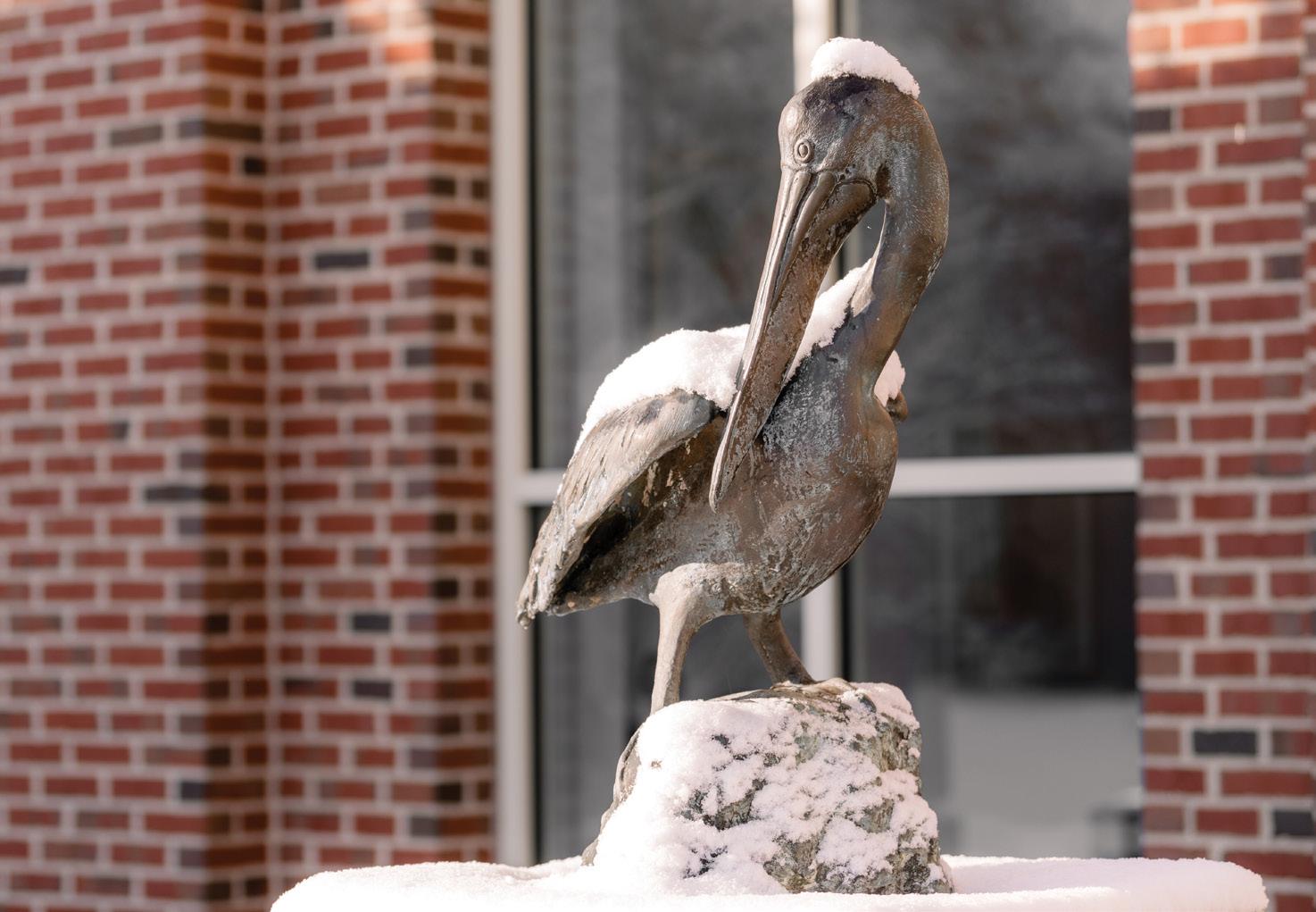
parents, Jane Mackay Howe ’49 and Glover Howe ’48, and grew up alongside her three siblings on the Loomis Chaffee campus. She earned a bachelor’s degree at Mount Holyoke College and then earned a master’s degree in education from Harvard University. In 1978, Cynthia married Murray Dewdney. The couple moved to Meriden, N.H., in 1988, where together they raised two sons, Tyler and Morgan, and enjoyed 32-year careers at Kimball Union Academy. Described by her family as “an educator and mentor to her core,” Cynthia will be long remembered for the sound advice, counsel, and support she gave to her students and colleagues as well as her warm and welcoming presence, her creativity, and her integrity, which have enriched the lives of her family, friends, students, and colleagues. Cynthia was an avid reader, an excellent gardener, a houseplant connoisseur, and a passionate fly-fisher. She crafted a sought-after hot pepper jelly, appreciated a good IPA, and loved the color purple. Cynthia’s favorite pastimes included watching Tyler and Morgan play hockey and soccer. According to the family obituary, “There are quite a few youth hockey players who may recall that being in the penalty box usually also meant a conversation with Ms. Howe. A keen observer of life, her kindness and her wry sense of humor were qualities that Cynthia brought to everything she did.” Predeceased by her father, Glover, she is survived by her mother, Jane; her husband, Murray Dewdney; her sons, Tyler Dewdney ’07 and his wife, Emily, and Morgan Dewdney ’15; her three siblings,
Ken Howe ’77, Robertson “Bob” Howe ’80, and Judith Howe Gobbi ’83, and their spouses; her extended Dewdney family; and many much-loved nieces, nephews, colleagues, students, and friends. A memorial service was held on Saturday, October 1, 2022, at the Meriden Congregational Church. Attendees were encouraged to wear something purple in Cynthia’s remembrance.
1979
Douglas Haigh Cundey, on August 28, 2022, in Bridgewater, N.J. A two-year student from Essex Falls, N.J., Doug was active in swimming, water polo, tennis, and soccer. He received a bachelor’s degree from Denison University in 1983, where he was an All-American member of the men’s varsity swim team for four years and college record-holder in four events. According to the family obituary, “Doug’s love for the water stemmed from the summers the family spent in Mantoloking, N.J., where he was a lifeguard at South Beach during high school and college. He continued his summers at the shore as an adult and spent many years with his own children at South Beach — his favorite place.” Eager to follow in his father’s Wall Street footsteps, Doug began his career in the equity research department at Smith Barney and later went to work at Wertheim Schroder as a stockbroker. He spent the next 30 years picking stocks and forming relationships — the first 20 years as a stockbroker and the last 10 years as an asset manager at Citigroup and Gilford Securities — a career he found greatly satisfying. Doug was “wired happy,” as his brother David often said. Remembered for his positive outlook and upbeat temperament, Doug also forged many long-lasting and loyal friendships throughout his life. A gifted and competitive athlete, Doug excelled in many sports, including golf, tennis, and paddle tennis. He was also an avid runner and a triathlete who participated in many races over the years. A proud and devoted father, Doug took great pleasure in being involved in his children’s lives, encouraging them and supporting them in their passions and pursuits. According to the family obituary, “When either child walked into the room, his expression would change instantly and he would light up with joy as he called out ‘Peaaaa-nut!’ for Alison, and ‘Buddy boooy!’ for Nick.” Predeceased by his brother, Jeff Cundey, Doug was survived by his parents, Haigh and Kie; his two children, Alison and Nicholas; his siblings Kassie Means and
60 Loomis Chaffee Magazine Winter 2023
David Cundey ’85; his former wife, Heather; and several nieces and nephews. A celebration of Doug’s life was held on September 24, 2022, at Bay Head Yacht Club in Bay Head, N.J.
Albert William Lindholm III, on July 6, 2022, unexpectedly, at home in Bristol, Maine. A two-year student from Jericho, Vt., Al was involved in basketball and track. He attended elementary school in Jericho and attended Mount Mansfield High School before coming to Loomis Chaffee. In 1983, Al earned a bachelor’s degree in agricultural engineering from the University of Vermont in Burlington. He was passionate about the outdoors and, according to the family obituary, “loved [lying] out at night to look up at the stars and learn their names. With his childhood friend, Chris Craig, he hiked many of the mountains that were part of the Long Trail in Vermont. He also hiked in New Hampshire and Maine, completing some of the Appalachian Trail and the White Mountains of New Hampshire. He had been a member of the Long Trail Green Mountain Club in Vermont for over 30 years.” After his education, Al worked briefly for Service Merchandise Company and then moved to the Mad River Canoe Company in Waitsfield, Vt. There, his many roles included production associate, assistant production manager, inventory control representative, and kitting department manager before the company was sold to the Confluence Watersports Company in 1998. Under the new ownership, Al became the canoe production supervisor and trainer during the company’s transition in 2000 to Trinity, N.C. In 2002, with severance package in hand, Al headed to Maine and found employment with Mid-Coast Home Improvement in the Damariscotta area. In 2007, Al became a woodworker with Back Cove Yachts (North End Composites) in Rockland, Maine, and worked on every line of yachts built there until his passing. Al found himself at home in the community, including at the local pub, King Eider’s, where he developed a friendship with his favorite bartender that eventually led to a loving partnership. Al met Maureen Seiders in 2008 and welcomed her two sons into his life. The two eventually married on May 28, 2022. He enjoyed being “Grampy Al” to his circle of loving family and friends. Al was survived by his wife, Maureen (Seiders) Lindholm; his parents, Albert Lindholm Jr. ’52 and Myrna Lindholm; his three siblings, Nicholas Lindholm ’82, John E. “Eric” Lindholm, and Alice Hulda “Lee” Manafo; his two stepsons, John M.
Anderson and Matthew C. Anderson; many extended family members; and a large community of friends. No service was planned; however, a stone was to be placed in the Harrington Meeting House Cemetery in Bristol, Maine. A celebration of Al’s life was held on July 24, 2022, at the 1812 Farm in Bristol.
Sarah Jennings Bartram Noyes, on October 10, 2022, in Orange, Conn. A threeyear student from Bloomfield, Conn., Sarah was active in lacrosse. She earned a bachelor’s degree from George Washington University in 1982 and also studied at Lawrence University and the University of Madrid. Sarah began her career in finance and, after raising her children, was a teacher for 10 years at the Orange Congregational Church Nursery School, where her children also attended preschool. Her volunteer work included serving on church boards and at her children’s school, and tax preparation for seniors. According to the family obituary, Sarah cherished spending summers at her family cottage on Seneca Lake in the Finger Lakes of New York. Her favorite pastimes included gardening, hiking, and travel with her husband and family. Sarah was survived by her husband, Jon T. Noyes; her three siblings, Carey Bartram Meltzer ’73, Peter Bartram ’75, and Amy Bartram ’84; her two children, Jacob Bartram Noyes and Abigail Jennings Noyes; and many extended family members. A funeral service was held on October 22, 2022, at Orange Congregational Church.
1988
Alexandra Semple Ness, on July 30, 2022, unexpectedly, at her home in Vero Beach, Fla. A four-year student from Palm Groves Gardens, Fla., Alex was involved in Concert Band and was active in lacrosse, track, and cross country. She was presented at the International Debutante Ball in New York City in 1988. Alex earned a bachelor’s degree in history at Northwestern University, a master’s in business administration at Fordham University, and a master’s degree in journalism at New York University, and she enjoyed a long career in the investment business working for Morgan Stanley, among other firms. Her favorite pastimes included competitive swimming, tennis, and sailing. Alex was survived by her mother and step-father, Pamela Tuttle and David Tuttle; and her grandmother, Patricia Hooper.
Former Faculty
Elaine Title Lowengard ’46, on June 21, 2022, in Farmington, Conn. Elaine was a prominent Chaffee School alumna and a distinguished 20-year Chaffee and Loomis Chaffee faculty member with numerous connections to the school community. Her lifelong association included participation in many Chaffee School alumnae activities, Loomis Chaffee Reunions, Commencement exercises, and a variety of alumni and parents’ events. She was a member of the John Metcalf Taylor Society. Elaine will be long remembered for her dedication to the school’s mission, her integrity, her creative teaching methods, and for challenging her students to take risks in pursuit of their personal growth. Elaine understood first-hand the benefits of travel for broadening one’s perspective, so she created the Chaffee in France and Chaffee in Italy student summer travel programs in the 1960s. She also organized a visit to Greece for Loomis Chaffee alumni in 1975.
A four-year Chaffee School student from West Hartford, Conn., Elaine served as class president for three years, served as president of Chaffers, was a writer and business staff member of Chiel, was cast in theatrical productions, and was on the Dance Committee. Elaine attended Vassar College, Connecticut College, and the University of Zurich, Switzerland, where she was among the first group of foreign exchange students from the United States after World War II. In 1950, she earned a bachelor’s degree from Connecticut College and was inducted into the Phi Beta Kappa Society for her academic excellence. Further academic pursuits for
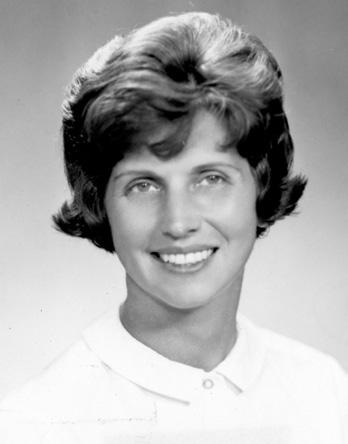
loomischaffee.org 61
Elaine included a brief period in an English graduate program at Radcliff College, a master’s degree in classics at University of Pennsylvania, and master’s degrees in education and Hebrew at University of Massachusetts-Amherst.
While in Switzerland, Elaine began dating Jerome Harry Lowengard, an American exchange student at University of Lausanne, and the two were married in April 1951. After honeymooning in Europe, Elaine and Jerry settled first in Baltimore, Md.; then in New York City; and then in Philadelphia, Pa. After their domestic stint, the couple headed out on a three-month European tour in 1955 — with grandparents caring for their two infant daughters in West Hartford. A year later, they relocated to West Hartford, where, over the next eight years, their four sons were born.
In 1957, Elaine started teaching ancient and medieval history at The Chaffee School, and she continued teaching there for 20 years through the school’s transition to Loomis Chaffee. In the process, she added courses in politics, Latin, and a variety of elective courses; served as chairman of the Classics Department and the Humanities Program; and was the faculty representative to the Board of Trustees for a three-year term. Betty Sudarsky ’69 and Martha Ritter ’66 shared their reflections of being students in Elaine’s class. “She was such a superstar. In the fall of 1965, [Elaine] was my ancient history teacher. With her we read The Odyssey which felt like work at the time, but for which I’m so grateful. … We will miss her wisdom, her spirit and her compass,” wrote Betty in a note to Elaine’s family.
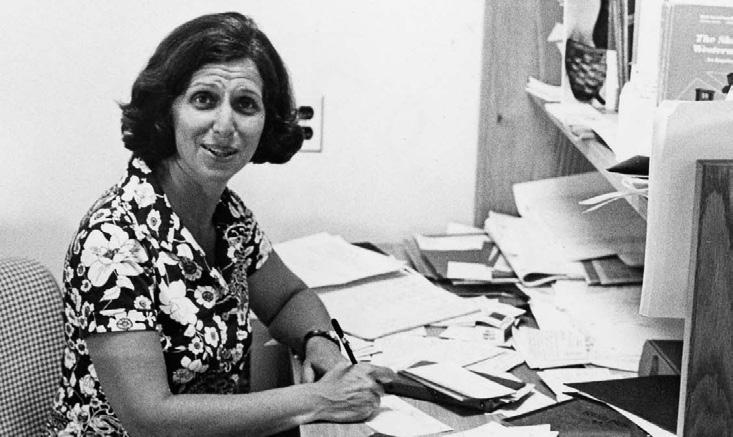
According to Martha, “Elaine Lowengard was the perfect guide to ancient history. She stood in the front of the room and talked about Alexander or Caesar as though they lived in the neighborhood. She easily erased the daylight between us and the stalwarts of antiquity with her enticing stories and asides — eyebrow raised, beaming.” Elaine’s son, Henry Lowengard ’74, whom she also taught, noted, “As a faculty brat, there were plenty of times I saw my mother in action at Loomis Chaffee … I was also in the unique situation of taking one of her classes, ‘1956–1974,’ an exercise in history research to find historical parallels between our birth years and ‘today.’ This elective gave us the chance to scroll though the microfilm reels and old Life magazines just like real researchers.” Henry’s older sister, Mary Lowengard ’71, remarked, “What I remember was my mother ruminating and fretting because she said she had to give Henry a well-deserved ‘H’ (for Honors) in the class!”
Elaine left the Island in 1977 and spent two years as director of the Westledge School in Simsbury, Conn., before embarking on a new career at Connecticut Bank and Trust, where she served as director of corporate communications and later as vice president in charge of the bank’s local and statewide nonprofit lending business. In 1989, after retiring from the bank, Elaine served as executive director of the Connecticut Valley Girl Scout Council. In addition to working full time and raising her family, Elaine committed time to many civic, cultural, religious, and political activities, and she was a fierce advocate of many causes. Elaine and her husband co-chaired West Hartford’s Bicentennial Committee in the 1970s, and she
ran for office while she was a longtime member of the Democratic Town Committee. A regular panelist on the Comment community program of WFSB Channel 3, Elaine also held multiple trustee positions, including the Connecticut Teacher’s Retirement Board, St. Joseph College, Watkinson Prisoner’s Aid Society, and The Institute for Living. Elaine was instrumental in bringing new life to the original building of her family’s religious community through her part in the founding of the Charter Oak Temple Restoration Association (now the Charter Oak Cultural Center.) In the 1990s Elaine served as a corporator of St. Francis Hospital and the Hartford Seminary Foundation, as a member of the Board of Directors for Advest Bank and Trust Company and the Center for Theater Techniques in Education, and on committees at Temple Beth Israel. A lover of the arts, Elaine was a regular patron of the Hartford Symphony, the Hartford Stage Company, TheaterWorks, and Goodspeed Opera House.
Elaine never lost the love for travel that was first inspired by her student exchange in Switzerland. In addition to the tours she led for Loomis Chaffee, Elaine enjoyed leading her children, grandchildren, and extended family members on travel adventures to such destinations as Russia, Eastern Europe, England, France, Spain, Italy, Egypt, and Israel. Following the death of her husband in 2002, Elaine returned to Israel alone, explored Africa, and traveled to the couple’s beloved city of Florence, Italy, where she and several of her children spread his ashes. Nantucket Island was another place special to Elaine, and for 25 years she and Jerry entertained family and friends during the summer at their Nantucket home. A two-time cancer survivor, Elaine bravely endured many surgeries and chemotherapy treatments — first in 1960 for thyroid cancer and then in 2016 for ovarian cancer. After inheriting her grandparents’ West Hartford home in 1963, Elaine and her family renovated the 1920s Georgian-style house, and she lived there for the next 45 years — departing, reluctantly, at age 89, when she was diagnosed with a vascular dementia syndrome. Despite this ailment, according to the family’s obituary, Elaine “held onto her keen wit, sharp intellect, graciousness, and uproarious sense of humor until nearly the very last of her days.”
62 Loomis Chaffee Magazine Winter 2023
Preceded in death by her husband, Jerry, and her brother, Samuel Title ’43, Elaine was survived by her six children, Mary Lowengard ’71, Sarah Lowengard ’72, Henry Lowengard ’74, Benjamin Lowengard, Alexander Lowengard, and Jeremiah Lowengard, and their spouses; her six grandchildren, including Pleasance Silicki ’96; her three great-grandchildren; Samuel’s three children, including David Title ’75; and many extended family members. A graveside service was held June 26, 2022, at the Congregation Beth Israel Cemetery in Hartford.
Karl G. Schweiger, on June 27, 2022, peacefully, in Hartford, Conn. Karl graduated from Conard High School in 1964 and enlisted in the U.S. Air Force Reserves, where he served for two years. In late 1966, he was employed by the town of West Hartford and remained there until his retirement in 1998. A talented tennis player, Karl joined the Newington Tennis Club in the early 1980s and competed in many events. He later became a private tennis instructor at the Newington Tennis Center. In retirement, Karl coached girls tennis for a number of years at Loomis Chaffee and Newington High School. He was survived by his two children, Jeffrey Schweiger and Jill Schweiger; his grandson; and many extended family members and friends. A graveside service was held on July 8, 2022, at Indian Hill Cemetery in Middletown, Conn.
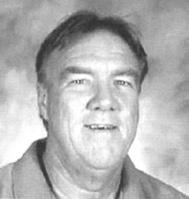
Ursula Uhlig, on June 8, 2022, at home in Athens, Ga. Born in Erfurt, Germany, Ursula began school in Berlin and graduated from high school in Stuttgart in 1950. While studying at the University of Tubingen, she met her husband, Ludwig Uhlig. In 1966, the Uhligs came to the United States, and Ursula taught German at Loomis Chaffee from 1973 until 1984. During that time, she earned a master’s degree from Middlebury College in Vermont. In 1984, Ursula and her husband moved to Athens, Ga., where they were both employed at the University of Georgia. They loved classical music and supported and frequently attended concerts at the University of Georgia Performing Arts Center. According to the family obituary, Ursula and Ludwig became proud U.S. citizens at the earliest opportunity after dual German/U.S. citizenship became available.
Preceded in death by Ludwig, her husband of 61 years, and her sister Christa Becker, Ursula was survived by her sister Brigitte Becker Briegleb and extended family members. A memorial service was held on July 11, 2022, at Oconee Hill Cemetery in Athens, Ga.
Former Staff
Jamie Gardner Vernon, on June 25, 2022, peacefully, in Windsor, Conn. Married to former faculty member Charles “Chuck” Vernon, Jamie was part of the Loomis Chaffee community for many years — living on campus for a time when her children were very young and working on and off for about 20 years in various roles, including as a Latin tutor, typing teacher, and library assistant. Jamie grew up in Pennsylvania and was a 1964 graduate of Cheltenham High School. After high school, Jamie earned a bachelor’s degree at Mount Holyoke College. In August of 1968, Jamie and Chuck began their married life together. Jamie spent two years working in the Actuarial Department with Travelers Insurance Company. When her children grew older, Jamie began working
as a tax preparer for H&R Block in Manchester, Conn., and she remained there for 25 years until retiring in 2010. Upon retirement, Jamie devoted her time to volunteering in the community — helping people prepare their taxes free of charge at the Hartford Community Renewal Team and helping families in need to request government assistance through the Supplemental Nutrition Assistance Program. Her volunteer work came to an abrupt halt due to the pandemic in 2020, but Jamie continued to serve as treasurer of the Windsor League of Women Voters, as she had for decades. A 40-year member of the First Congregational Church in Windsor, she served with the church’s financial group for many years. According to the family obituary, Jamie long enjoyed socializing with her close-knit, extended family and she especially cherished spending time with her loving husband of 53 years and their children and grandchildren. In 2000, with support from her family and friends, Jamie overcame a huge obstacle and conquered breast cancer. Throughout her life, Jamie remained close with her fellow parishioners at First Church and her many friends within the Loomis Chaffee community, whom she regarded as family. In her spare time, Jamie loved hosting social events and gatherings during the summer months at the Vernon household on the New Jersey shore. She will be long remembered for preparing “amazing” dishes and enjoying the experience of having everyone together and the associated good times. In addition to Chuck, Jamie was survived by her two children, Jill Salinardi and her fiancé, Todd Lang; and Andrew Vernon ’91 and his wife, Adrianne; her four grandchildren; and many extended family members and great friends. Jamie was predeceased by her brother, William Gardner. A memorial service was celebrated on July 28, 2022, at the First Church in Windsor.
More News
The Alumni Office has learned of the passing of Marianne Morrell Schumann ’50 on April 24, 2022; Castle Day ’51 on October 27, 2022; Philip Bushby ’67 on October 28, 2022; Christopher Causland Cooke ’68 on September 27, 2022; Ellen Kennedy on November 14, 2022; and former staff member Gloria Hutchins on November 4, 2022. More information, as available, will be printed in future editions.
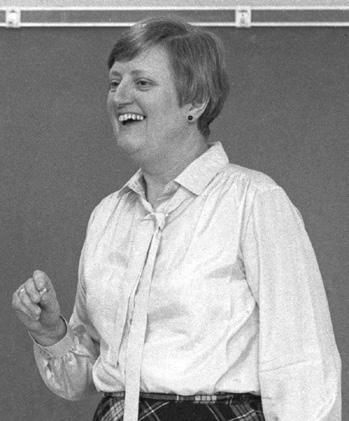

loomischaffee.org 63
NOW u
The Changing Faces of Hamlet

“Alas, poor Yorick. I knew him, Horatio.” So says Shakespeare’s Hamlet, holding the skull of the former court jester and considering the impermanence of life. Hamlet has been produced multiple times in the Norris Ely Orchard Theater, most recently this fall, with senior Jade Silverstein (far right) in the title role. Among others who have played this challenging role in the NEO are Becky Hincks ’77, Chris Mattei ’96, and Betty Gilpin ’04 (near right). Becky later became an associate professor of English at KTH Royal Institute of Technology in Sweden, teaching scientific writing, public speaking, and communication skills and conducting research in the field. Chris is a Connecticut trial lawyer and recently was the lead counsel representing Sandy Hook families and first responders in their lawsuit against conspiracy theorist Alex Jones; the jury awarded a $1 billion judgment against Mr. Jones and the parent company of his Infowars website. Betty is an Emmy-nominated actress best known for her roles as Debbie Eagan in the Netflix series GLOW and Carrie Roman in the Showtime series Nurse Jackie. Her memoir, All the Women in My Brain, was published by Flatiron Books in September.
Alas, poor Yorick! I knew him, Horatio: a fellow of infinite jest, of most excellent fancy: he hath borne me on his back a thousand times; and now, how abhorred in my imagination it is! my gorge rims at it. Here hung those lips that I have kissed I know not how oft. Where be your gibes now? your gambols? your songs? your flashes of merriment, that were wont to set the table on a roar? Not one now, to mock your own grinning? quite chap-fallen. Now get you to my lady’s chamber, and tell her, let her paint an inch thick, to this favour she must come; make her laugh at that.
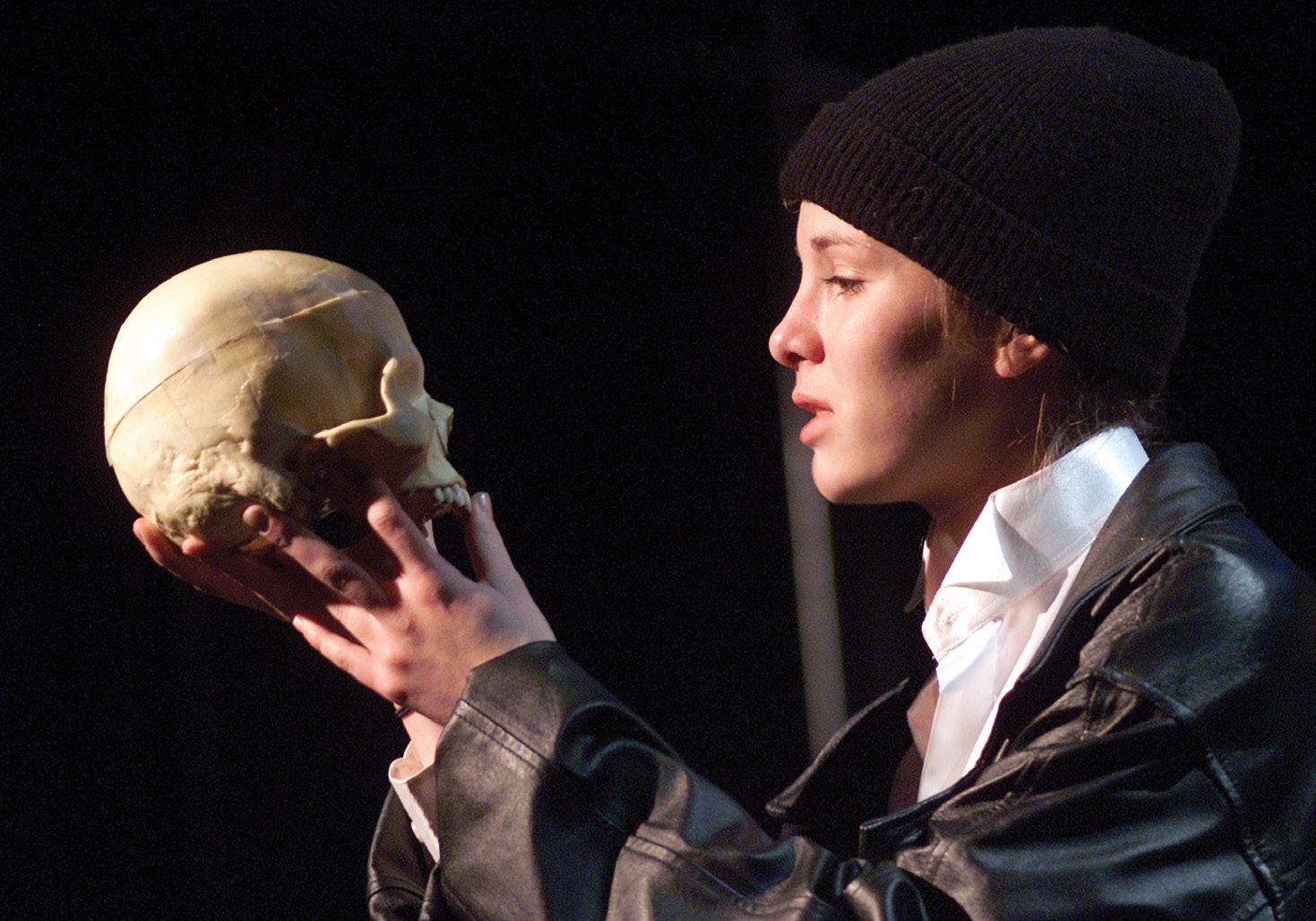
THEN q
64 Loomis Chaffee Magazine Winter 2023
REFLECTIONS

CHANGE SERVICE REQUESTED
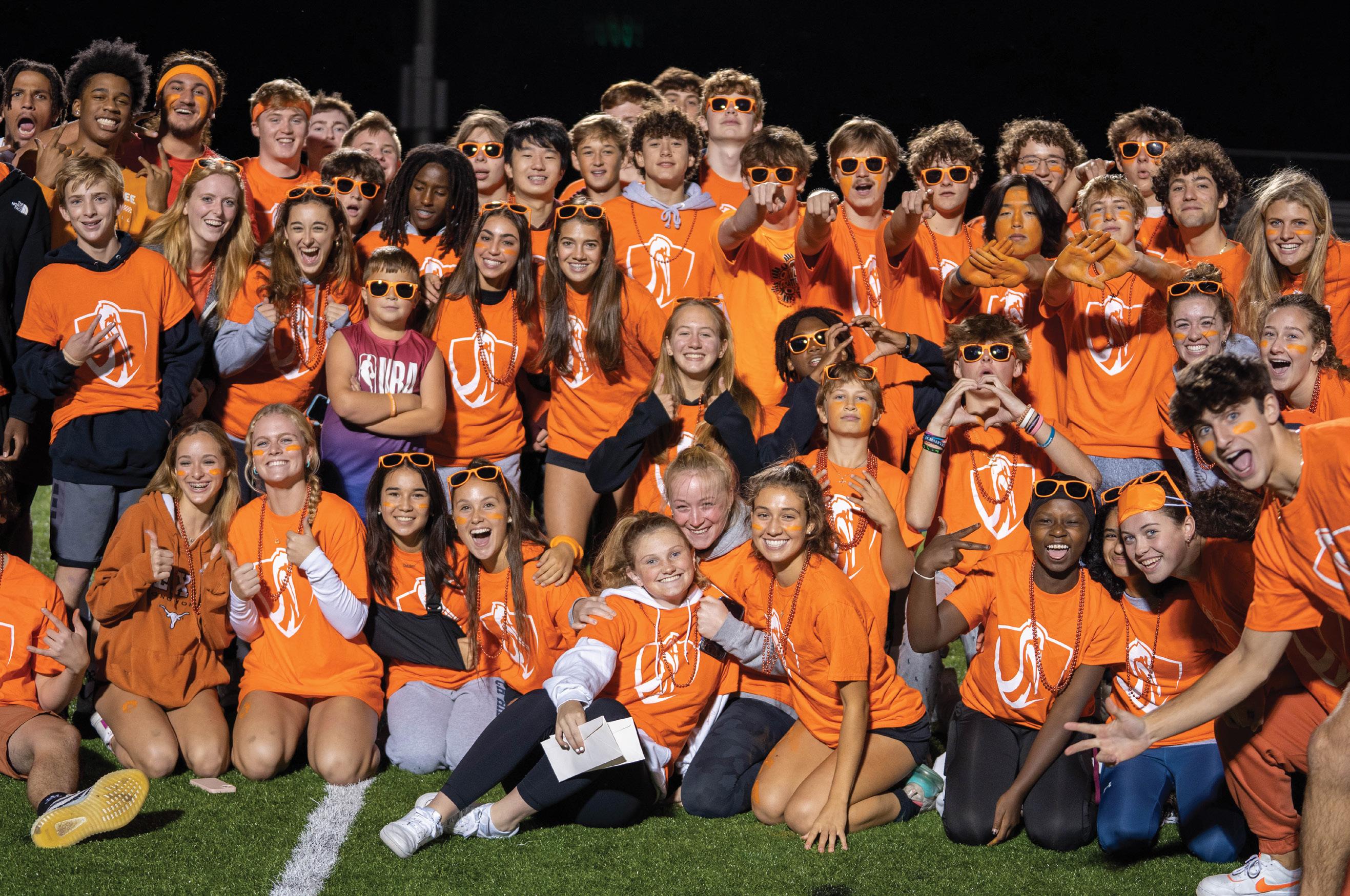
Nonprofit Org. U.S. Postage PAID
School
Loomis Chaffee
The Loomis Chaffee School
4 Batchelder Road
Windsor, Connecticut 06095
The exuberant Orange team at the October 2022 edition of the Pelican Games

 Cow Pond on a fall evening
Photo by junior Emily Tang
Cow Pond on a fall evening
Photo by junior Emily Tang





































 Opposite Page: The Players (freshman Sonia Barinskaya, junior Brigham Cooper, freshman Natalie Pereira, and freshman Zane Habig) perform for the court. Above (Clockwise): Director David McCamish and Arthur prepare special effects for the death scene. • Junior Cameron Rogers monitors the cues in the prompt book. • The NEO stage before the show. • In the booth, stage managers junior Sophia Li and Cameron and stage crew members sophomore Boden Bubb and junior Lily Clark run a tech rehearsal. Below: View from the booth of the curtain call during dress rehearsal
Opposite Page: The Players (freshman Sonia Barinskaya, junior Brigham Cooper, freshman Natalie Pereira, and freshman Zane Habig) perform for the court. Above (Clockwise): Director David McCamish and Arthur prepare special effects for the death scene. • Junior Cameron Rogers monitors the cues in the prompt book. • The NEO stage before the show. • In the booth, stage managers junior Sophia Li and Cameron and stage crew members sophomore Boden Bubb and junior Lily Clark run a tech rehearsal. Below: View from the booth of the curtain call during dress rehearsal






























































 by Mary Coleman Forrester
by Mary Coleman Forrester









 —
—



 MARK ZUNINO
MARK ZUNINO




 By Karen Parsons, Loomis Chaffee History Teacher & School Archivist
By Karen Parsons, Loomis Chaffee History Teacher & School Archivist



































